This is the website of Abulsme Noibatno Itramne (also known as Sam Minter).
Posts here are rare these days. For current stuff, follow me on Mastodon
|
The Electoral College voted on Monday December 19th. There were faithless electors this year, so the final results differed from the “earned” results reported in my “Final Forecast and Election Night Updates” post.
Despite the hopes of groups like the Hamilton Electors, the number of Republican faithless electors was nowhere near the 37 that would have been needed to send the election to the House. Only 2 Republican electors actually abandoned Trump. In fact, not only was the goal of stopping Trump not achieved, but the efforts backfired completely. In the end there were more Democratic defectors than Republican defectors, so Trump’s margin actually increased from a 74 electoral vote win to a 77 electoral vote win. Not quite what those campaigning for electors to vote independently were hoping for.
Lets look at the details of the final counts.
The last state called was Michigan on November 28th. The “earned” electoral vote based on the states won and lost at that point was:
- Donald Trump 306
- Hillary Clinton 232
When the electoral college voted, there were 7 faithless electors. 5 of these were Democratic and 2 were Republican. This was the largest number of faithless electors since 1872 when 63 electors pledged to Horace Greeley did not vote for him… because he had died between the November election and the December electoral college vote. Not counting 1872, since perhaps one shouldn’t count not voting for a dead candidate, this was the largest number of faithless electors ever.
The 7 faithless electors voted for a variety of different candidates, making the official totals:
- Donald Trump 304
- Hillary Clinton 227
- Colin Powell 3
- John Kasich 1
- Ron Paul 1
- Bernie Sanders 1
- Faith Spotted Eagle 1
An additional 3 Democratic electors attempted to be faithless, but were thwarted by state laws and procedures in Maine, Minnesota, and Colorado. It is possible some or all 3 of these electors may end up filing lawsuits over this. If lawsuits actually happen and are all successful (which we obviously can not say at this point), Clinton would lose 3 additional electoral votes, Sanders would gain 2, and Kasich would gain 1. If this were to happen, Trump’s winning margin would increase further to 80 electoral votes.
Normally, we think of the Vice Presidential race as locked with the Presidential race as part of “tickets”, but in fact as far as the electoral college is concerned, these are actually two separate votes, and the faithless electors also split their choices for Vice President. The Vice Presidential results were:
- Mike Pence 305
- Tim Kaine 227
- Elizabeth Warren 2
- Maria Cantwell 1
- Susan Collins 1
- Carly Fiorina 1
- Winona LaDuke 1
And with that, absent any minor adjustments from potential lawsuits by the three foiled Democratic faithless electors, or Congress doing something unexpected on January 6th, the 2016 electoral results are set.
Donald Trump wins.

Photo by Michael Vadon [CC BY-SA 2.0], via Wikimedia Commons
It took almost 20 days, but the last state, Michigan, was finally called for Trump on Monday November 28th.
The final results of Election 2016 are now known:
Clinton 232 Trump 306, a 74 electoral vote win for Trump.
(That is absent faithless electors or something completely unexpected coming out of recounts of course.)
(UPDATE 2016-12-20 19:27 UTC: The electoral college has actually voted, and there were 7 faithless electors. The final count was Trump 304, Clinton 227, Others 7. This is a 77 electoral vote margin for Trump. For details, see my post titled “The Actual Presidential Vote“.)
This site’s final update predicted that the result would be somewhere between a 210 electoral vote win for Clinton and a 66 electoral vote win for Trump, with the “expected” result being an 8 electoral vote win for Clinton.
Obviously I was wrong. Not just on the winner, but the result didn’t even come in within the “range of the reasonably possible” that I listed. A range which had seemed overly broad before the election. A 66 electoral vote win for Trump (or a 210 electoral vote win for Clinton) seemed like a complete fantasy. Yet Trump exceeded that margin.
Having said that, the “expected result” was actually closer than almost all electoral vote trackers out there. So I actually did about as well as could have been done given the raw data that was available. So the raw output of my model on Election Graphs was pretty good. Perhaps I could have picked a bit wider window for the “swing” states than 5%, but 5% was generally reasonable. Although of course I wish I had gotten everything exactly right like I did in 2012, I am happy with how my model performed. I may make tweaks for 2020, but I will not dramatically change what I do with the model itself in 2020.
I do fault myself however for some of how I interpreted that data in my analysis posts, most critically I concentrated too much on the “Expected Case” and the “Tipping Point” metrics, and not enough on the full range of variation between the best cases. Like most electoral college trackers, this led me to minimize the chances of Trump’s win because “he has never led the race and isn’t ahead now” while essentially ignoring the fact that while that was true, he spent most of the last 100 days close enough that a systematic polling error or significant movement in the last few days could erase Clinton’s lead. Both seem to have happened. My model was spitting out the “Trump Best Case” the whole time, but for the most part, I downplayed the best cases. That was a mistake.
Lets dig in and look at the details.
Warning in advance, the remainder of this post is likely only to be of interest to “data geek” type folks. If that isn’t you, feel free to stop now… or just skip down to the “thank you” section at the end. If you are the data geek type, dive in with me to a lengthy discussion of the details and what lessons they may provide for 2020.
If you prefer listening to reading, or just want to hear about this in another way, I also discussed much of what I am now including in the post mortem in the November 11th episode of the Curmudgeon’s Corner podcast.
How did I do state by state?
In terms of individual states (and congressional districts), I of course did not match my 2012 record of getting 56 right out of 56. I ended up getting 5 wrong:
- Expected Strong Clinton: Wisconsin went for Trump instead of Clinton
- Expected Weak Clinton: Michigan went for Trump instead of Clinton
- Expected Weak Clinton: Maine CD2 went for Trump instead of Clinton
- Expected Weak Clinton: Pennsylvania went for Trump instead of Clinton
- Expected Weak Trump: Nevada went for Clinton instead of Trump
So there were 4 places where I erred toward Clinton and 1 where I erred toward Trump.
Of these, four were in the “weak” category, with margins in my averages of 2.6% or less. They were in my too close to call categories, and while I would have liked to have gotten more right, my model did indeed say they could easily go either way.
The only big surprise here was Wisconsin. The polling average had Clinton up by 7.1%, but Trump won anyway. There is nothing to say there other than the polling was way off in Wisconsin. Way off. I’m sure much will be written about why that was the case.
A state that I hadn’t even classified as a swing state going the opposite direction as expected is obviously how the final result was able to end up completely outside of the expected range. Wisconsin going for Trump was simply not contemplated. All the other states that went for Trump were within the range of options this site identified as plausible.
Of course, there were other states that I did not get wrong, but the margin was still off by more than expected. That is a different kind of analysis that I won’t do today.
How did I do on the overall result?
Looking at the over all electoral college result, lets compare with where some of the other sites had the race at the end:
First of all, I guess I am permitted to toot my own horn a bit. While I did not predict a Clinton victory, I came closer to the final result than all but one of the outlets above. That is something, right?
TOOT TOOT TOOT
That over with, I was still quite a ways off.
I should also point out that the above is ONLY due to changes added with polls that came out on the day before election day. My very last update on election day itself had the 8 EV Clinton margin. But the update before that, on Sunday, had me at 108 electoral votes, right there with so many others. Indeed, because I had been in broad agreement with so many other outlets, and my final update caused me to deviate quite a bit, I included caveats in my last update basically saying I didn’t believe it, there were probably outliers impacting the data, and my Sunday numbers were probably better.
Which brings me to the lessons of this post mortem…
Lessons
Trust my own method and data
Now, frankly, the swing on the last day may well have just been dumb luck. Random noise happening to go in the right direction. But it also could have been an indicator of the actual movement. Right or wrong, given I had been using a fixed methodology all election season, I should have stuck with it fully. After the election, if I was wrong, I could and should use that to learn for the next election cycle. But I started making excuses because I was not matching all the other election trackers. I should not have done this, I should have taken the results I was seeing seriously, and should have based my commentary on that.
My final update had an 8 EV Clinton win with a tipping point of only 1.6% in Pennsylvania. Only that one single state needed to flip in order for Trump to win. My final update did mention that Trump had made it tight again. I summed it up like this:
Maine CD2, Pennsylvania, Nevada, North Carolina, Florida, and Iowa are all within 2% at the moment. They could still go either way based on the current averages. That is enough to swing the election.
So, as has been the case for awhile, a Trump win would be surprising, but should not be shocking. Trump has a path.
Without looking at all the other forecasts and making excuses for why I was different, this should have read more like:
Maine CD2, Pennsylvania, Nevada, North Carolina, Florida, and Iowa are all within 2% at the moment. They could still go either way based on the current averages. That is enough to swing the election. Even more states are within 5%, and they could easily flip as well.
The tipping point is only 1.6% in Pennsylvania. Clinton’s lead in Michigan is also only 2.6%. A small last minute surge too late to be caught in polls, or a small polling error, could easily flip either or both of these states, and thus the election.
Clinton is ahead, she is the expected winner, but since early October things have been trending toward Trump, with only a brief interruption after the third debate and before the Comey letter.
The race is now very close. While Clinton is still favored, the bottom line is there is a reasonable chance this could go either way.
But I did not say that. And the reason was primarily because in that final update, I looked like an outlier, and I therefore didn’t believe what my own model said, specifically in terms of just how close it really was.
Which brings us to the next lesson.
Trust the Uncertainty
For the three election cycles I have done this, I have used a 5% margin as the boundary for what I call the “weak states”. States that you should consider to be too close to call and which could go either way. When justifying this, I have always said something like this:
Obviously 5% is an arbitrary number, which conveniently is a nice round number too, but between possible polling error, and possible last minute swings that happen to close to election day to be reflected in polls, 5% seems reasonable. A 5% last minute swing in response to news events is a bit large, but perfectly possible. Similarly a 5% polling error is a bit large, but possible. And my model only looks at the margin between the two major candidates, it does not explicitly account for the group of undecided voters, they could also possibly swing a result by that much in some cases. 5% seems as good a place to draw this line as any.
While having some sort of empirical way to define this line may be preferable, this election has shown that 5% is indeed pretty reasonable, and there are arguments that it should be even larger. (See Wisconsin again, which Trump won while my average had Clinton ahead by more than 7%.)
With that in mind, lets look at the two main graphs the site provides once again:
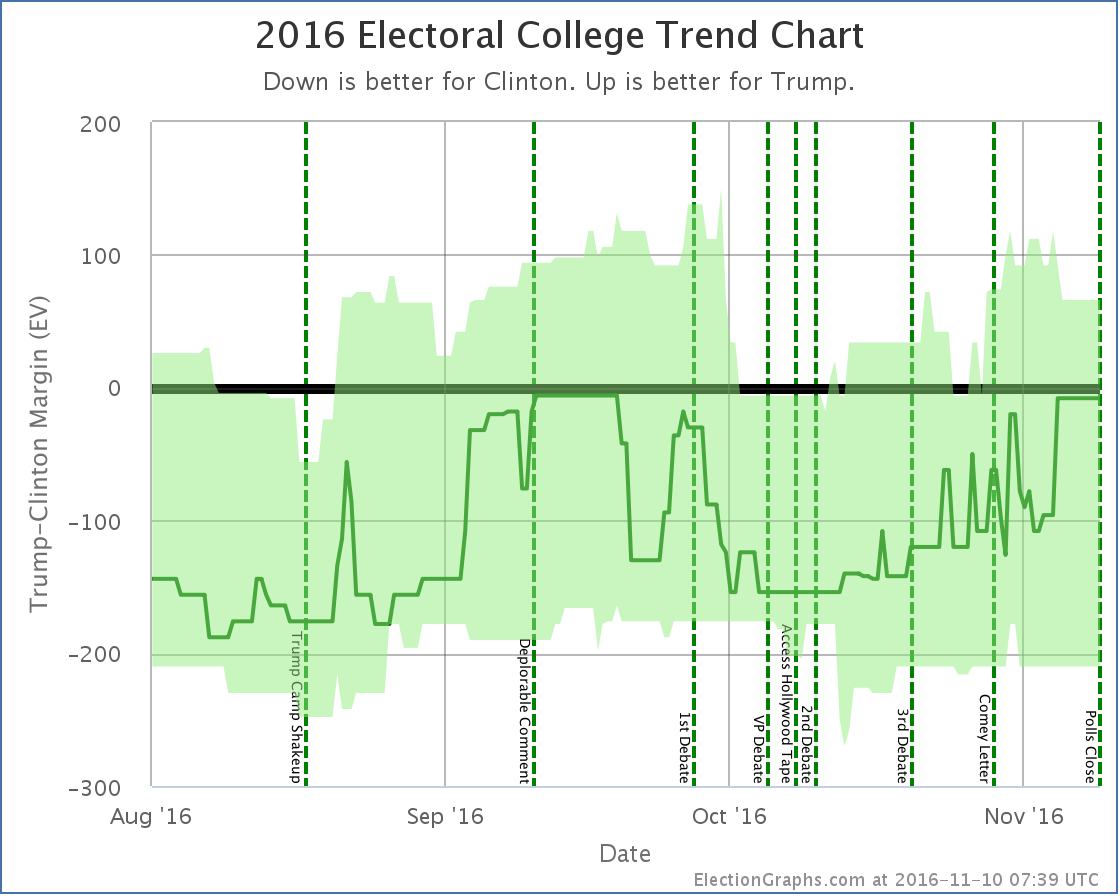
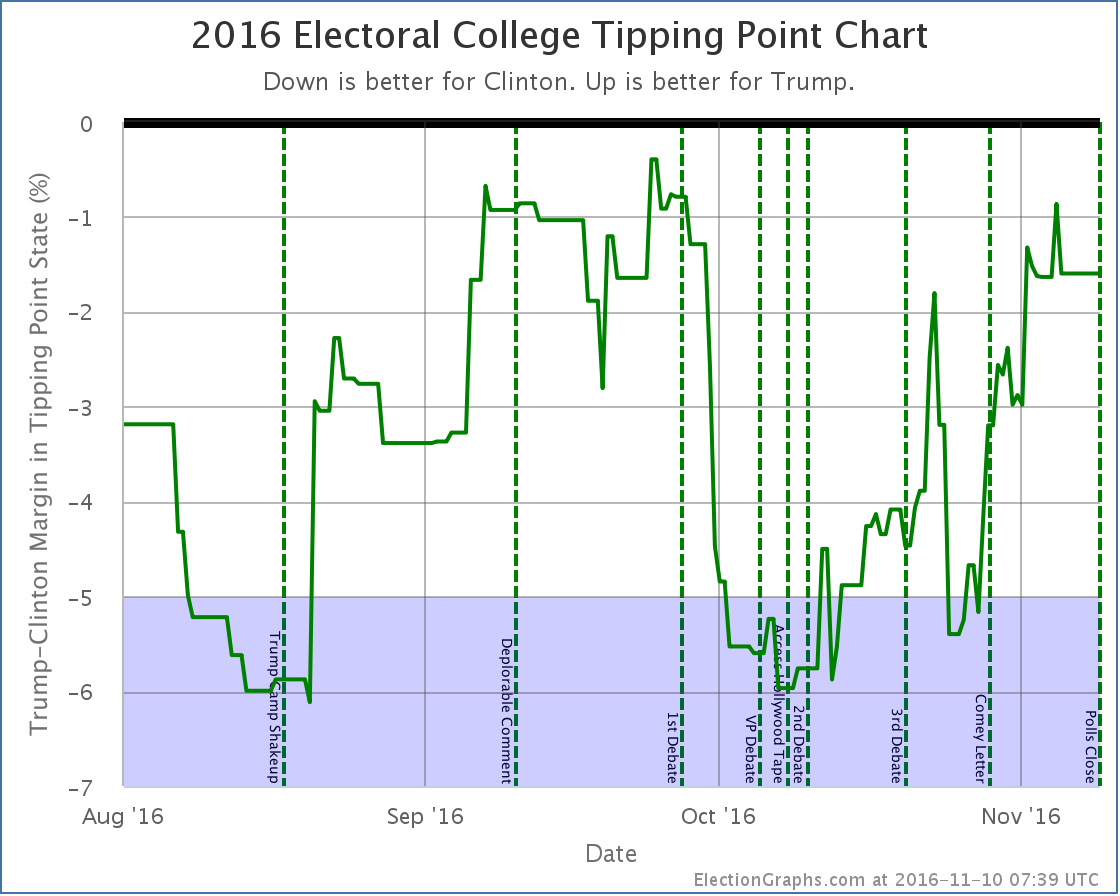
For almost all of the last 100 days of the race, we were in the “could go either way” zone. The exceptions were short periods in August, right around the Access Hollywood tape release, and right before the Comey letter. The rest of the time we had a close race.
Yes, Clinton was ahead the whole time. Yes, Trump had never actually led in my model. But we were within my own self-defined “this is close enough we can’t trust this” margin. This was a close race. And yes, there was a “ceiling” for Trump, but that ceiling was within the margin of error for this kind of model.
I let myself think mostly about the center line of the model, and not as much about the “best cases”. At least toward the end of the campaign cycle. I had convinced myself based on looking at other people’s models that my best cases were probably too extreme. Perhaps useful 6 months out to reflect how much things could change over many months, but certainly too wide in the last couple of weeks or days.
But even if I’d set my thresholds at 2% instead of 5%, my last couple of updates would have shown it too close to call. At 3% it would have been my last three updates. This was close by my own definition of close, and my updates minimized that. They should not have.
And Trump was surging, which brings me to my next lesson:
Don’t call the end of trends too soon
On the Sunday before the election my post was titled “Trump Surge Sputtering Out?“. While the next update did indicate Trump had made the race close again, that was the post full of caveats about how I didn’t really believe the data.
The “looks like Trump has topped out” call was indeed premature. There was indeed mixed data. Clinton was improving on some metrics. But all within the realm that could have been noise. The overall trend was still toward Trump. There was no definitive reversal at that point, as the very next update showed, or would have if I had trusted my own data. If I had, I would have said that last update showed that the trend toward Trump had continued, and had made the race once again very close.
The actual flow of the last 100 days seem really to only have a few phases:
- Before the August Trump campaign shakeup, Trump was in a steady decline
- After the August shakeup, Trump maintained discipline and made it very close by late September (or possibly he was leading if the same polling errors that existed at the end of the race were present then too).
- The first debate caused Trump to crater. Clinton’s margin grew rapidly.
- Trump started recovering almost exactly when the Access Hollywood tapes came out. Far from hurting him, the media pile on about how this was probably the end of Trump’s campaign seems if anything to have rallied people to him.
- After the third debate, there is evidence that people were starting to move away from Trump again, his “best case” was once again a loss. But this didn’t last long.
- After the Comey letter the movement toward Trump (or away from Clinton) resumed. This trend continued up until the last pre-election polls.
In between those there was a bunch of movement, and I pointed out some of them as trends. Many were noise. When you are looking at a jaggy signal full of noise, it is hard to determine where to start saying something is a real trend rather than random movement. Maybe even the trends I called out above are illusions. But it is clear I should have been more conservative in calling out trends before they were dramatic enough to know with a decent amount of certainty that they were not just noise.
Don’t assume trends will continue either
Near the bottom of the trend that started with the 1st debate and ended with the Access Hollywood tape I said this on October 14th:
There is no time left for a Trump comeback from behind win from these levels. It would take something massive that would completely reverse everything we know about this race so far. It would be an unprecedented reversal. Impossible? No. Incredibly unlikely? Yes.
A few weeks ago Trump had managed to make this race close. But it was short-lived. Starting with the debate he has been dropping steadily. We don’t yet have signs that we have hit bottom either. There have been new negative stories about Trump almost every day. Further drops would not be surprising.
We’re no longer really talking about who will win this election. Clinton will win this election. The only question is by how much.
Now, it WAS the biggest comeback in the history of American presidential races in terms of how different the outcome was compared to polling at that time given how little time was left. And I had caveats that it wasn’t impossible. But still, that last paragraph completely dismissing the possibility of a Trump comeback was flat out wrong. It was clearly putting way too much stock in the trend at that moment, and not taking into consideration how little it would take to put Trump’s best case back into the win column.
Indeed, at the time of the comment we’d just seen polls move just about 6% in Clinton’s direction in just a couple of weeks, showing that rapid movement in the polls was very possible. There was plenty of volatility. Plenty of room for movement. A 6% move in the opposite direction in the 26 remaining days should not have been dismissed out of hand.
Save the “it is over” comments until it is actually over. Things can change a lot in just a small amount of time if the right things happen in the course of a campaign. And they did.
Other lessons
I think those were the main lessons, but there were a few others too that will also inform my choices going forward for 2020.
- Showing polls at their mid-point: This cycle I used the midpoint of the time in the field of polls for both determining which polls to include in an average, and showing them on the state detail graphs. This means that if there is a change caused by a news event, the change should be CENTERED on the event rather than START at the event. It means that the movement caused by an event often starts on the chart prior to the event itself. How much so depends on the lengths of the polls that were in the field at the time. Although there are good reasons I thought this was better, it ended up being confusing, even for me. Several times during the cycle I said things like “but this change started before event X”. Some of those (but not all) were just me misreading the graph because of this confusion. Putting all polls at their end date would ensure that any influence from an event would always only show on the part of the charts after that event. (There are down sides to this as well, but it might be better on balance.)
- Third Parties: Although he faded in the last weeks, for awhile McMullin was getting lots of individual polls showing him in 2nd place, or even 1st place in Utah. Johnson came in 2nd in two other individual polls in some states earlier in the cycle as well. The way my site is currently structured, it does not deal properly with 3rd party candidates who are actually doing strongly enough to have a shot at 2nd place or better. I had a high level plan in my head (but nowhere else) for how to revamp my site to deal with this situation, but by the time McMullin surged it was too late to implement it. This may or may not end up mattering in 2020, but I should adjust the site so it can handle these situations from the beginning, so if it does arise, I don’t end up scrambling to deal with it.
- Concentration on the margin: Everything on Election Graphs presents things in terms of the Republican minus Democrat margin. Not only does this break down in the 3rd party case mentioned above, but it also fails to give any way to represent how big the undecided group is and how that might matter. It also can’t differentiate between one candidate gaining, and the other losing ground. Both show up similarly in the margin, but the interpretation for what is happening in the race is different. I think the margin view is very useful, but there is a need to also see the lines for the individual candidates, so I should consider showing that as well.
- Outliers: There were persistent outliers from some pollsters. The case that comes most easily to mind is Google Consumer Surveys persistently saying that Clinton had not just a lead but a big lead… in Kansas. This was ridiculous, and luckily most of the time there were enough other polls in Kansas to keep me from constantly saying Kansas was a possible Clinton pick up. I only said that a couple times, and each time I noted that I didn’t believe it. But it always made Kansas look closer than it really was. Even without the Kansas case, outliers introduced volatility where there wasn’t any in a variety of states, or pushed the average in one direction or another. I need a better way to minimize the impact of outliers. There are a variety of options. I should look into them.
- Poll Selection: There were a number of cases over the course of the year where there were polls of dubious quality. There was also sometimes a question of “is this a poll, or is it a model?”. Or if a pollster was releasing results selectively to favor one side or the other. This site’s bias is to include as much as possible, so I included almost everything. Next time, I need to have clear written guidelines in advance of what gets included and what does not, and I need to stick to it.
- Tracking Polls: Because I base my averages (usually) on “the last five polls” once certain outlets started releasing polls daily, they have the power to completely take over the averages, especially in lesser polled states. This time around I countered this by including only one poll per week from these tracking polls. This solution is not ideal though, as I am clearly ignoring data that might be useful. I need to come up with a solution that can properly deal with tracking polls, incorporating the data they provide, while not improperly weighting them vs the one off polls.
- Data acquisition: My data acquisition process is manual and quite time consuming. It is exhausting physically. I actually kind of enjoy it, but the raw amount of time it consumes, especially in the last few weeks before the election, are disruptive to the rest of my life and unsustainable. It was hard to keep up. Especially with the proliferation of 50 state polls toward the end. At times I was extremely frustrated when I knew certain polls were released, but I didn’t get them incorporated for a day or two, on occasion even three days. I want to be as up to date as possible, and that requires more automation. I have been reluctant to cede control over poll selection by relying exclusively on the data feeds from one of the big poll trackers that provide an API, but I may have no other option for 2020. (Also, at least for 2016, it seemed that I was up and running with my 2016 poll tracking months before those other trackers had 2016 listings up on their sites, although maybe their APIs were already returning the raw data, I don’t know.)
- What to include in average: I like the simplicity of “last five polls” (even with the exceptions I carve out for that). But there is an argument that in the early parts of a campaign it includes too much, and in the latter parts too little. Five polls leaves a lot of room for a single poll to have a big influence. In addition to poll selection questions noted above, the question of how to construct the average itself matters. 5 polls? 10 polls? Some sort of weighting that decays over time? For any day just show the average based on polls actually in the field that day? (You’d still need logic to give a value when no polls were in the field.) If I open the door to weighting the polls, do I weight on other things? Sample size? Previous accuracy of the pollster? This would be throwing out the “keep it simple” tenet of Election Graphs. I already added some of this with weighting multiple results from single pollsters. But is there more I could or should do that would improve things without making the math completely inscrutable to all but the most interested? Or is the site already there actually? I’ve had multiple people say they don’t understand the charts at all. Should I even care about keeping it simple? Or should I just feel free to add all the complications I think would improve the result? Or is all that just tinkering around the edges without actually making an improvement, and 5 polls is just fine…
- Odds: With a race that is close like this one, everybody started looking at the “% chance of winning” not just the expected electoral college results. This is understandable. My model provides absolutely nothing along those lines at the moment. The accurate interpretation of my model would have just been “Sorry, can’t tell you who will win, too close to call!” for most of the last 100 days. To do odds right, I would have to do a real simulation of some sort, like many other people do. But many other people already do that, and do it well. What would I add? I could fake a “percentage chance” based on the model I do have. I could just give what percentage of the “bubble” between the two best cases had each candidate winning. In the case of my final data for this election, that would have shown a 76.1% chance of a Clinton win and a 23.9% chance of a Trump win. That would have put me in between the percentages FiveThirtyEight and ElectionBettingOdds were giving. Of course it would not actually be “odds” in the mathematical sense. It was not calculated in a way that should be called odds. But it is a percentage. And people would probably interpret it as odds. It would also be quite volatile. On the Sunday before the election I would actually have had Trump’s “odds” even higher at 34.8%. A couple weeks earlier I would have had Trump at 0%. People seem to really like having a “% to win” number, I do too. But would putting a number like this just be completely misleading?
Conclusions
It would have been nice to get 56/56 again. But none of the election trackers that I follow did, and my final results were actually better than all but one of them. So on the whole, I think 2016 came off about as good as it could have given that everybody shared the same underlying data. From what I understand, even Trump’s internal polling predicted he would lose, and his win was a surprise to his own team.
So I did pretty well, and I had fun. And really, I do it because it is fun for me. This site does not make me money, it costs me money. And time. Lots of time. So it is important that I have fun with it, and I did.
Thank You
But also thank you to all the people out there who have been following me.
This site does not have the traffic of the “big guys” of course, but there were still a bunch of you out there.
Page views for the site (including both ElectionGraphs.com proper and abulsme.com where these blog posts live) peaked at 23,097 on November 8th (UTC). Unique visitors peaked on November 9th (UTC) at 11,268. And although a few have dropped off since the election, we peaked at 2,334 likes on the Facebook page, 215 followers of the low-volume summary only @ElectionGraphs twitter account, and 405 followers of the @ElecCollPolls twitter account that tweeted out every single new poll as I added them. There were even six people who donated money to the cause through my tip jar in the time since I added it a number of months ago.
A few of you have also made it over to the current events podcast Curmudgeon’s Corner podcast which I do with my cohost Ivan. If you haven’t, check it out. It is more of an opinionated discussion rather than the kind of straight “here are the facts” kind of analysis here, but we think it is fun and interesting too.
These numbers are big for me, but very small compared to the professionals who do this, or even some of the other amateurs.
None the less, while of course there have been trolls saying my analysis was bought and paid for by Clinton or that the numbers were made up, or whatever, there have also been quite a few people who have written in or left comments to say they really appreciate the site, or who have engaged with me in substantive discussion on the analysis or methods. I really appreciate this positive engagement.
I am so glad that the site was useful and interesting to you in this election season. It makes the time and effort I spent much more rewarding than if I was simply putting this out there and nobody was looking.
And of course thank you to my wife Brandy, daughter Amy, and son Alex for putting up with the many, many hours of my time that this has taken up over the last two years, and especially the last 9 months, that I probably should have been spending with them. I appreciate it so much.
One last time to everybody… Thank you!
There will probably be one last post in December after the electoral college meets to report on the actual official results, including faithless electors if there are any. And maybe a post looking at actual state margins vs the last polling averages in each state sometime before that.
But other than those, Election Graphs will now go dormant for awhile. We’ll see you again for real once we start seeing polls for 2020!
1,436.7 days until polls close on Election day 2020. Stay tuned!
For election night, this post will have the most recent updates at the top. Scroll down for earlier updates. Times listed for updates are hours and minutes since the first states close all polls at 0 UTC (7 PM Eastern, 4 PM Pacific). Updates will be added as states are called by the major news organizations. If you want to see the data in a more raw fashion, the spreadsheet I am using to track changes as states are called can be found here.
475:29
A few minutes ago Michigan officially certified their results, and immediately afterwards CNN finally called the state based on those results. As expected, Trump won.
Absent faithless electors, that makes the final results of the 2016 election:
Clinton 232 Trump 306 – Trump wins by 74 electoral votes
(UPDATE 2016-12-21 17:56 UTC – There were indeed faithless electors, making the actual final result Trump 304, Clinton 227, Others 7. That is a 77 electoral vote margin for Trump. For details see my “The Actual Presidential Vote” post.)
This was better than this site’s “best case” for Trump of a 66 EV win that we had on election day.
Trump exceeded the most optimistic projection for him based on this site’s methods. And of course our “expected” result was a narrow 8 EV Clinton win.
Despite that, only one other electoral college tracking site seems to have gotten closer to the final electoral college result than this one. So we actually didn’t do that badly. We did about as well as could be done given the underlying data.
I wrote my post-mortem back on November 10th, and it was written assuming a Trump win in Michigan, but since I haven’t looked at it in a couple weeks, I’ll do a last once over of it tonight before posting it. It will basically look at what this site got wrong, and what it got right, in the 2016 cycle and what changes that may suggest for 2020.
362:20
There were a bunch of Michigan counties that reported official results today, but it seems CNN and some other outlets are waiting for it to be fully official before they call the state. Sounds like that might not be until Monday.
244:01
As per @DecisionDeskHQ it looks like we should expect an update on Michigan on Wednesday. Everybody is waiting for canvassing to be done before calling the state. But everybody also agrees there is little to indicate that the fact that Trump is ahead will change.
207:46
Yup, still waiting on Michigan.
168:07
Nope. Still no Michigan. It has now been 7 days since the first states were fully closed. Having hit that milestone, as has been planned for months, I have now turned off Facebook promotion for Election Graphs as a whole, and for this post specifically.
I’ll keep updating this post until Michigan is called, and there will be a handful of additional wrap up posts between now and when the Electoral College votes are official in December, but we’re basically now in “between elections” mode.
139:00
Yup, still waiting for Michigan. There has been speculation that we might be waiting until Michigan actually fully completes their process and certifies the results, which won’t be until close to the end of the month. So still we wait.
95:56
Still waiting for Michigan. If they are waiting for final certification, it may take awhile yet. We have now taken more time to get the last state called than it took in 2012. We have a long way to go until we match 2008 (which took about 15 days).
I won’t publish the final post mortem until Michigan is called, but I talk about a lot of what is in it in the latest episode of Curmudgeon’s Corner. Darryl Holman, who does the electoral college estimates for HorsesAss also joins us to talk about his own analysis. (And we talk about other reactions and ramifications of Trump’s win as well. Unlike the neutral perspective here, fair warning that the podcast is not politically neutral.)
72:52
Yup, still waiting on Michigan. Maybe it will be called sometime this weekend. Or maybe the weekend means there won’t be any updates to its status until Monday. I’m checking a few times a day for updates. :-)
64:20
I was asked on twitter why bother even posting about Michigan if it won’t change the result of the election. The reason is that this site is not just tracking who wins and loses the overall election, but also who wins and loses each state, and what the actual margin is. Right now we know Trump wins, but do not know if Trump wins by 42 electoral votes, or if he wins by 72 electoral votes. So we continue tracking until that is known.
We’ll also be back in December to report on the actual results when the electoral college actually votes and we see how many faithless electors we have (if any). We’ve had a couple Democratic electors promise to be faithless. They can now do so without any fear of tipping the outcome, so they are probably even more likely to do so now than before. Since Trump has a healthy margin at this point, some Republican electors might be tempted to go rogue as well, since they too are unlikely to make a difference. If that happens, we’ll report on the final electoral college tally, whatever it may be, even though it won’t change the winner.
64:04
Still waiting on a call for Michigan. Hoping it is more like 2012, which took about 90 hours (just under 4 days), than 2008, where it took about 477 hours (almost 15 days) to call the last state. My post mortem is done, just waiting for Michigan. I’ve also recorded an episode of the Curmudgeon’s Corner podcast where Ivan and I are joined by Darryl Holman from HorsesAss to talk about (along with other things) poll tracking and prediction and what went right and what went wrong. The new episode will be out tomorrow.
49:23
Still waiting on Michigan. In 2012 it took until about the 90th hour to call the last state. We will see if it is more or less this time.
44:32
I used my lunch hour to finish writing my post mortem on how this site did in 2016, and what lessons it brings for 2020. My post assumes Trump wins Michigan, since he currently leads there, but if Clinton pulls out a surprise and wins the state, I have a handful of sentences to change. Since Michigan still has not been called, that post will stay sitting in my drafts folder just a little bit longer.
Still waiting on CNN to call Michigan. Come on already! :-)
37:14
Still waiting on CNN to call Michigan.
26:03
CNN has called New Hampshire for Clinton. Expected. Since New Hampshire was not a “weak” state this does not change the range of outcomes.
- Trump best case: Clinton 232 Trump 306 – Trump wins by 74
- Expected case: Clinton 248 Trump 290 – Trump by 42
- Clinton best case: Clinton 248 Trump 290 – Trump by 42
Only Michigan is outstanding now. Trump leads. So the Trump wins by 74 scenario is expected as of now, but CNN hasn’t called it yet, so presumably they still see some scenario where that might change. So we continue to wait to finalize these results. Absent faithless electors of course. :-)
24:00
24 hours after the first states were fully closed. Still waiting on New Hampshire and Michigan. Both were very close. We may be waiting awhile for things like absentee ballots and such.
20:11
CNN has called Minnesota for Clinton and Nebraska CD2 for Trump. Both expected. Because neither of these were “Weak” states, the range of remaining possibilities does not narrow.
Current stats:
- Trump best case: Clinton 232 Trump 306 – Trump wins by 74
- Expected case: Clinton 248 Trump 290 – Trump by 42
- Clinton best case: Clinton 248 Trump 290 – Trump by 42
Still outstanding with no call by CNN:
- Expected Strong Clinton: New Hampshire
- Expected Weak Clinton: Michigan
19:12
A little sleep and some breakfast later… and CNN has not yet called any more races.
We’ll keep monitoring until all the races are called, then do a quick post mortum on what states we got right, and which we got wrong. So far the averages here had four errors:
- Expected Weak Clinton Maine CD2 went for Trump instead of Clinton
- Expected Weak Clinton Pennsylvania went for Trump instead of Clinton
- Expected Strong Clinton Wisconsin went for Trump instead of Clinton
- Expected Weak Trump Nevada went for Clinton instead of Trump
The weak states flipping was not a huge surprise. They were “weak” states anyway. The margins were close. By definition of the category they could all have been expected to go either way.
Of the four above Wisconsin is the big surprise.
We’ve gotten all the other states right so far.
This includes Florida and North Carolina, where I specifically doubted my own numbers, but the averages here got it right in the end where many others got them wrong. (My doubts turned out to be correct on Nevada though.)
Still outstanding with no call by CNN:
- Expected Strong Clinton: New Hampshire, Minnesota
- Expected Weak Clinton: Michigan
- Expected Strong Trump: Nebraska CD2
11:29
Not that it matters in our system, but as of a minute or two ago, it looks like Clinton passed Trump in the national popular vote. But her support was too concentrated in blue states, so that didn’t translate into an electoral victory.
Also, there have been no more calls for a couple hours, and the vote totals in the outstanding states don’t seem to be moving at the moment and I’ve been updating for 12+ hours straight… so I think we’ll wrap it up for a bit. I’ll be back after a few hours and will provide updates on those last remaining states when available.
8:54
CNN calls Maine-All and Maine-CD1 for Clinton, and Maine-CD2 for Trump. CD2 is another “surprise”. The average had been in the red for awhile but slipped back to the blue before the election.
New numbers:
- Trump best case: Clinton 232 Trump 306 – Trump wins by 74
- Expected case: Clinton 248 Trump 290 – Trump by 42
- Clinton best case: Clinton 248 Trump 290 – Trump by 42
Trump’s margin will be somewhere between 43 and 74 depending on the remaining calls.
Still waiting on:
- Strong Clinton: New Hampshire, Minnesota
- Weak Clinton: Michigan,
- Strong Trump: Nebraska CD2
8:17
Looks like McMullin is now in a solid 3rd place in Utah. No longer looking like he might take 2nd.
7:59
I can tell from the little map they have in the corner during the Trump speech that they called Pennsylvania for Trump. Another one that had been leaning Clinton in the poll averages. updated range:
- Trump best case: Clinton 232 Trump 306 – Trump wins by 74
- Expected case: Clinton 249 Trump 289 – Trump by 40
- Clinton best case: Clinton 249 Trump 289 – Trump by 40
With this any non-Trump option officially disappears. Margin could still end up between 40 and 74 depending on how the remaining states go.
Still waiting on calls for the following:
- Solid Clinton: Maine CD1, Maine All
- Strong Clinton: New Hampshire, Minnesota
- Weak Clinton: Michigan, Maine CD2,
- Strong Trump: Nebraska CD2
7:48
CNN calls the election as Trump takes the stage, without specifying which additional states they are calling. Presumably those details will come later.
7:42
Arizona called for Trump. Expected. New status:
- Trump best case: Clinton 232 Trump 306 – Trump wins by 74
- Expected case: Clinton 269 Trump 269 – TIE – Election to the House
- Clinton best case: Clinton 269 Trump 269 – TIE – Election to the House
Now the best Clinton could do is tie. But she would have to win states she is way behind in and will assuredly be called soon. And she has already conceded. Trump to speak soon.
7:40
Clinton called Trump to concede. Done. (We will keep tracking results until all states are called.)
7:39
AP has called the election. CNN waiting on calling one more state.
7:30
One of the big ones, and one of the big surprises. CNN calls Wisconsin, which the poll average had at a 7.1% Clinton lead, just got called for Trump. This was a state that was supposed to be safe Clinton and not even in play. The new summary:
- Trump best case: Clinton 232 Trump 306 – Trump wins by 74
- Expected case: Clinton 269 Trump 269 – TIE – Election to the House
- Clinton best case: Clinton 280 Trump 258 – Clinton wins by 22
Trump actually improved his best case over the last update because he won a state that wan’t even in play.
To tie Clinton would have to hold Maine CD1, Maine All, New Hampshire, Minnesota, Michigan, Maine CD2, and Pennsylvania.
She is behind in several of those. The scenarios which would have her actually winning would have her do all of the above, plus win Arizona.
Still waiting on calls for these states:
- Solid Clinton: Maine CD1, Maine All
- Strong Clinton: New Hampshire, Minnesota
- Weak Clinton: Michigan, Maine CD2, Pennsylvania
- Weak Trump: Arizona
- Strong Trump: Nebraska CD2
7:17
Still waiting on calls for these states:
- Solid Clinton: Maine CD1, Maine All
- Strong Clinton: New Hampshire, Wisconsin, Minnesota
- Weak Clinton: Michigan, Maine CD2, Pennsylvania
- Weak Trump: Arizona
- Strong Trump: Nebraska CD2
6:41
Alaska called for Trump. Expected. Not one of the anticipated swing states. So no change to the summary:
- Trump best case: Clinton 242 Trump 296 – Trump wins by 54
- Expected case: Clinton 279 Trump 259 – Clinton wins by 20
- Clinton best case: Clinton 290 Trump 248 – Clinton wins by 42
So far this site has only gotten one state wrong, and that was one where Clinton won when she was not expected to. I expect to get several wrong in the other direction when CNN finally gives up and calls some of these last states.
6:30
Note that the two “best cases” assume nobody loses a state that they were leading by more than 5%. It certainly looks possible that Clinton may end up losing a state that she was ahead by more than 5% in. So Trump may end up doing better than his current best case.
6:10
Utah called for Trump. As expected. And not one of the close states. So no change to the summary.
- Trump best case: Clinton 242 Trump 296 – Trump wins by 54
- Expected case: Clinton 279 Trump 259 – Clinton wins by 20
- Clinton best case: Clinton 290 Trump 248 – Clinton wins by 42
6:05
CNN hanging on and not calling MI, NH, PA, WI. But most others are calling at least some of those for Trump. I’ll continue to track CNN until all states are called, but this thing is over. Trump has won the presidency.
5:34
The first “surprise” of the night. This site’s estimate was that Nevada would go for Trump. It was just called for Clinton. Probably not enough. She still has to come back and win in states she is way behind in.
- Trump best case: Clinton 242 Trump 296 – Trump wins by 54
- Expected case: Clinton 279 Trump 259 – Clinton wins by 20
- Clinton best case: Clinton 290 Trump 248 – Clinton wins by 42
5:08
Iowa to Trump. Expected as well. So far every state as expected. But Clinton is behind in states she was expected to be ahead in. Her best case is shrinking fast.
- Trump best case: Clinton 236 Trump 302 – Trump wins by 66
- Expected case: Clinton 273 Trump 265 – Clinton wins by 8
- Clinton best case: Clinton 290 Trump 248 – Clinton wins by 42
4:57
269 to 269 is not out of the question. Which throws it to the house. And probably Trump, but opens doors for shenanigans.
4:53
McMullin very close to 2nd place in Utah.
4:48
Trump wins Georgia. Expected. Still no surprise states. But several are in the wings. Clinton’s best case reduces further.
- Trump best case: Clinton 236 Trump 302 – Trump wins by 66
- Expected case: Clinton 273 Trump 265 – Clinton wins by 8
- Clinton best case: Clinton 296 Trump 242 – Clinton wins by 54
Clinton is almost done here unless something changes dramatically.
4:41
Washington for Clinton. Expected.
- Trump best case: Clinton 236 Trump 302 – Trump wins by 66
- Expected case: Clinton 273 Trump 265 – Clinton wins by 8
- Clinton best case: Clinton 312 Trump 226 – Clinton wins by 86
4:35
Florida called for Trump. As expected. Still nothing going other than how the states led on this site. But this was another close state, and once again reduces Clinton’s best case. And she is behind in some of the close states. Some places have already called some for Trump. CNN hasn’t yet.
- Trump best case: Clinton 236 Trump 302 – Trump wins by 66
- Expected case: Clinton 273 Trump 265 – Clinton wins by 8
- Clinton best case: Clinton 312 Trump 226 – Clinton wins by 86
Fox has called Wisconsin for Trump. If so, game over. The only question will be Trump’s margin.
4:31
Clinton can afford to lose Maine CD2 if she wins everything else where she led on this site. That is the only thing she can afford to lose. She has to sweep everything else or she is done.
4:17
Oregon to Clinton. Nebraska’s 1st district to Trump. Both expected.
All states have gone as expected on this site so far, but Clinton can’t afford to lose a single state she led in here. Right now that means Pennsylvania, Michigan, Wisconsin, Minnesota, and New Hampshire as the weakest ones. She has to win every single one of them. (Well, losing New Hampshire throws the race to the House, assuming she wins Maine CD2.)
- Trump best case: Clinton 236 Trump 302 – Trump wins by 66
- Expected case: Clinton 273 Trump 265 – Clinton wins by 8
- Clinton best case: Clinton 341 Trump 197 – Clinton wins by 144
And she is behind in several.
4:08
North Carolina called for Trump. That is expected. It is our second close state though, so that takes winning that out of Clinton’s best case. New stats:
- Trump best case: Clinton 236 Trump 302 – Trump wins by 66
- Expected case: Clinton 273 Trump 265 – Clinton wins by 8
- Clinton best case: Clinton 341 Trump 197 – Clinton wins by 144
4:02
California and Hawaii called for Clinton. Both expected. Still waiting on a surprise state, but they must be coming.
- Trump best case: Clinton 236 Trump 302 – Trump wins by 66
- Expected case: Clinton 273 Trump 265 – Clinton wins by 8
- Clinton best case: Clinton 356 Trump 182 – Clinton wins by 174
4:00
California, Washington, Oregon and Idaho now closed. None of them are expected to be remotely close.
3:49
Colorado to Clinton as expected. Still no states actually going opposite the expected direction.
But all the talk is about the close states that have not been called all leaning toward Trump at the moment.
- Trump best case: Clinton 236 Trump 302 – Trump wins by 66
- Expected case: Clinton 273 Trump 265 – Clinton wins by 8
- Clinton best case: Clinton 356 Trump 182 – Clinton wins by 174
3:39
Virginia goes to Clinton as expected. But it was expected to be easy. It wasn’t.
- Trump best case: Clinton 236 Trump 302 – Trump wins by 66
- Expected case: Clinton 273 Trump 265 – Clinton wins by 8
- Clinton best case: Clinton 356 Trump 182 – Clinton wins by 174
3:26
The first close state just got called. Ohio, which went to Trump… as expected. So we still don’t have a surprise state. But this now does reduce Clinton’s best case.
- Trump best case: Clinton 236 Trump 302 – Trump wins by 66
- Expected case: Clinton 273 Trump 265 – Clinton wins by 8
- Clinton best case: Clinton 356 Trump 182 – Clinton wins by 174
3:19
NYT now has Trump at a 79% chance of winning. I said a few weeks ago the main question was not who was going to win, but just how big Clinton’s margin would be. That if Trump came back from where he was at that point it would be the biggest comeback in US presidential history. It is looking more and more like that may happen.
3:15
Missouri for Trump. New Mexico for Clinton.
Still every state as expected, and none of the “weak” states that were expected to be close called yet.
3:09
A while ago the networks all called that the House would stay Republican. That was expected.
- Trump best case: Clinton 236 Trump 302 – Trump wins by 66
- Expected case: Clinton 273 Trump 265 – Clinton wins by 8
- Clinton best case: Clinton 374 Trump 164 – Clinton wins by 210
3:01
Montana called immediately for Trump. Expected. Still no “weak” states called, so the summary of possibilities remains the same:
- Trump best case: Clinton 236 Trump 302 – Trump wins by 66
- Expected case: Clinton 273 Trump 265 – Clinton wins by 8
- Clinton best case: Clinton 374 Trump 164 – Clinton wins by 210
3:00
Nevada, Iowa, Montana, and Utah now closed. Nevada and Iowa both expected to be close.
I said in my last week’s podcast that if there was a Trump win people should be surprised, because he would have beat the odds, but not shocked, because it was within the realm of possibility.
We’ll see.
Given how the rest of the night is going, it will be very interesting to see real McMullin numbers.
2:41
Connecticut and Louisiana both called as expected.
- Trump best case: Clinton 236 Trump 302 – Trump wins by 66
- Expected case: Clinton 273 Trump 265 – Clinton wins by 8
- Clinton best case: Clinton 374 Trump 164 – Clinton wins by 210
Still no surprises in the called states, but many of the uncalled states are surprising people by how close they are. Odds sites are increasing Trump’s odds by the minute.
Weak states outstanding: Georgia (expected Trump), North Carolina (expected Trump), Ohio (expected Trump), Michigan (expected Clinton), Maine CD2 (expected Clinton), Pennsylvania (expected Clinton), Florida (expected Trump), Arizona (expected Trump)
Since Virginia seems like it might be in play, here are the “strong” states still outstanding as well: Virginia (expected Clinton), New Hampshire (expected Clinton), Missouri (expected Trump), Wisconsin (expected Clinton), Colorado (expected Clinton), New Mexico (expected Clinton), Minnesota (expected Clinton), Nebraska CD2 (expected Trump)
2:29
Maybe those last minute poll shifts I was dubious about were real. Certainly looking that way in Florida and North Carolina at the moment.
2:24
If Clinton doesn’t catch up in Virginia, it will look very bad for Clinton, as she was expected to win that state easily and it may indicate shifts elsewhere.
2:13
Texas and Arkansas both called for Trump. Again no surprises.
- Trump best case: Clinton 236 Trump 302 – Trump wins by 66
- Expected case: Clinton 273 Trump 265 – Clinton wins by 8
- Clinton best case: Clinton 374 Trump 164 – Clinton wins by 210
Expected close states we are waiting for: Georgia, North Carolina, Ohio, Michigan, Maine CD2, Pennsylvania, Florida, Arizona
2:02
Instantly called: NY for Clinton, KS, NE-All, SD, ND, WY, NE-CD3. No surprises.
- Trump best case: Clinton 236 Trump 302 – Trump wins by 66
- Expected case: Clinton 273 Trump 265 – Clinton wins by 8
- Clinton best case: Clinton 374 Trump 164 – Clinton wins by 210
2:00
Just closed:
- Solid Clinton: NY
- Strong Clinton: WI, CO, NM, MN
- Weak Trump: AZ
- Strong Trump: NE-CD2, TX
- Solid Trump: KS, NE-All, SD, LA, NE-CD1, ND, WY, NE-CD3
The only one to really watch is AZ.
Interesting VA is still outstanding. Was supposed to be easy Clinton. Although it looks like the heavily Democratic parts of the state are slow counting.
As expected, Trump has taken a lead in Texas. That Clinton lead was never going to last. :-)
1:42
Interesting states we are waiting on: Georgia, North Carolina, Ohio, Michigan, Maine CD2, Pennsylvania, Florida,
States that should be no brainers we are waiting on: Virginia, Maine CD1, Connecticut, Maine All, New Hampshire, Missouri
1:31
South Carolina and Alabama both called for Trump. Both expected.
- Trump best case: Clinton 236 Trump 302 – Trump wins by 66
- Expected case: Clinton 273 Trump 265 – Clinton wins by 8
- Clinton best case: Clinton 374 Trump 164 – Clinton wins by 210
Clinton ahead in Texas with more than 50% counted? That won’t last I don’t think…
1:30
Arkansas just closed. Expect it to be called for Trump near instantly.
1:23
Florida going back and forth in the count. Very close. That may take awhile.
1:11
Interesting CNN hasn’t called South Carolina yet. Other outlets have already called it. I’m sticking with CNN’s non-call for the moment.
No “interesting” states called yet. Longest closed outstanding states are VA/GA/SC. GA expected to be close. VA and SC are not.
1:04
DC, MA, MD, RI, IL, NJ, DE, TN, MS, OK all called instantly. No surprises.
- Trump best case: Clinton 236 Trump 302 – Trump wins by 66
- Expected case: Clinton 273 Trump 265 – Clinton wins by 8
- Clinton best case: Clinton 374 Trump 164 – Clinton wins by 210
Oops, TX doesn’t close until 2:00 due to the panhandle.
1:00
Lots of states closing this hour:
- Solid Clinton: DC, MA, MD, RI, ME-CD1, IL, CT, ME-All, NJ, DE
- Strong Clinton: NH
- Weak Clinton: MI, ME-CD2, PA
- Weak Trump: FL
- Strong Trump: MO, TX
- Solid Trump: TN, MS, OK, AL
The ones to watch are of course the close ones: Michigan, Maine CD2, Pennsylvania, and Florida
0:31
West Virginia called instantly for Trump. Not a surprise.
- Trump best case: Clinton 236 Trump 302 – Trump wins by 66
- Expected case: Clinton 273 Trump 265 – Clinton wins by 8
- Clinton best case: Clinton 374 Trump 164 – Clinton wins by 210
0:30
Now Closed:
- North Carolina (Weak Trump) – some precincts still open
- Ohio (Weak Trump)
- West Virginia (Solid Trump)
West Virginia should be called quickly.
0:01
Called instantly: Indiana and Kentucky for Trump, Vermont for Clinton.
No surprises. Picture remains the same:
- Trump best case: Clinton 236 Trump 302 – Trump wins by 66
- Expected case: Clinton 273 Trump 265 – Clinton wins by 8
- Clinton best case: Clinton 374 Trump 164 – Clinton wins by 210
0:00
Now closed:
- Vermont (Solid Clinton)
- Virginia (Strong Clinton)
- Georgia (Weak Trump)
- South Carolina (Strong Trump)
- Indiana (Solid Trump)
- Kentucky (Solid Trump)
Only Georgia is expected to be close. The rest should be called relatively quickly.
I will be following the state calls on CNN primarily, although if other outlets are calling a state and CNN is delaying, I may consider the call if most places seem to think it should be called.
-1:00
Polls are now closed in parts of Indiana and Kentucky (as well as the three small towns in New Hampshire), but we shouldn’t get any calls for another hour until full states start to close. So just a quick reminder of where we start the night:
- Trump best case: Clinton 236 Trump 302 – Trump wins by 66
- Expected case: Clinton 273 Trump 265 – Clinton wins by 8
- Clinton best case: Clinton 374 Trump 164 – Clinton wins by 210
Closing in an hour: Vermont, Virginia, Georgia, South Carolina, Indiana, and Kentucky. Georgia is the only one of those that is expected to be close.
Final Forecast on Election Day
After the last full update there were poll results added in Arizona, California, Nevada, and Washington. While these slightly changed the poll averages in those states, none changed the categorization of those states, or the tipping point. At 20 UTC on election day (3 PM Eastern, Noon Pacific) Election Graphs shut our books. If any straggler polls come in at this point, it is too late.
Final summary
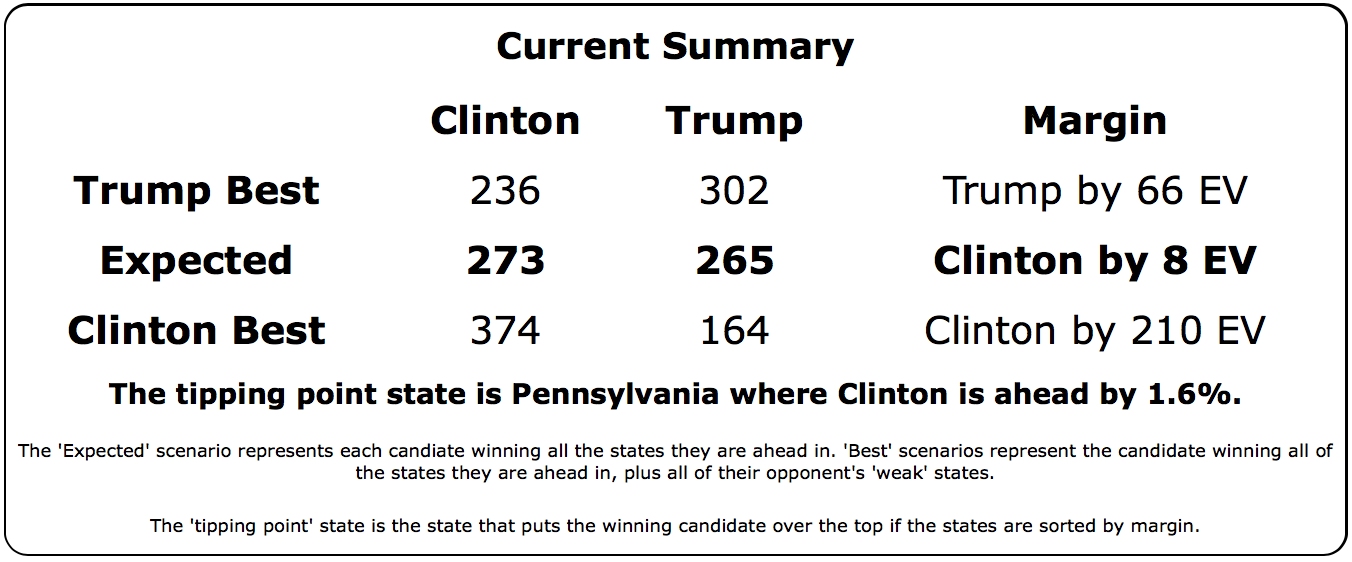
As a point of personal privilege, I will note that I believe this site’s estimates on Sunday, when we had an expected case of Clinton 323 to Trump 215, a 108 electoral vote win for Clinton, were probably a better estimate. This is because the last minute polls that came in Monday and early Tuesday contained some results that seem like outliers and seem to contradict early polling data that has been coming in so far. With the Tuesday update Florida, North Carolina, and Nevada flipped from blue to red. I’m not so sure those three changes are reflective of reality on the ground.
My gut is also that if we do see one candidate or another outperform the polling average above, it is more likely to be Clinton due to strong ground game and early voting efforts.
But the final polls “count” and this site’s official predictions have to abide by the methodology used through the whole campaign season.
We have what we have. We will see very soon where reality falls.
Spectrum of Close States
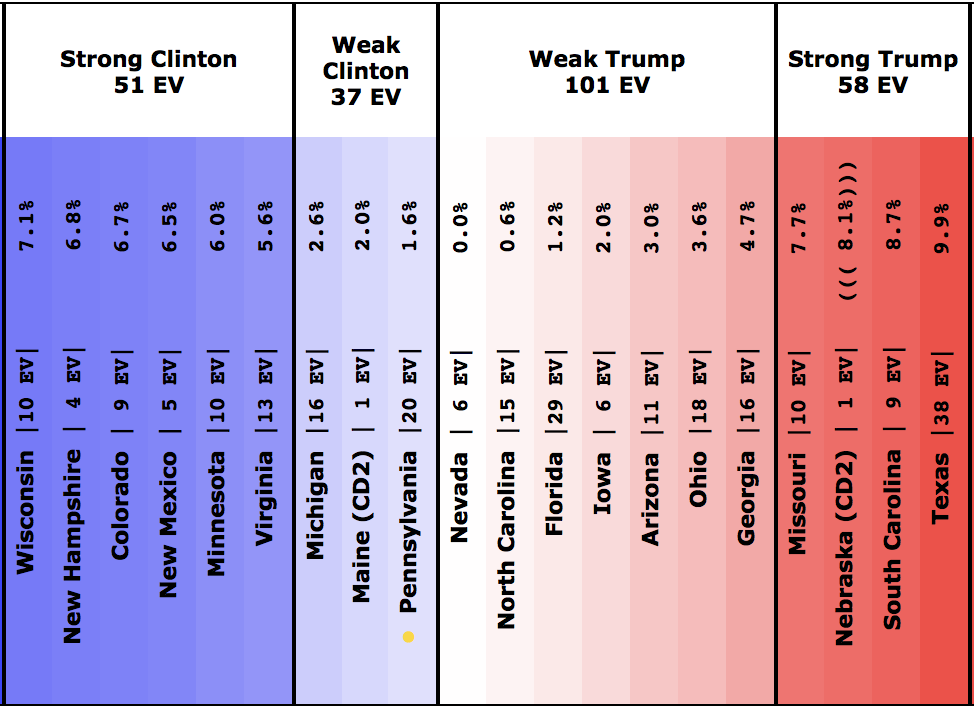
When watching election results come in tonight, these states are the only ones that you really need to pay attention to, and really only the ones labeled “Weak”. Those have a decent chance of flipping to the other side of the center line.
Obviously the smaller the margin, the higher the likelihood the state will end up on the other side of the center line. States very near zero are very likely to flip, those near 5% are actually pretty unlikely to switch.
Chances of the states labeled “strong” above going to the other candidate are very low, but it could potentially happen if one candidate or the other is having a very good night and therefore is significantly exceeding expectations.
Chances of any of the “solid” states not listed above not going as expected are essentially zero. Wyoming and Alabama are red. DC and Vermont are blue. They will not unexpectedly do anything different. :-)
Closing Map
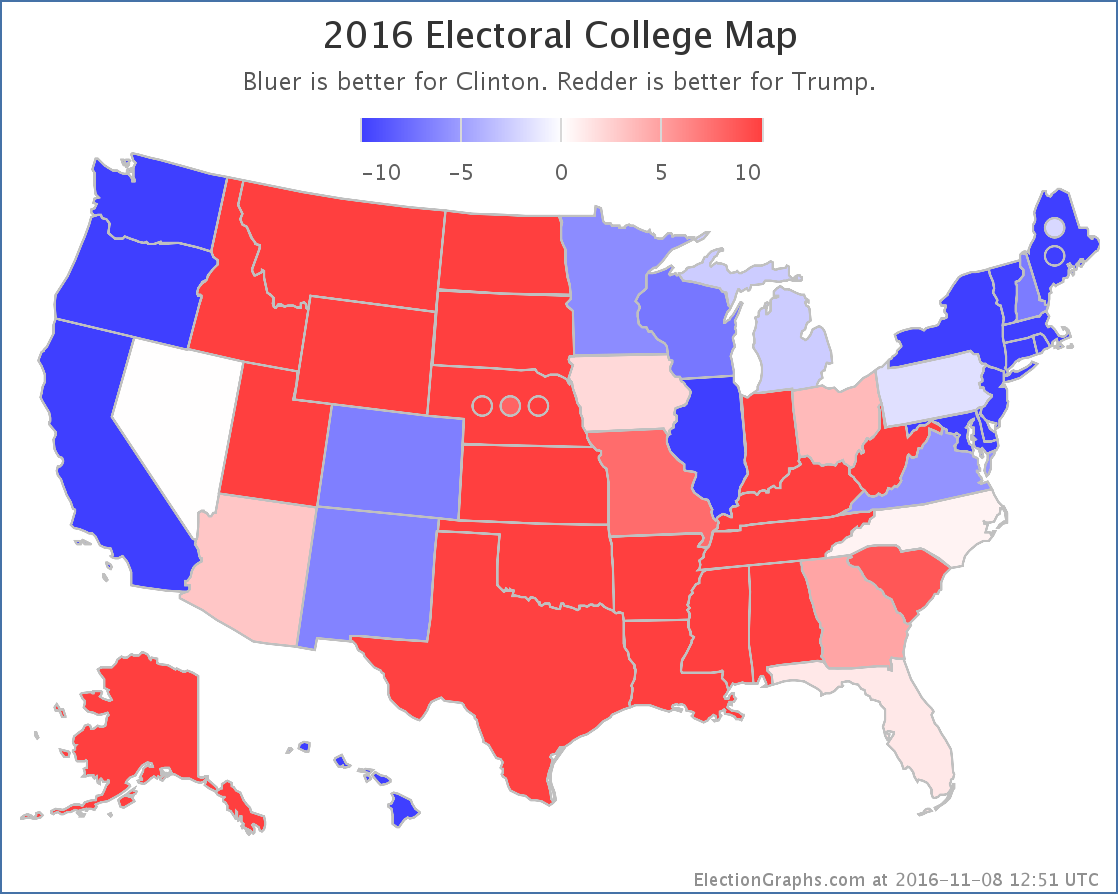
Electoral College Trend
This chart shows the “expected” electoral college margin between the two candidates as the dark green center line. The “bubble” represents the absolute extremes of plausible outcomes. The closer to the edge of the bubble, the less likely an outcome is.
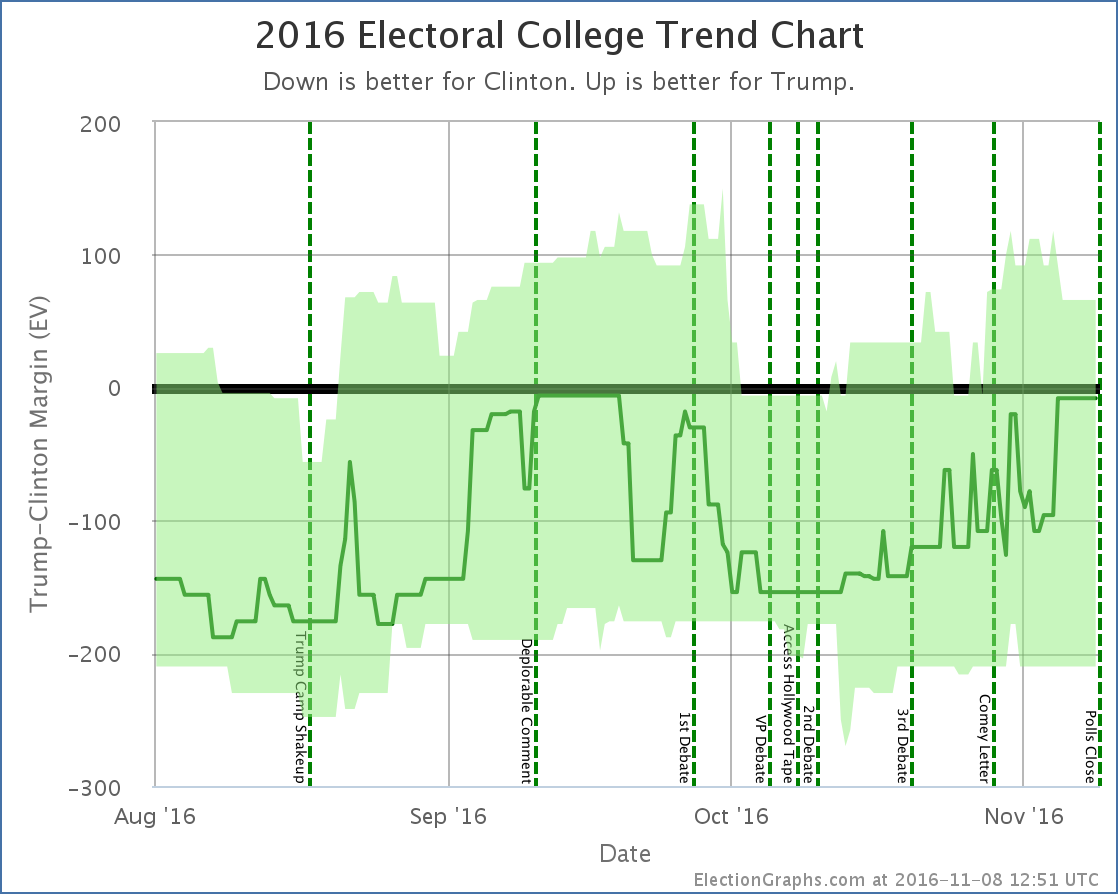
Tipping Point Trend
The “tipping point” is the margin the losing candidate would have to make up in all states to flip the outcome.
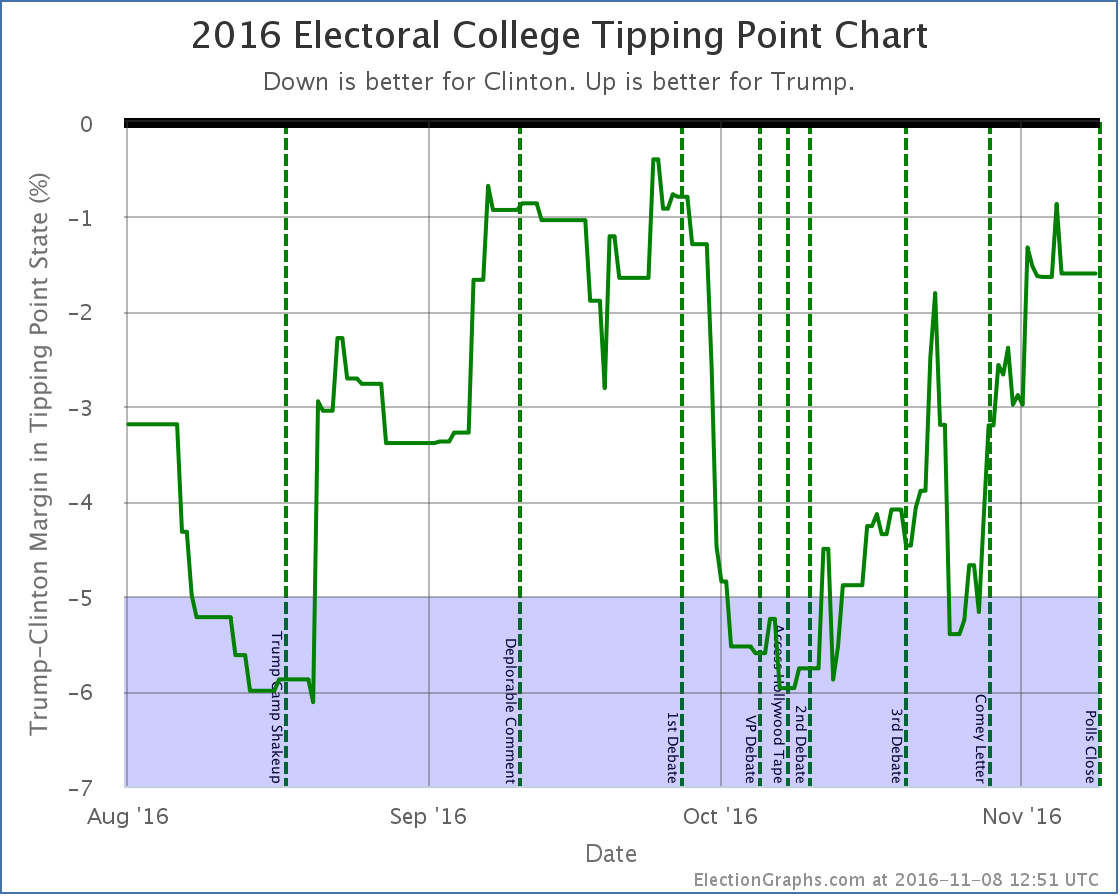
At the End
That summarizes the state of the race as of the end of the campaign.
As I type this there are less than 4 hours until the first full states close and we start to get called races. (Parts of some states close an hour earlier, and of course the three small towns in New Hampshire voted last night.)
We are at the end. Congratulations everyone, you made it.
For more information…
This post is an update based on the data on ElectionGraphs.com. Election Graphs tracks a state poll based estimate of the Electoral College. All of the charts and graphs seen in this post are from that site. Additional graphs, charts and raw data can be found there. Follow @ElectionGraphs on Twitter or like Election Graphs on Facebook to see announcements of updates or to join the conversation. For those interested in individual general election poll updates, follow @ElecCollPolls on Twitter for all the polls as they are added. If you find the information in these posts interesting or useful, please consider visiting the tip jar.
States with new poll data added since the last update: All 50 states and DC.
Notable changes in: Florida (29), North Carolina (15), Wisconsin (10), Colorado (9), Nevada (6), New Hampshire (4), and the tipping point
National Summary
It has been about two days since the last update. While there are mixed changes since then, on balance this is a good update for Trump, and the race looks closer than it did two days ago.
There will be one more update later today to capture any last minute polls released after the cutoff for this update. (There have already been a handful.)
Good for Trump
- The expected case moves from Clinton winning by 108 EV to Clinton winning by only 8 EV.
- The tipping point moves from Clinton by 1.8% in NC to Clinton by 1.6% in PA
Good for Clinton
- Trump’s best case has deteriorated from a 112 EV win to only a 66 EV win
No Change
- Clintons best case remains steady at a 210 EV win
Charts





Discussion
The fact that Trump’s best case is getting worse is pretty much irrelevant. Either candidate winning all the close states is a very low probability event. A few months out it is good to show how things might reasonably move. But on election day, the expected electoral college and the tipping point are the two numbers to watch.
In the last update I speculated that because the tipping point and expected electoral college votes were going in different directions Trump may have topped out. But the movement toward Trump seemed to have a little bit of life in it yet. With the latest batch of update, the Election Graphs poll averages for Florida, North Carolina, and Nevada all move from just barely blue to just barely red. And the tipping point gets a bit narrower too.
Some have suggested there may a strategy to intentionally release Republican leaning polls at the last minute specifically to influence the poll averages, and the impact of some of these polls has been shown to be significant. This probably has something to do with the moves here too. But this site’s philosophy is to basically include all polls with very few exceptions, and when you throw everything in, this is the move you get. Given non-poll-related information on early vote results and such, I have my doubts about Florida and Nevada, but this site will stick to what the numbers say…
…and the numbers say that it is looking very close again. In the expected case Clinton wins by only 8 electoral votes. To flip the election, Trump only has to win Pennsylvania, and Clinton’s lead there is down to 1.6%.
The tipping point margin isn’t quite as small as it it was in September when it was down to 0.4%, but it is close enough that you could easily imagine a Trump win. Right?
Lets check the sites doing odds again for what they think the chances of a Trump win are…
The median estimate of Trump’s chances 2 days ago was 12%. Now it is 14%. So, slight increase, but not a huge one. And if you look at the individual estimates above, many actually went down since two days ago. But if everything is closer, why?
Well, each of the models of course have their own methods, and the movements in each would have a different explanation. Some of them discount or don’t include at all some of the pollsters showing the Trump movement that has moved my averages.
But just looking at the state of the race as a whole instead of specific models… Trump has never been ahead in the electoral college, by most measures he hasn’t ever led the popular vote either, and he’s also never led in Pennsylvania (or the other further off states he would have to flip to win).
So even taking the averages here at face value, and not doubting the status of Florida or Nevada, to win Trump would still need to break his September ceiling and do better than he has done at any time in this race so far. That is possible, but not likely.
Add to that the indications of high Hispanic turnout in several states, notably Florida and Nevada, and that some of the recent polls may be intentionally skewed… and it seems like if someone over performs their polls, it is more likely to be Clinton. But that is looking at things other than the polls themselves.
All and all, the new median of a 14% chance of a Trump upset seems about right.
Maine CD2, Pennsylvania, Nevada, North Carolina, Florida, and Iowa are all within 2% at the moment. They could still go either way based on the current averages. That is enough to swing the election.
So, as has been the case for awhile, a Trump win would be surprising, but should not be shocking. Trump has a path.
We shall all see soon enough.
In New Hampshire we already have some results of course… Dixville Notch, Harts Location, and Millsfield have already reported results. The totals: Trump 32, Clinton 23, plus a handful of votes for others. So there you go.
For real meaningful results, we now have less than 8 hours until parts of Indiana and Kentucky close. Then less than 9 hours until the first full states close and the states start getting called one way or the other.
We are almost there.
State Details
The following are the detailed charts for all the states that influenced the national changes outlined above.
Moving from Clinton to Trump
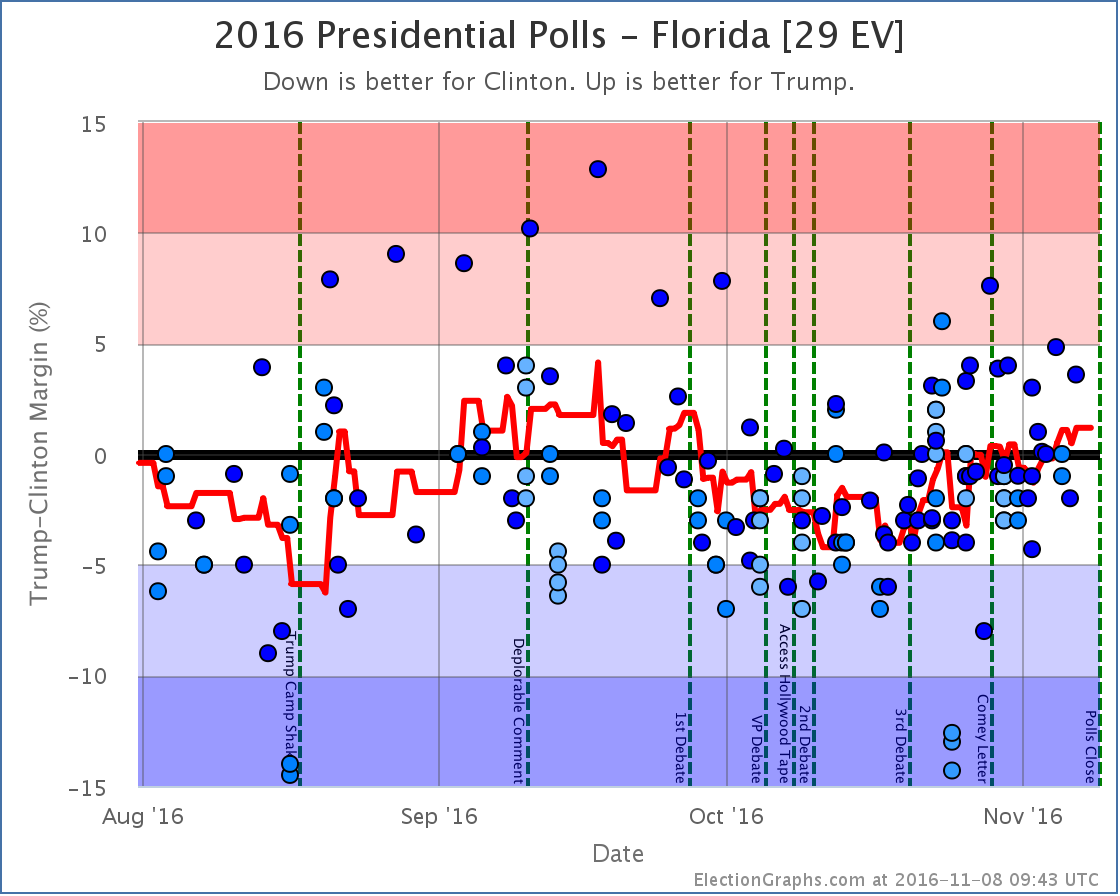
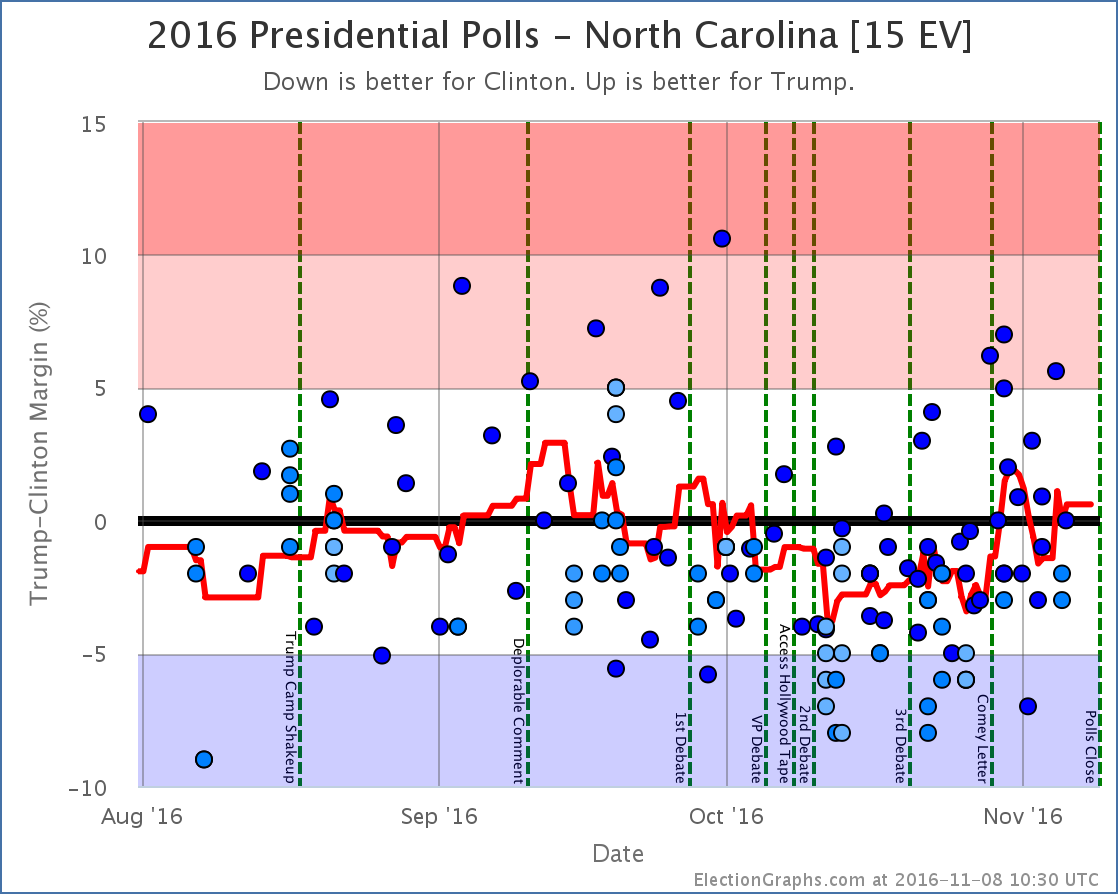
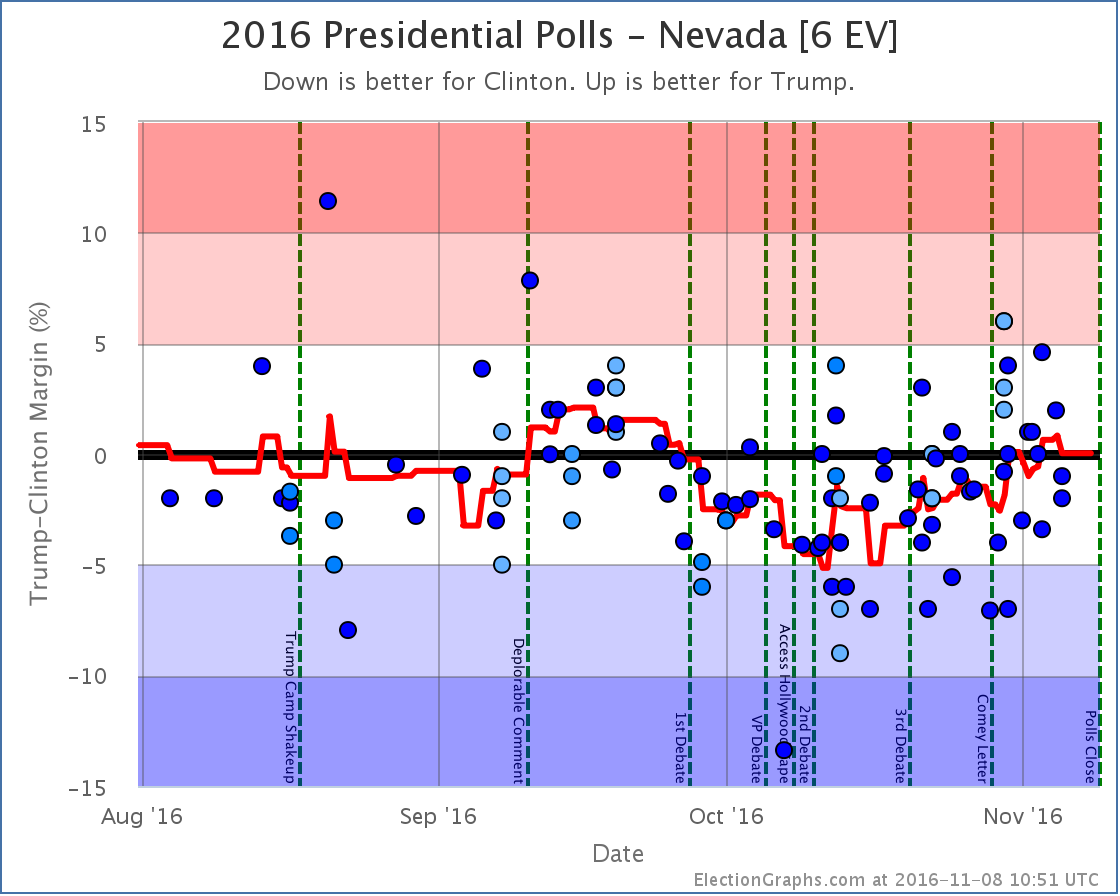
No longer possible pickups for Trump
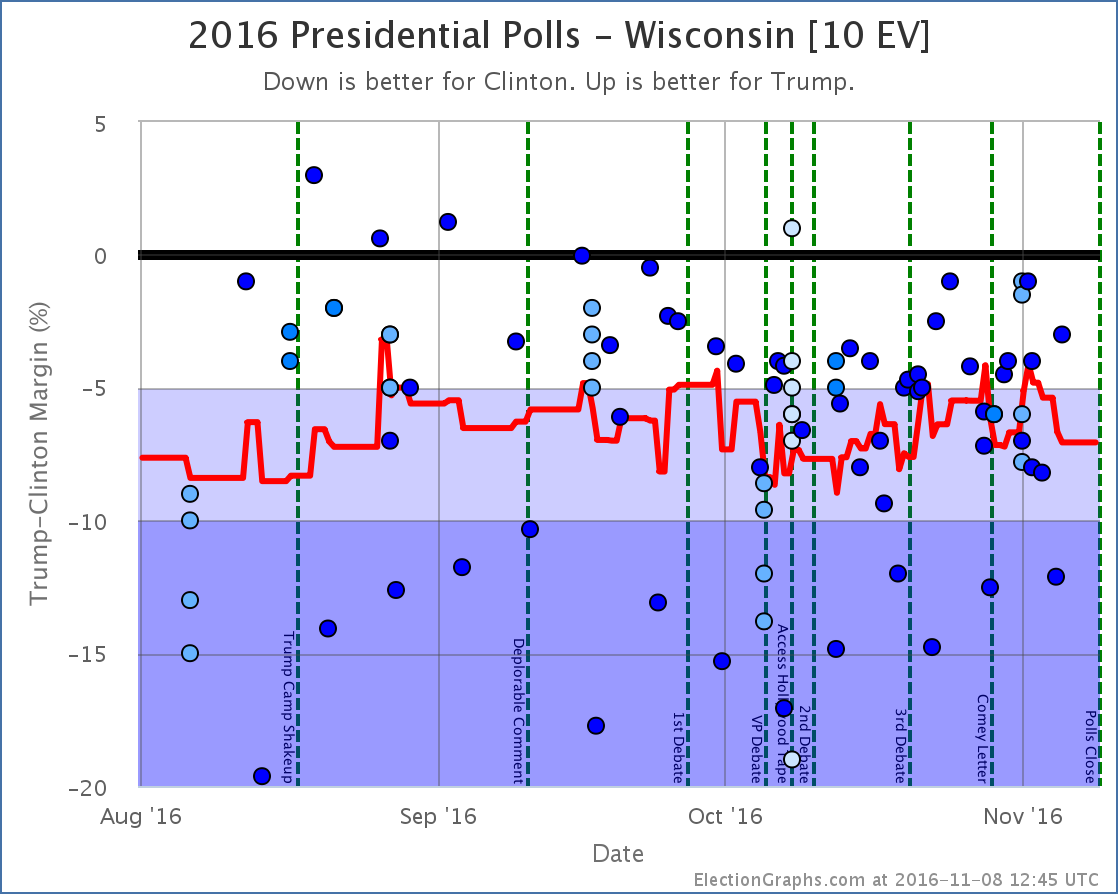
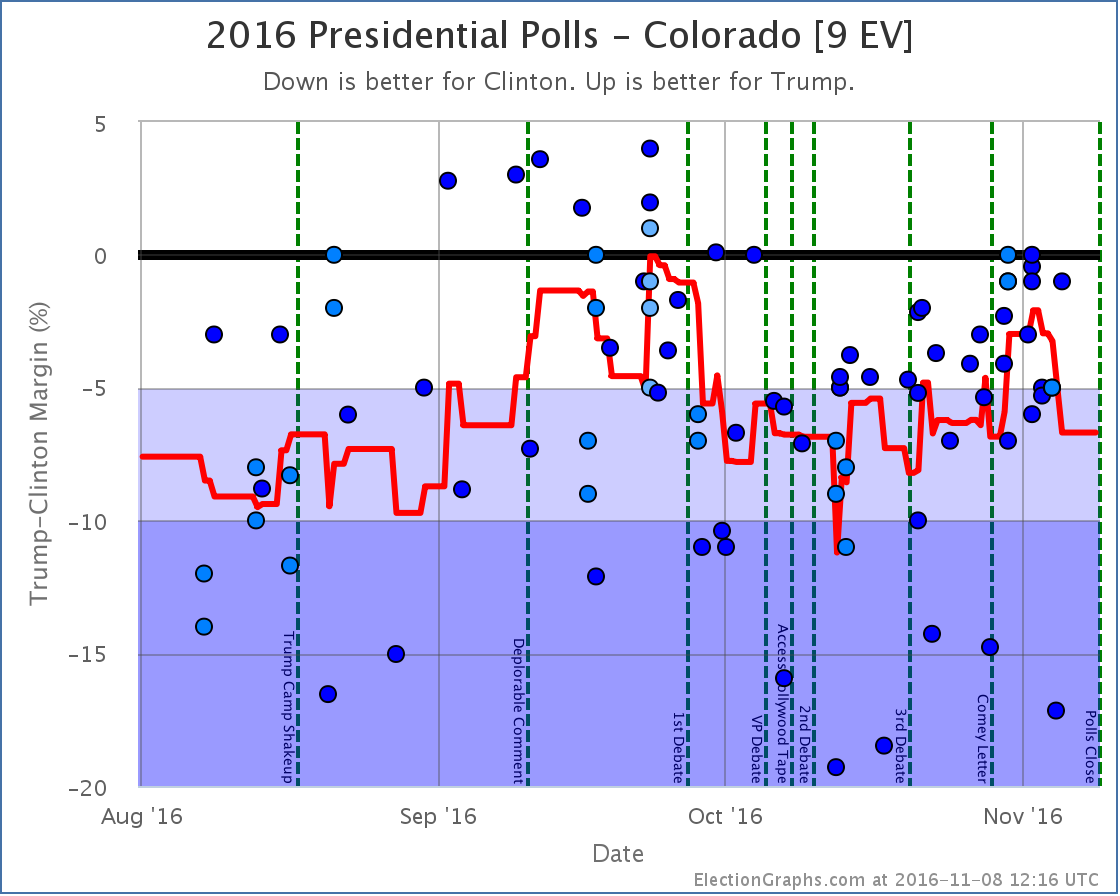
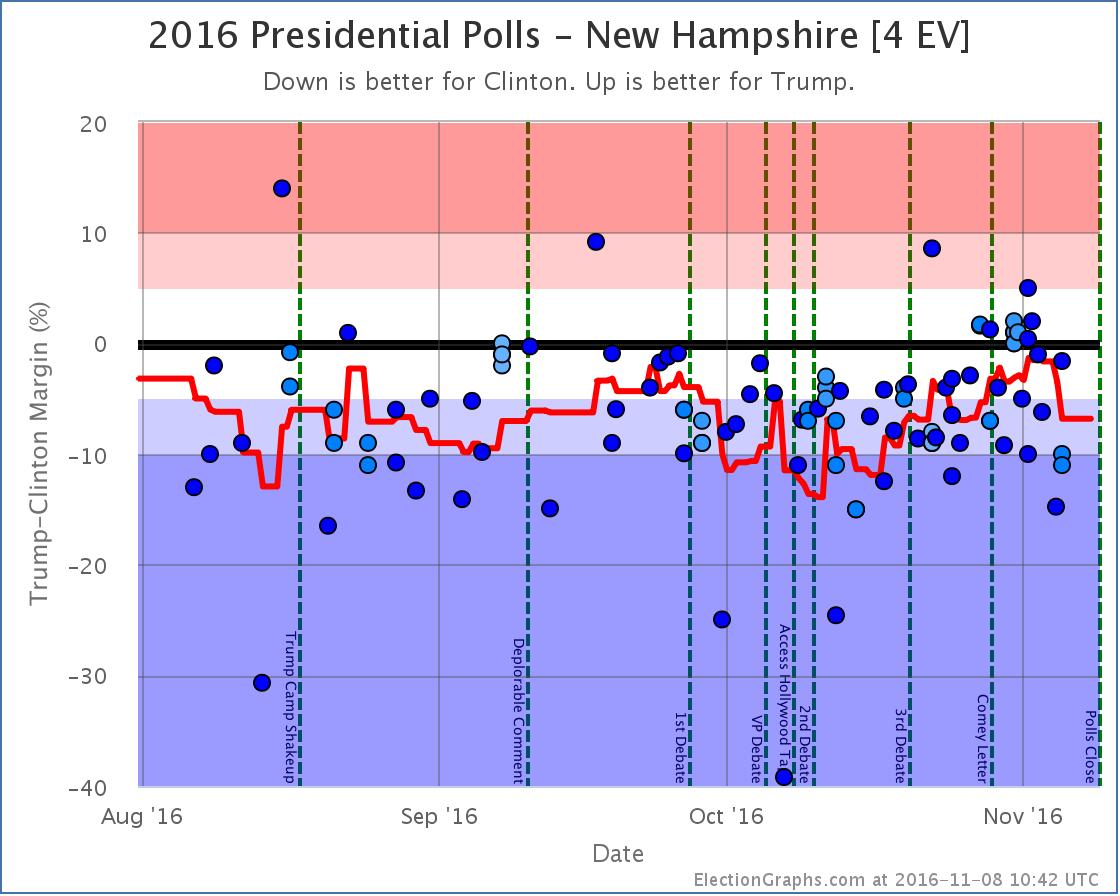
Also impacting the tipping point
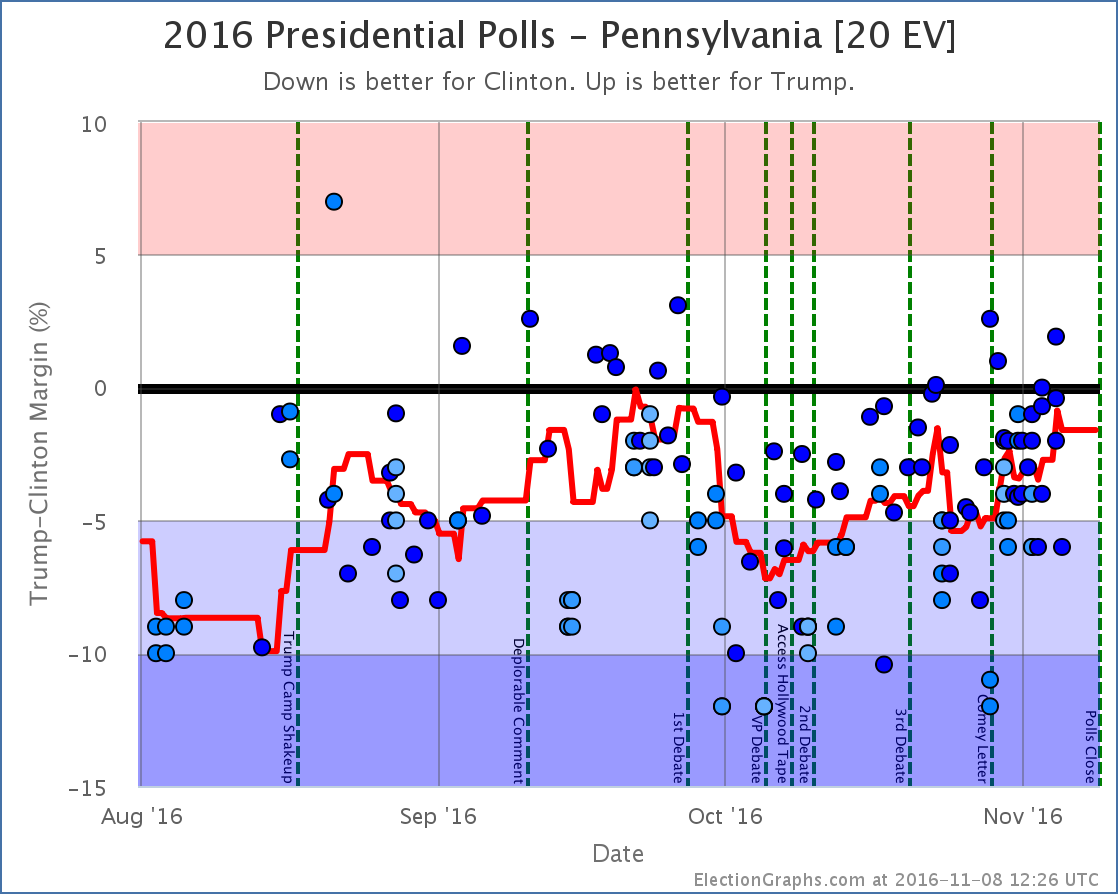
A note about faithless electors
In the past few days there have been reports of first one, then two, expected electors from Washington state saying that that have decided to or are considering being “faithless electors” by voting for someone other than who they are “supposed to” when the Electoral College votes in December.
Yes, they can do that. In Washington state there would be a $1000 fine if they did, but they can do it, and it would count.
There was also one other potential elector from Georgia who suggested they would be faithless back in August. That potential elector came under extreme pressure and resigned, to be replaced by someone who would presumably vote the “right” way.
That might well happen to these two as well. But faithless electors can and do happen every few election cycles. In the last 50 years there were faithless electors in 2004, 2000, 1988, 1976, 1972, and 1968. That is 6 out of 12 elections during that period. Half. It would not be surprising if there were one or more faithless electors in 2016, especially given the contentious nature of the race. They have never made a difference in the final outcome.
The Election Graphs estimates show what the results “should be” given who wins various states. They do not take into account statements by individual electors on their intentions. If a scenario arises where it is close enough for electors who have made statements like this to potentially make a difference in the outcome or throw the race to the House, we will of course make note of that. And once electors vote in December, we will show the final tallies, including any votes cast by faithless electors.
A note about McMullin
Right now the Real Clear Politics average in Utah has McMullin 12.4% behind the lead. The 538 average in Utah has him 9.4% behind the lead. Although McMullin was a lot closer than anyone expected, he never got closer than 5% to the lead in Utah in these averages and now appears to be fading. 538 still has him in second place, but it doesn’t seem likely at this point that he will win electoral votes.
For more information…
This post is an update based on the data on ElectionGraphs.com. Election Graphs tracks a state poll based estimate of the Electoral College. All of the charts and graphs seen in this post are from that site. Additional graphs, charts and raw data can be found there. Follow @ElectionGraphs on Twitter or like Election Graphs on Facebook to see announcements of updates or to join the conversation. For those interested in individual general election poll updates, follow @ElecCollPolls on Twitter for all the polls as they are added. If you find the information in these posts interesting or useful, please consider visiting the tip jar.
States with new poll data added since the last update: All 50 states and DC.
Notable changes in: Florida (29), Georgia (16), North Carolina (15), Virginia (13), Wisconsin (10), Colorado (9), Iowa (6), and the tipping point.
National Summary
It has been about two days since the last update. Since then the changes have been mixed, indicating that perhaps the recent movement toward Trump has topped out.
Good for Trump
- The tipping point moves from Clinton by 2.2% in NH to Clinton by 1.8% in NC
- Trump’s best case has improved from a 100 EV win to a 112 EV win
Good for Clinton
- The expected case moves from Clinton winning by 32 EV to Clinton winning by 108 EV
- Clinton’s best case moves from a 178 EV win to a 210 EV win
Charts
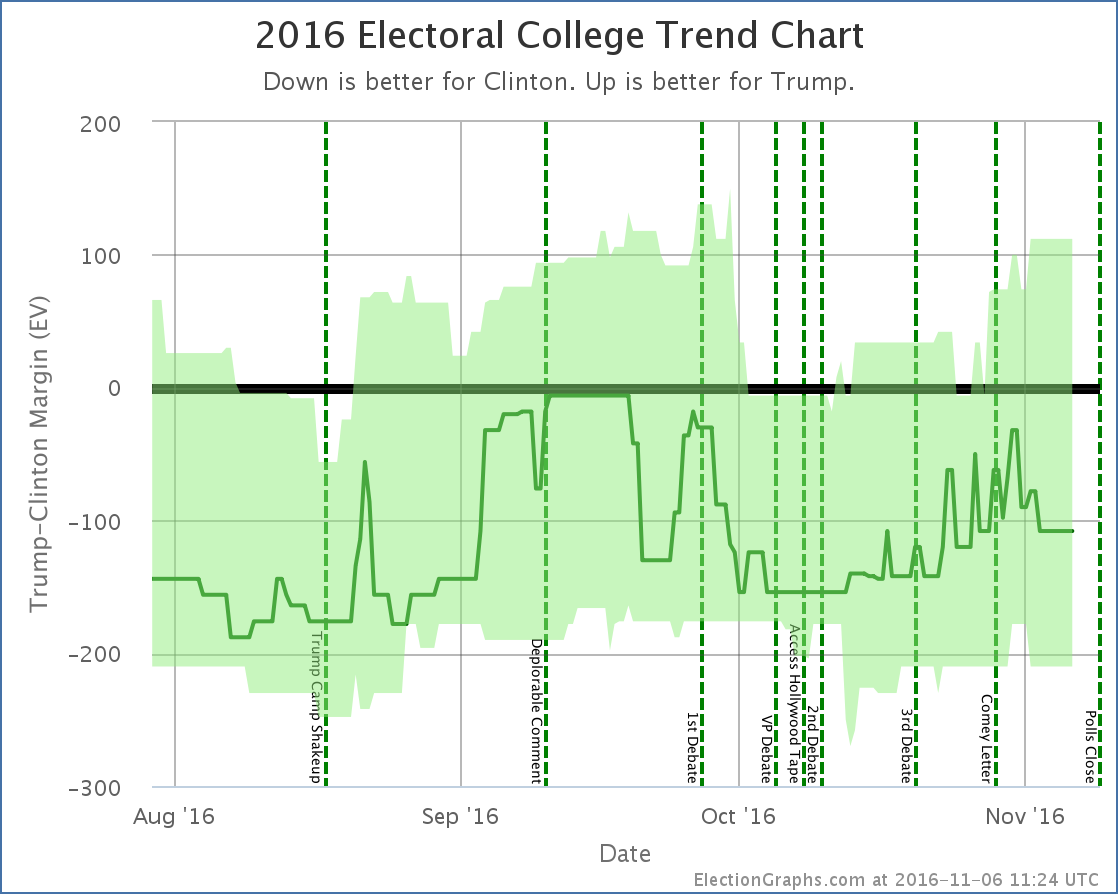
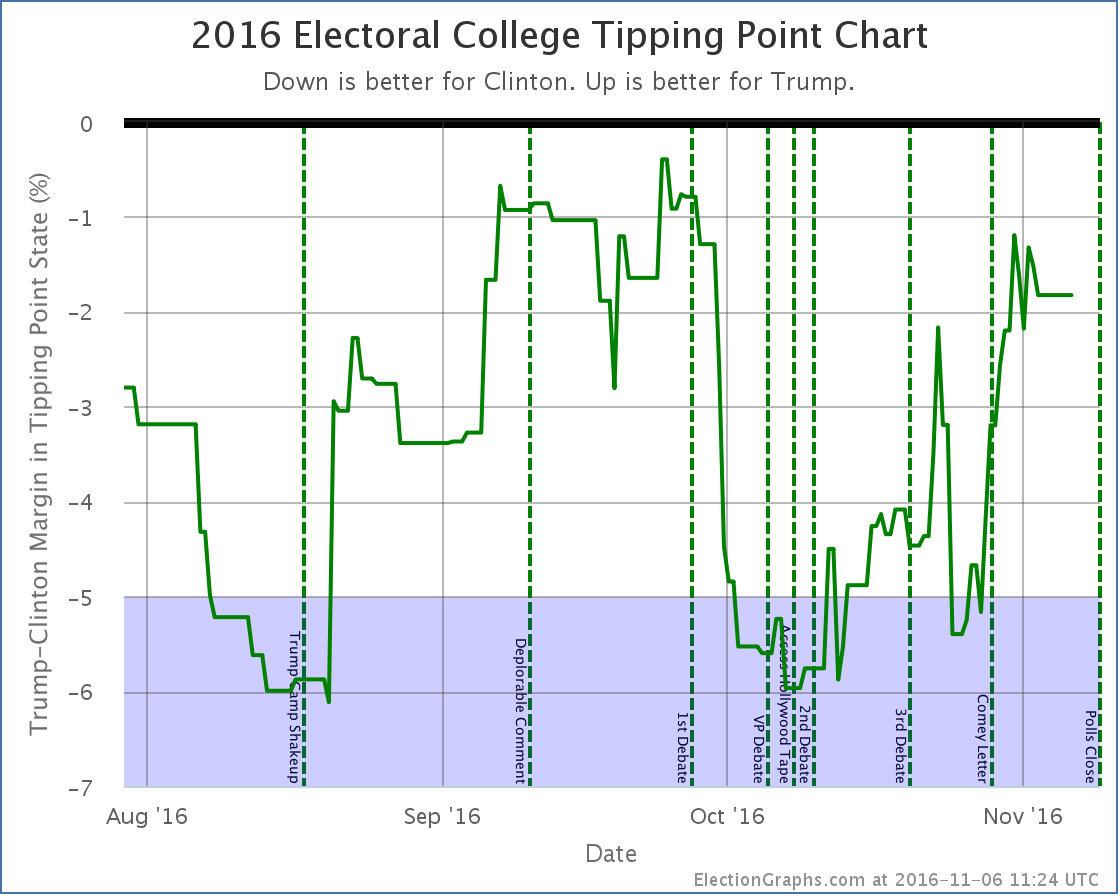
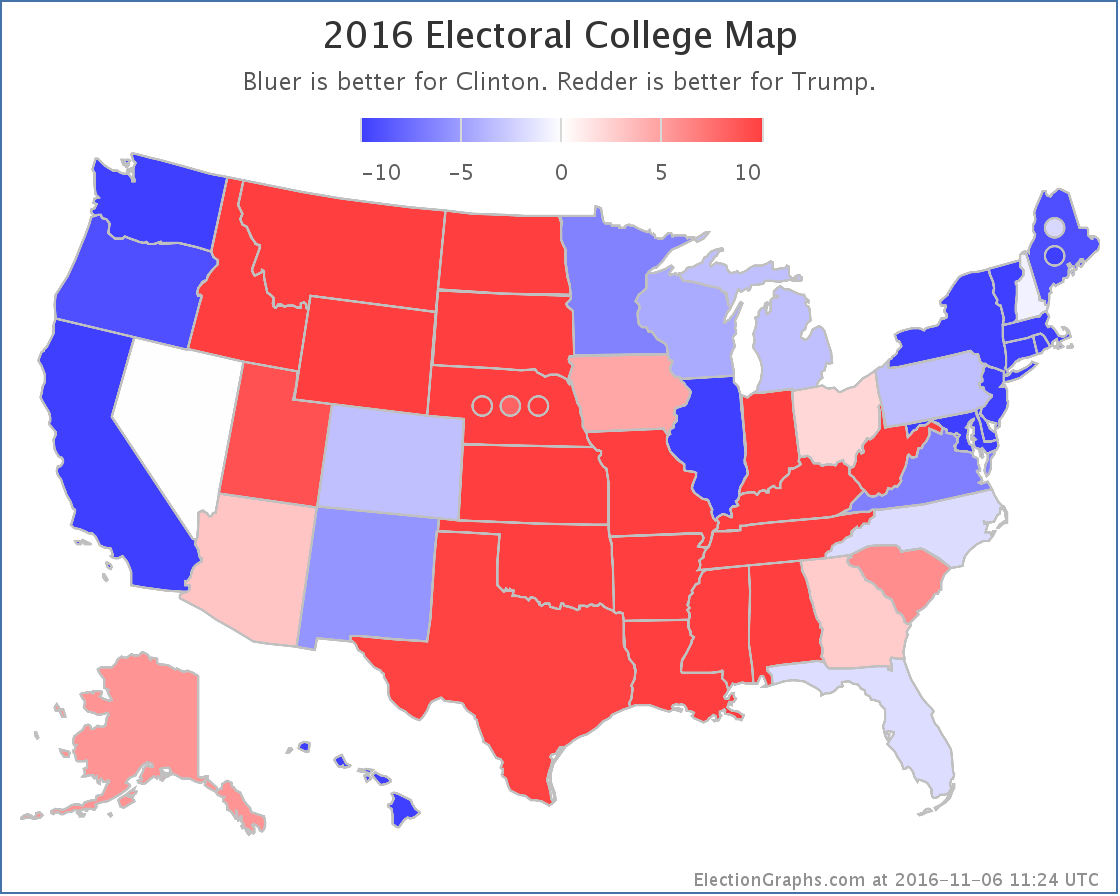
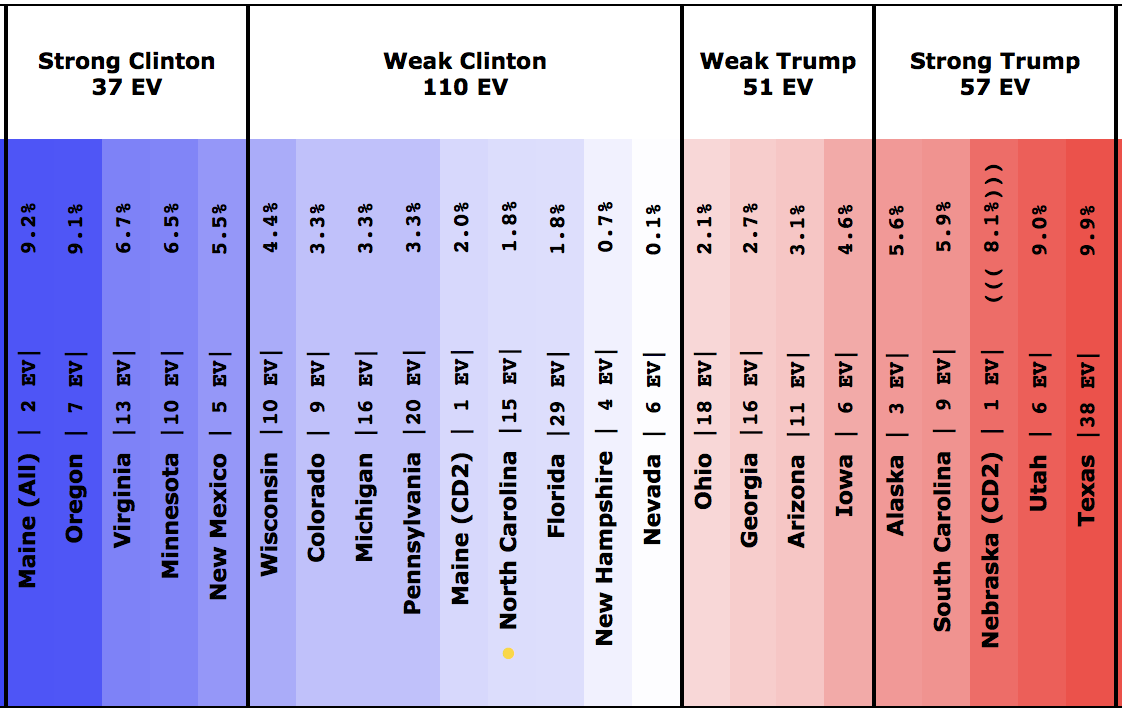
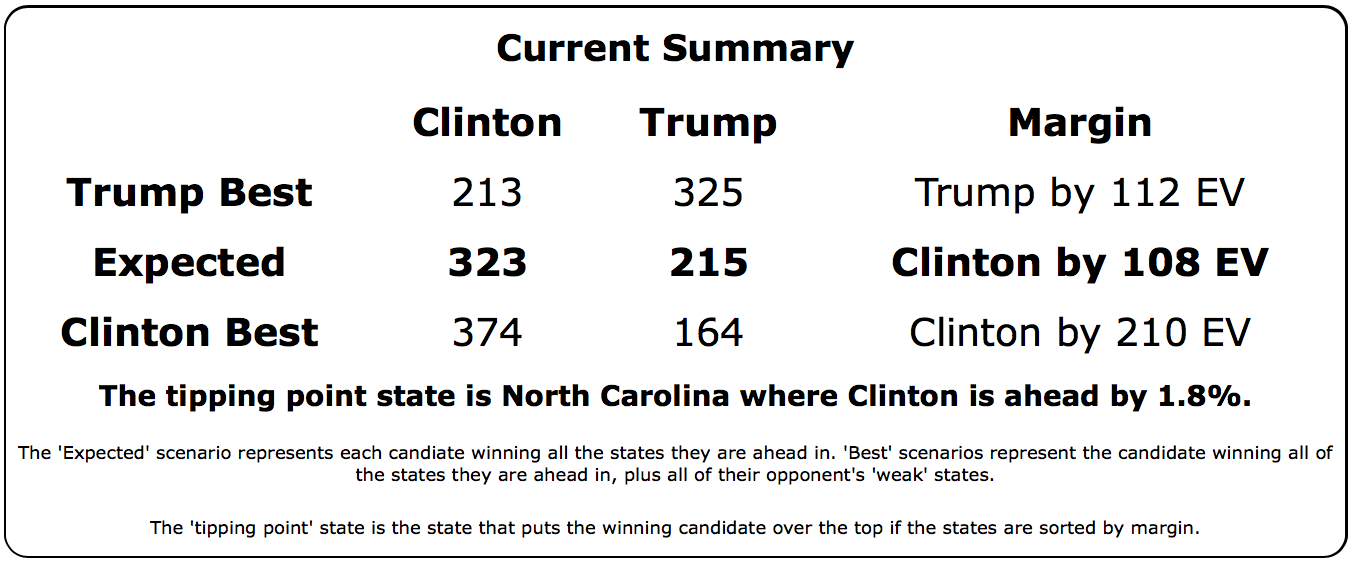
Discussion
While we have some indicators moving in each direction, the two to pay attention to are the expected electoral college result and the tipping point. The two “best case” scenarios give all states with a margin under 5% to one candidate or another. Those are both highly unlikely scenarios less than three days out from polls closing.
Even those two indicators are mixed though. If you had to decide who is favored in this update, you would still pick Trump though. Even though his expected electoral total has gone down, the tipping point moves a bit in his favor, meaning that the amount he has to move polls in order to win has lessened.
So while he is losing by more, the amount of effort to change that has still decreased.
The one caveat there is that while the tipping point has improved since my last update, looking at the actual trend line it seems to be down from a recent peak.
If you put all these mixed messages together, it looks like the recent “Trump Surge” may have reached a high water mark… or at least a pause.
At these levels Clinton is of course still winning. The electoral result according to the current averages would be Clinton 323 to Trump 215, a 108 electoral vote win for Clinton. Trump does better than Romney did here, but still loses.
Trump still has ways to win though. The easiest way right now would be for him to pull in Nevada (0.1% Clinton lead), New Hampshire (0.7% Clinton lead), Florida (1.8% Clinton lead), and North Carolina (1.8% Clinton lead). That would get him to a 269-269 tie and throw the election into the House of Representatives, where he would probably win. To win outright, he would need to also pull in Maine’s 2nd congressional district, where Clinton is currently leading by 2.0% in the Election Graphs average.
Moving things by 2% doesn’t seem that big a move in the grand scheme of things, but given the history of the race in terms of what seem to be the candidate’s floors and ceilings, as well as reports of early voting trends in some of those states (specifically Nevada and Florida), moving those states that last little bit is harder than it may seem just looking at the percentages. If anything, the preliminary early voting data seems to indicate Clinton may end up over-performing the polling, not the other way around.
Just to check in with the sites that give odds (which we do not), the chances of a Trump win given all the current information:
The median of these 8 estimates is 12%. That seems reasonable and in line with what I would expect from the Election Graphs numbers and the small amount of time left before the election is over.
2.5 days until polls start to close. We are almost there.
State Details
The following are the detailed charts for all the states that influenced the national changes outlined above.
Moving from Trump to Clinton
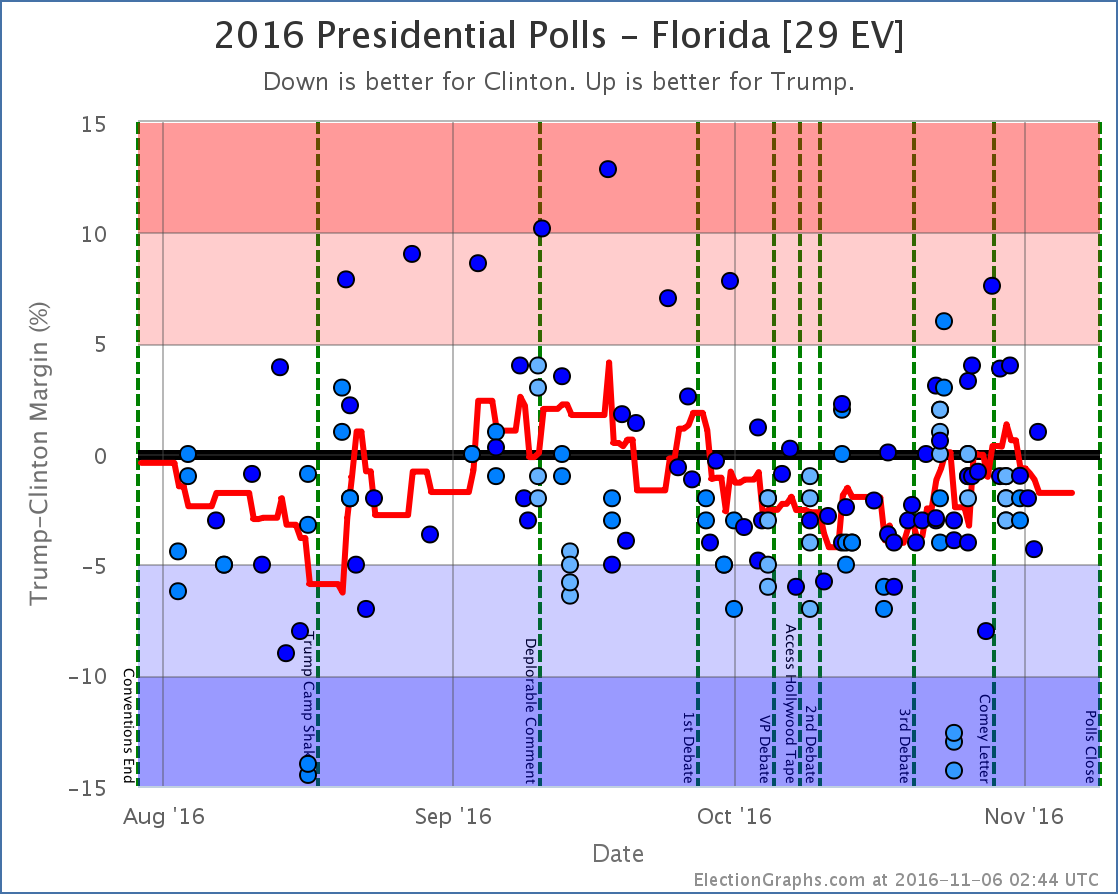
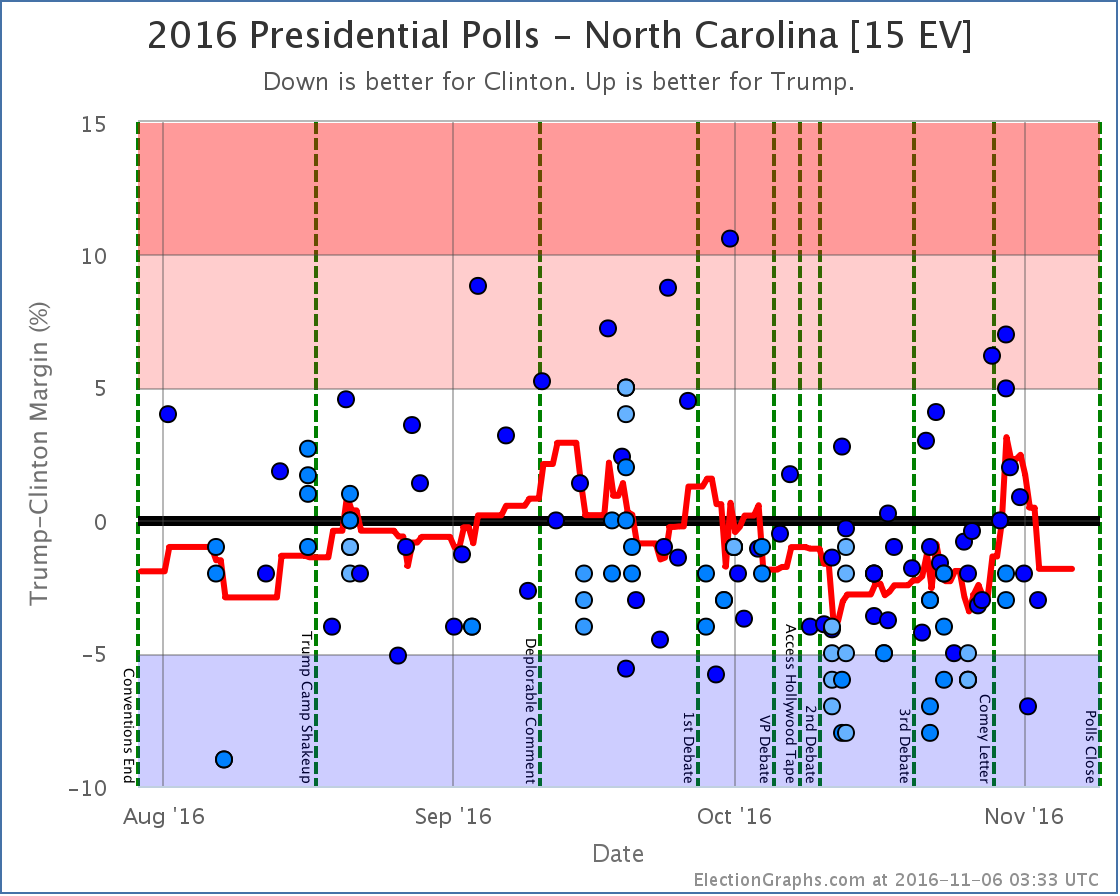
Moving from Clinton to Trump
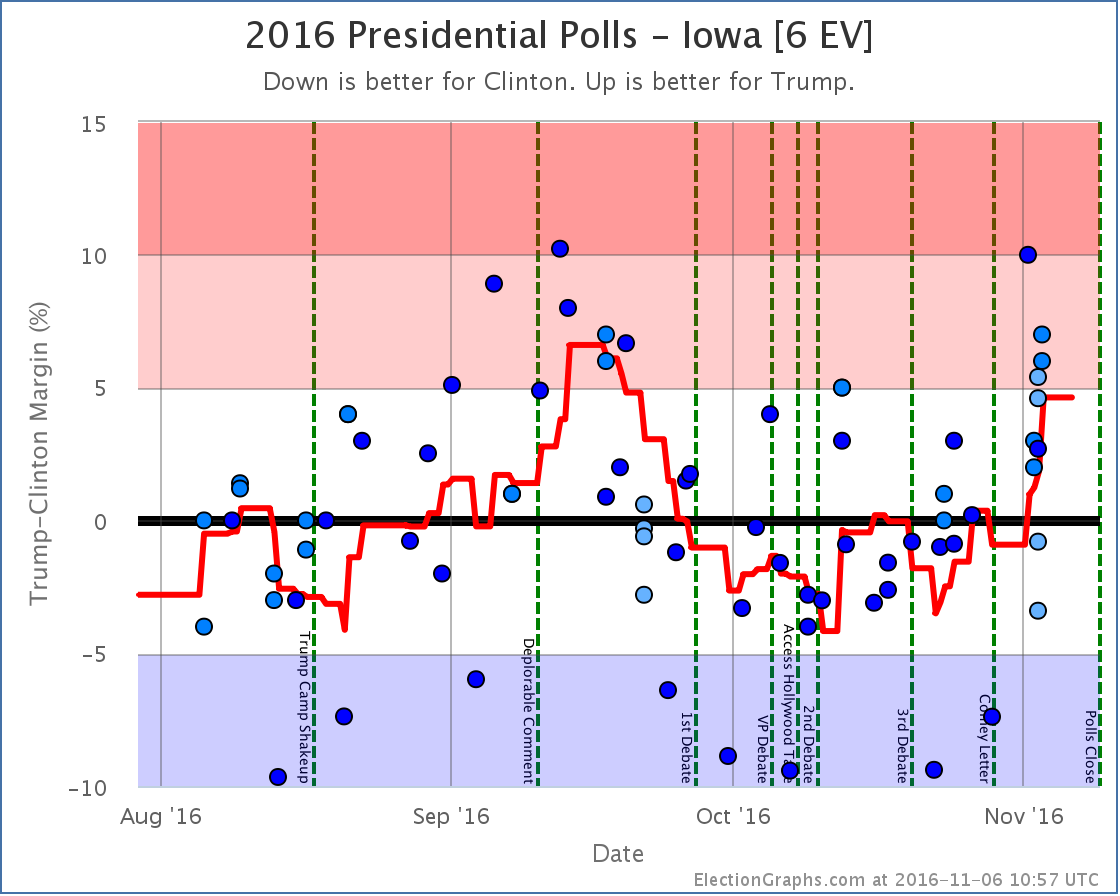
Now possible Trump pickups
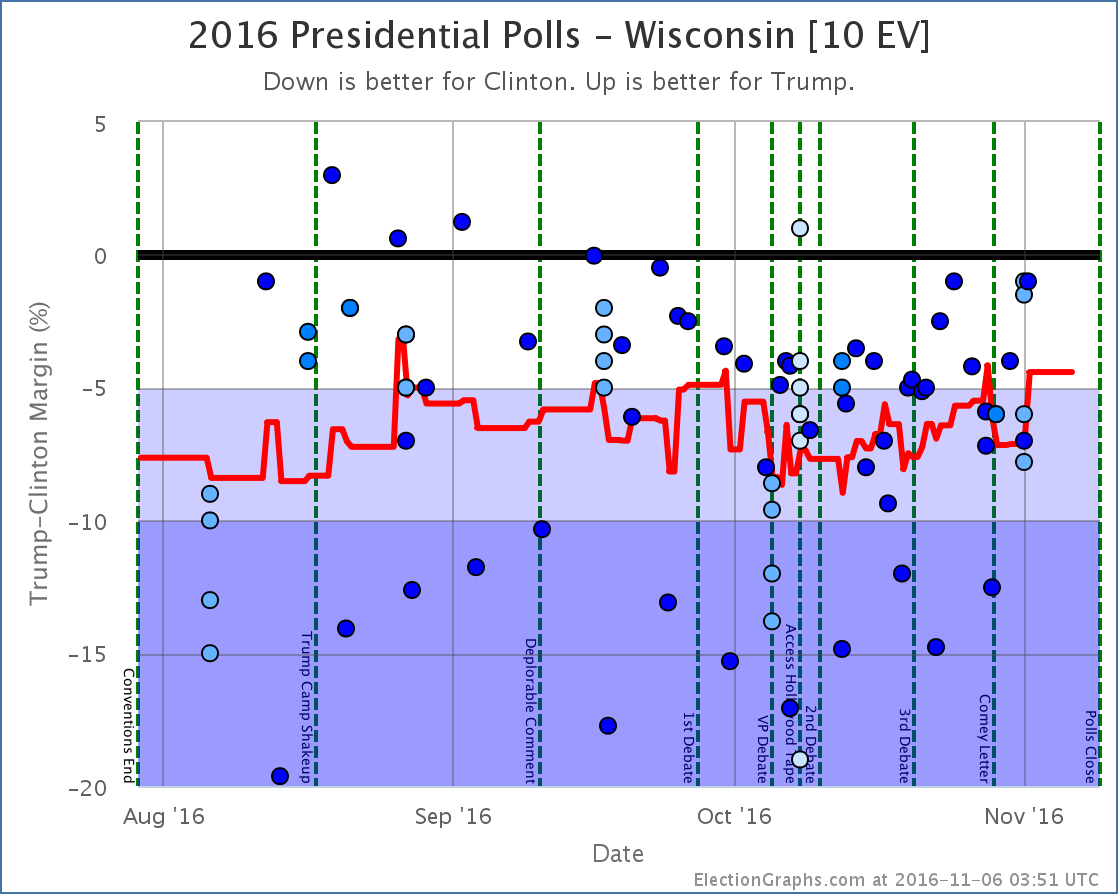
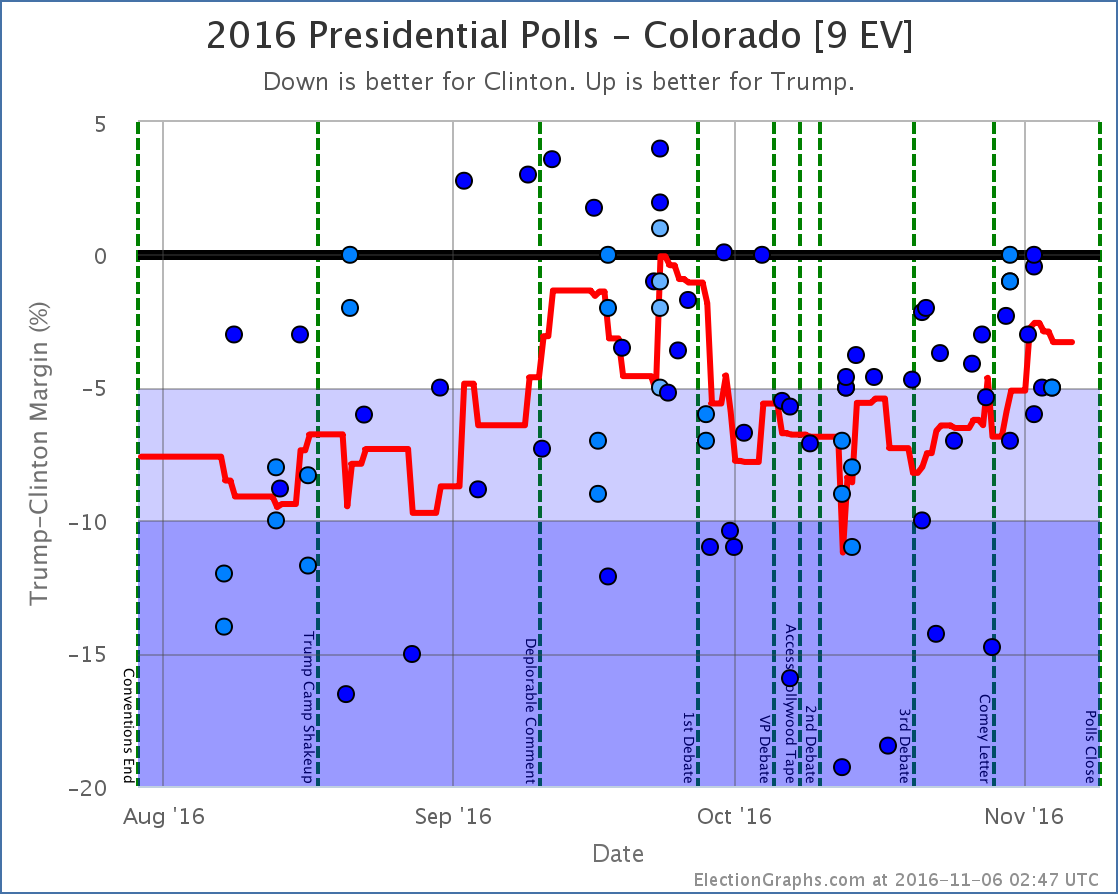
Now possible Clinton pickups
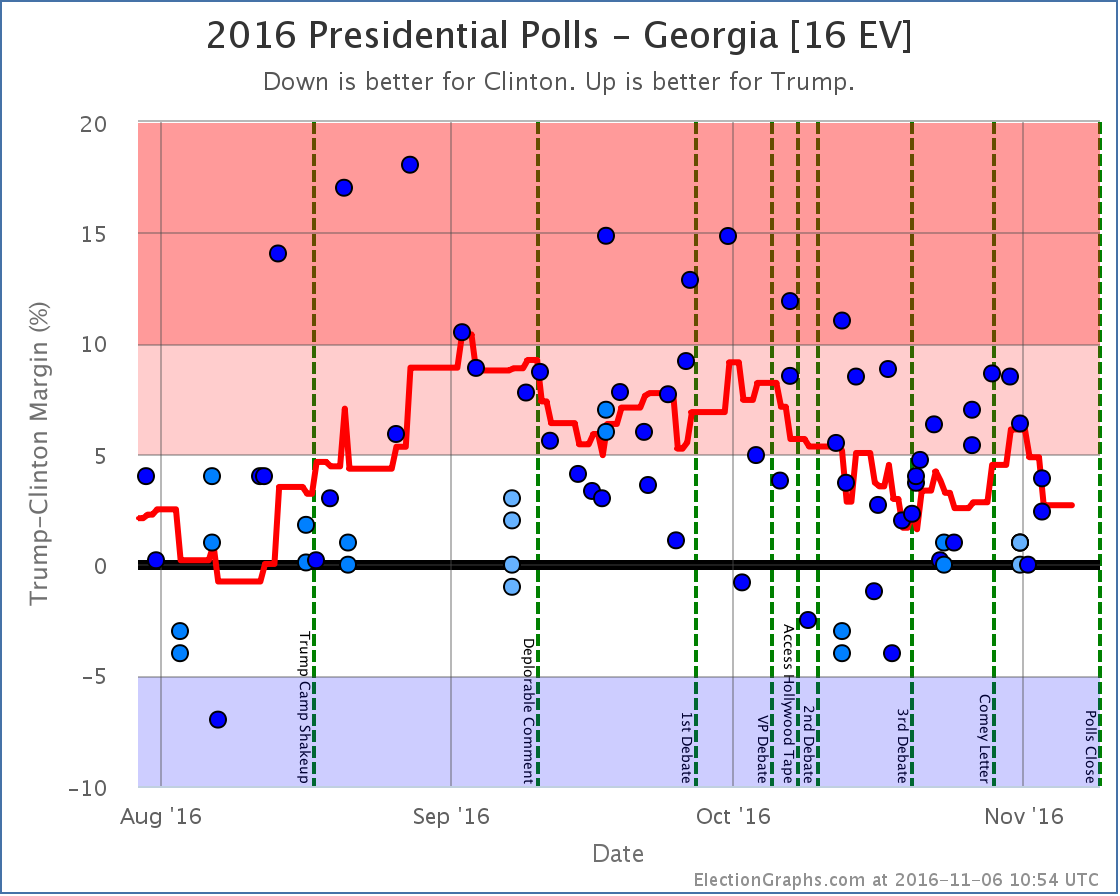
No longer possible Trump pickups
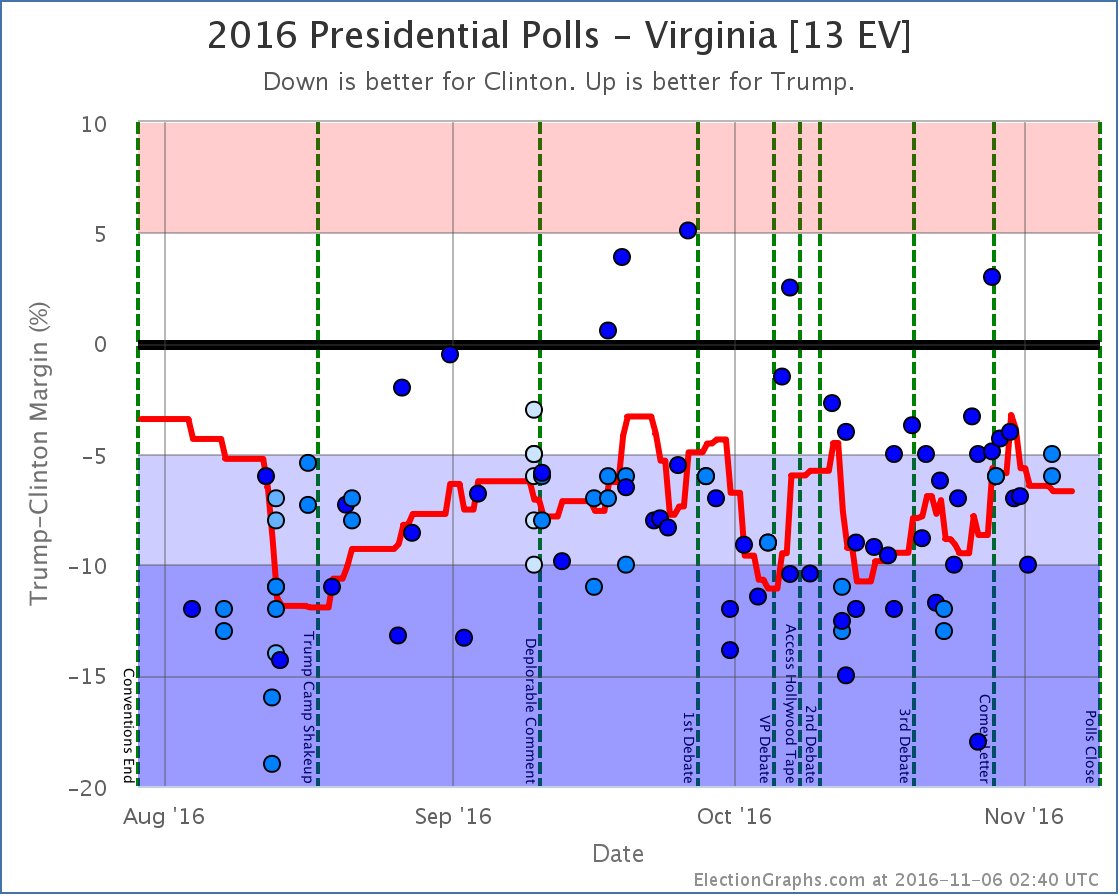
Other states that helped move the tipping point
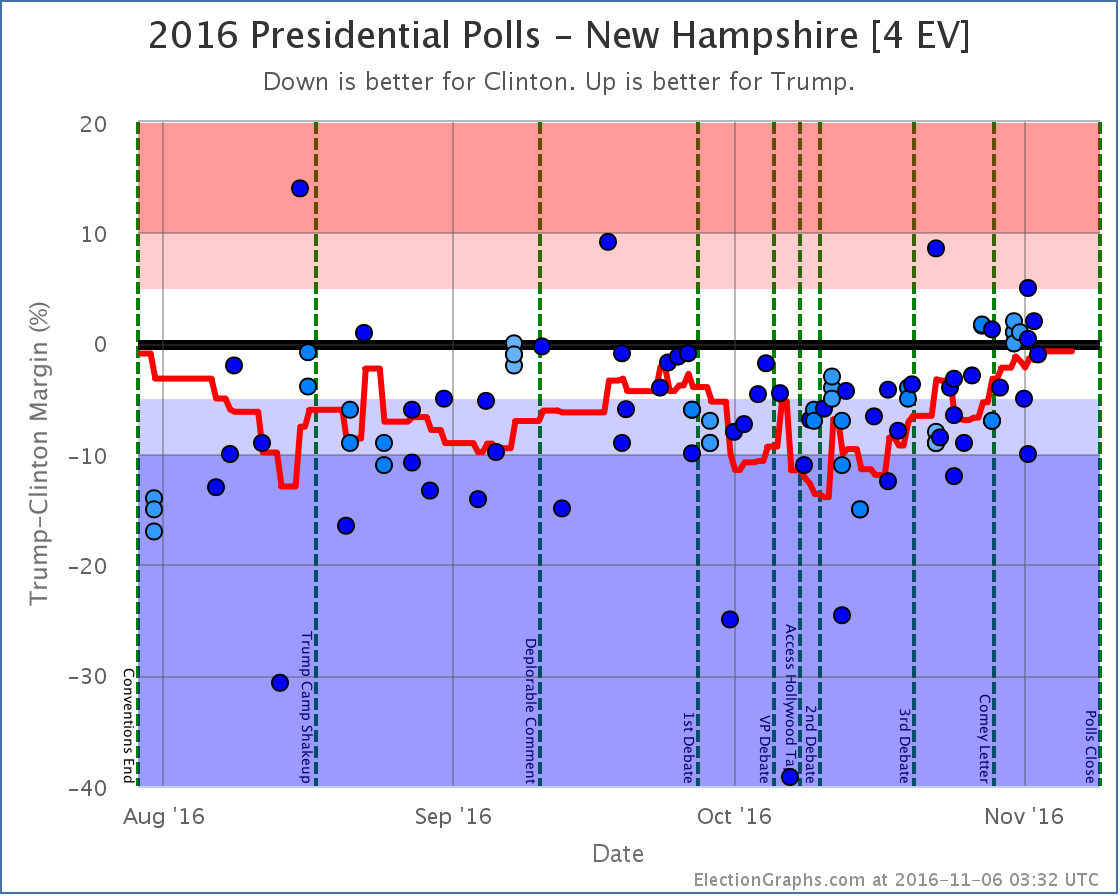
A note about faithless electors
In the past few days there have been reports of first one, then two, expected electors from Washington state saying that that have decided to or are considering being “faithless electors” by voting for someone other than who they are “supposed to” when the Electoral College votes in December.
Yes, they can do that. In Washington state there would be a $1000 fine if they did, but they can do it, and it would count.
There was also one other potential elector from Georgia who suggested they would be faithless back in August. That potential elector came under extreme pressure and resigned, to be replaced by someone who would presumably vote the “right” way.
That might well happen to these two as well. But faithless electors can and do happen every few election cycles. In the last 50 years there were faithless electors in 2004, 2000, 1988, 1976, 1972, and 1968. That is 6 out of 12 elections during that period. Half. It would not be surprising if there were one or more faithless electors in 2016, especially given the contentious nature of the race. They have never made a difference in the final outcome.
The Election Graphs estimates show what the results “should be” given who wins various states. They do not take into account statements by individual electors on their intentions. If a scenario arises where it is close enough for electors who have made statements like this to potentially make a difference in the outcome or throw the race to the House, we will of course make note of that. And once electors vote in December, we will show the final tallies, including any votes cast by faithless electors.
A note about McMullin
Right now the Real Clear Politics average in Utah has McMullin 12.4% behind the lead. The 538 average in Utah has him 10.3% behind the lead. Although McMullin was a lot closer than anyone expected, he never got closer than 5% to the lead in Utah in these averages and now appears to be fading. 538 still has him in second place, but it doesn’t seem likely at this point that he will win electoral votes.
If that changes, I will of course note it in these updates and on the Election Graphs site.
For more information…
This post is an update based on the data on ElectionGraphs.com. Election Graphs tracks a state poll based estimate of the Electoral College. All of the charts and graphs seen in this post are from that site. Additional graphs, charts and raw data can be found there. Follow @ElectionGraphs on Twitter or like Election Graphs on Facebook to see announcements of updates or to join the conversation. For those interested in individual general election poll updates, follow @ElecCollPolls on Twitter for all the polls as they are added. If you find the information in these posts interesting or useful, please consider visiting the tip jar.
Edit 13:56 UTC to add an additional paragraph break.
States with new poll data added since the last update: All 50 states, DC, the Maine congressional districts, and the 2nd congressional district in Nebraska.
Notable changes in: Pennsylvania (20), Georgia (16), Michigan (16), North Carolina (15), Virginia (13), New Hampshire (4), Alaska (3), and the tipping point.
With the current pace of polling, there are already a number of new polls out since the line was cut for this update. They will of course be included in the next update.
National Summary
It has been about four days since the last update. Since then the movement has all been towards Trump. Some of this has been movement from polls taken primarily after the Comey letter, but a some of it also represents movement that was already happening when that news broke.
Good for Trump:
- The expected result has moved from a 62 EV Clinton win to only a 32 EV Clinton win
- The tipping point has moved from Clinton by 5.3% in PA to Clinton by only 2.2% in NH
- Clinton’s best case has declined from a 216 EV win to only a 178 EV win
- Trump’s best case has shifted from a 6 EV loss to a 100 EV win
Charts
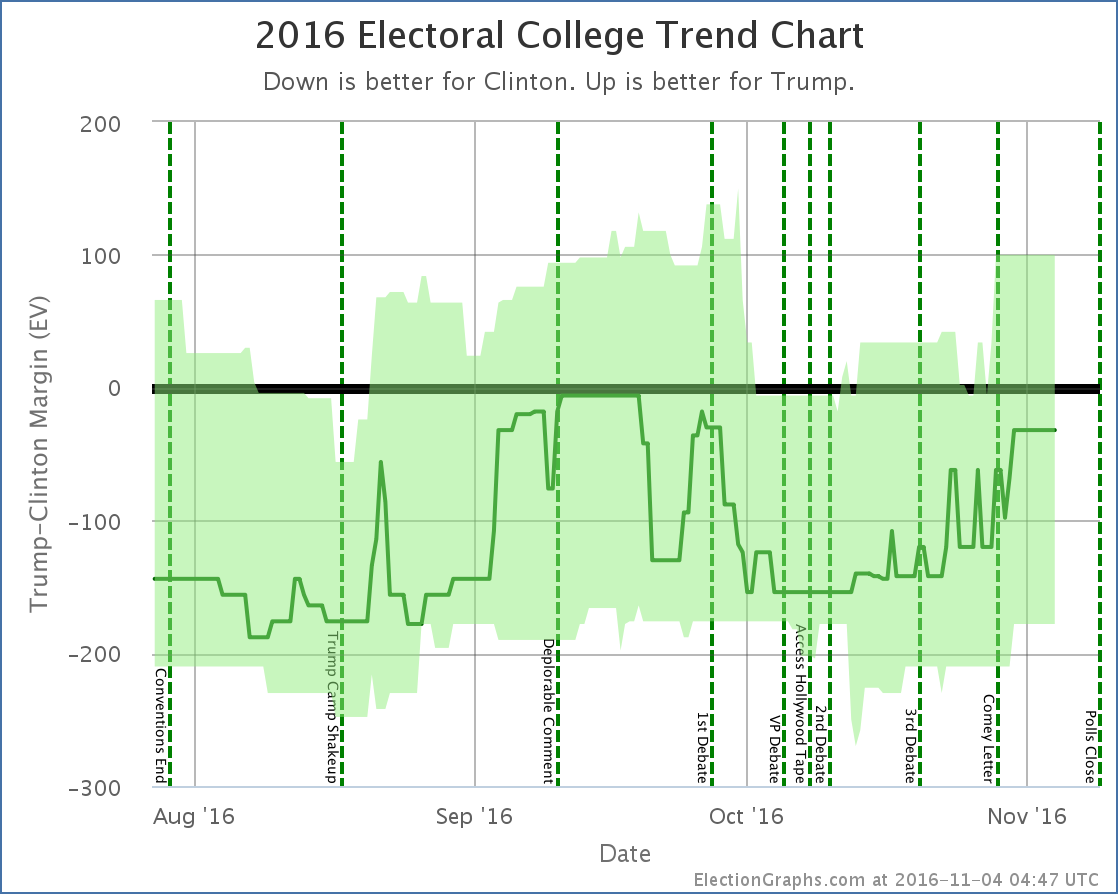
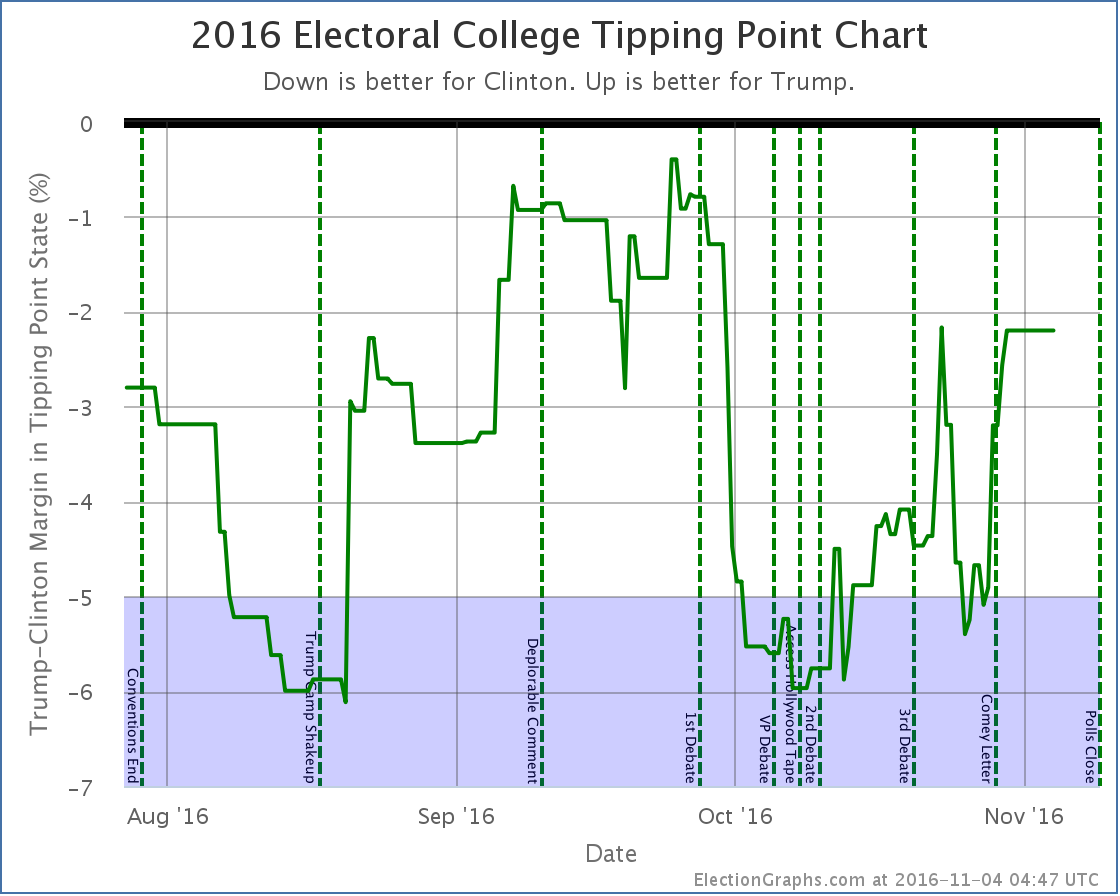
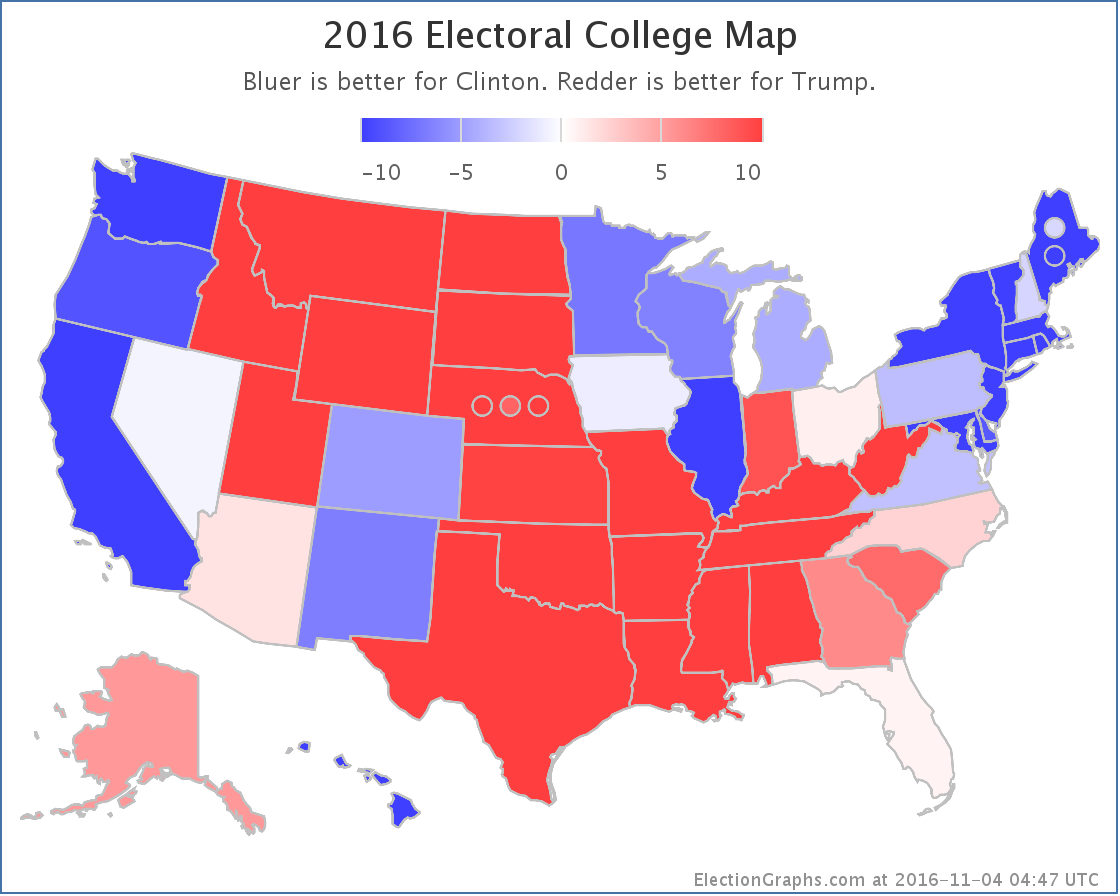
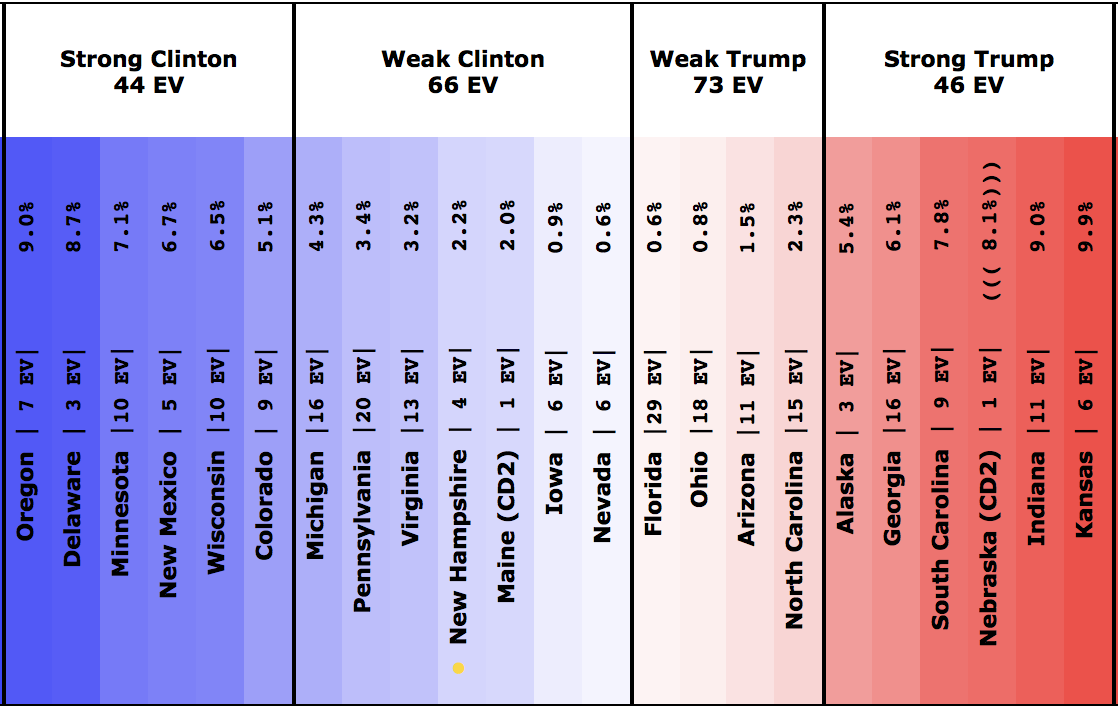
Discussion
Four days ago Trump had tightened the expected electoral college case, but critical states like Pennsylvania were moving against him, so the job of getting to 270 electoral votes was actually getting harder despite the electoral college gap narrowing.
Not so any more. In the last few days, which added lots of post-Comey polls (as well as some covering the pre-Comey period too) the movement has ALL been toward Trump. There is no mixed message this time. No bright side for Clinton. In the last few days almost all of the polling news has been good for Trump and bad for Clinton.
Now, she is still ahead. But Trump once again has a path. The “easiest” path at this point would be to win all the states he is currently leading, then pull in Nevada (0.6% Clinton lead), Iowa (0.9% Clinton lead) and New Hampshire (2.2% Clinton lead). Or he could get any one of those states, plus Virginia (3.2% Clinton lead). Or just Pennsylvania (3.4% Clinton lead). Or just Michigan (4.3% Clinton lead).
All of these states are ones where a few days ago Clinton’s lead was much stronger. Trump has been making gains all over the map.
How much of this is Comey? Some for sure, but as I’ve pointed out before, the expected electoral college been moving slowly toward Trump for weeks. But that did seem to have somewhat stalled out. The tipping point was moving back toward Clinton. With the Comey letter the move toward Trump came back with a vengeance.
We’re not quite at Trump’s highs from September, but we are getting near there. Now, even at his best point in September, Trump was still losing to Clinton. But it was close. And it is close again now. The Trump surge is real, and he has made this a race again.
The tipping point is at 2.2%. That is within the zone where a systematic polling error or a last minute news event that happens too late to be captured in polls could reverse the result. A Trump win COULD happen. This is not impossible.
Clinton is still heavily favored though.
This site does not produce “odds”, just the range of “you shouldn’t be completely shocked” outcomes, which is intentionally pretty wide. Right now, a Clinton win is expected, but a Trump win is not out of the question.
Lots of places do produce odds though. Here is the current rundown in terms of percentage chance of Trump winning:
I was asked on Twitter yesterday for my odds. Given that my model does not produce a number for this, I was reluctant to give an exact number. But I gave a range and said between 5% and 10%. With a few additional polls added since then, I’d go toward the higher end of that range. Maybe 7% to 10%.
Why that range?
Trump is getting very close to Clinton, but in all the prior polling movement in the campaign Trump has never been able to actually pull into the lead. It seems like he reaches a ceiling and gets to the point where to gain any further he has to not just convince the wishy-washy undecideds, but he has to start getting actual Clinton supporters to flip, which seems like a much harder job.
But until September I thought Trump’s ceiling was matching Romney’s performance in 2012. With current polling, Trump wins every state Romney won, then adds Florida and Ohio. So levels that look like ceilings can indeed be broken. Another bad news cycle for Clinton, or even some systematic error in the polling could easily put us there.
So 7% to 10% seems reasonable.
If a Trump win does happen, surprise is warranted, because he would have beaten the odds, but not shock, because he IS close.
If Trump was a hurricane that was four days out, we would be “within the cone”. Toward the edge of the cone to be sure. We are not directly on the projected path. We expect it to miss us. But we would be making preparations just in case the storm swerves and hits us.
4.3 days until we stop looking at polls and start looking at actual election results.
State Details
The following are the detailed charts for all the states that influenced the national changes outlined above.
Moving from Clinton to Trump
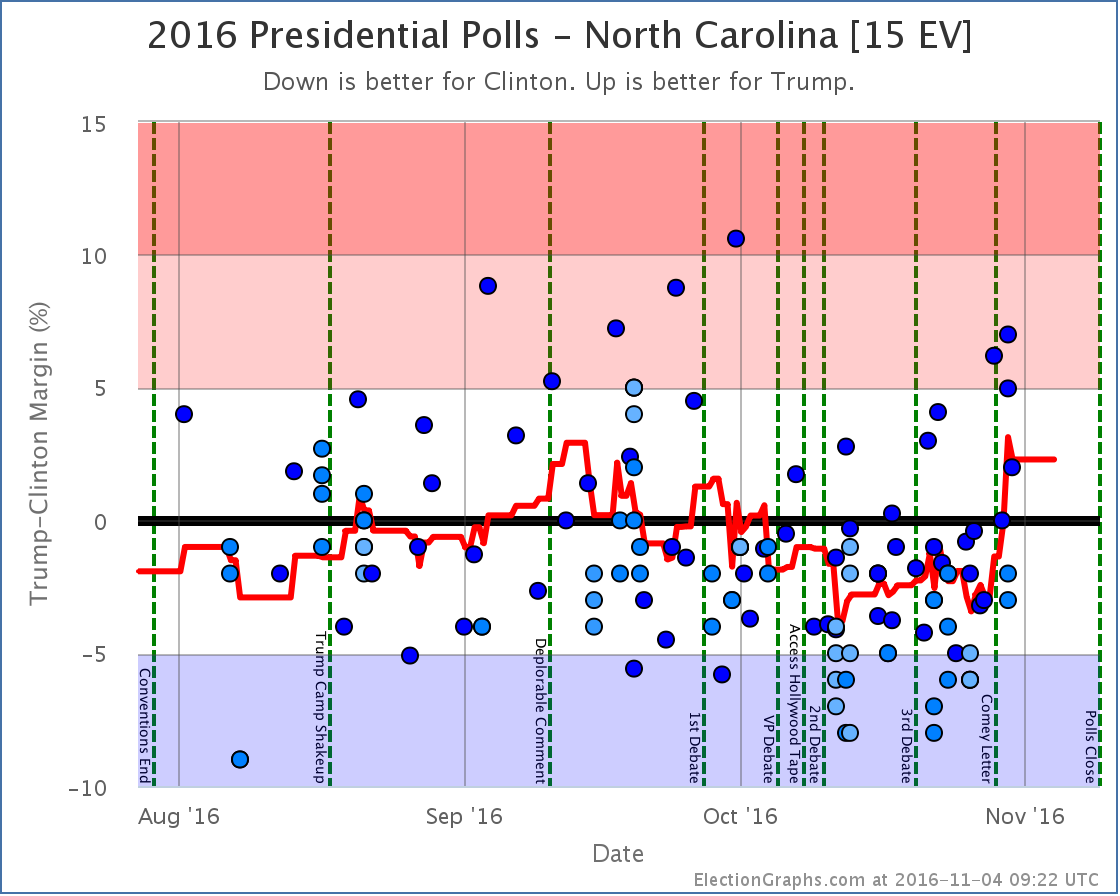
Moving into reach for Trump
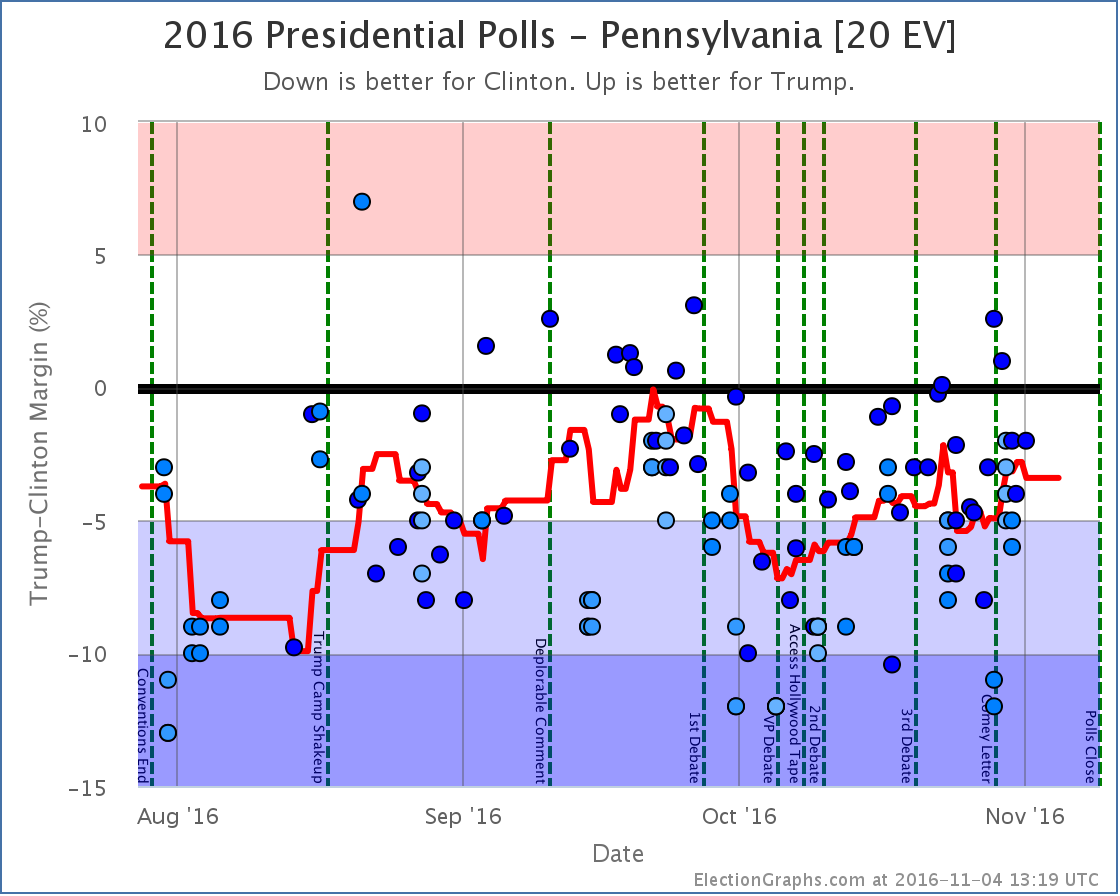
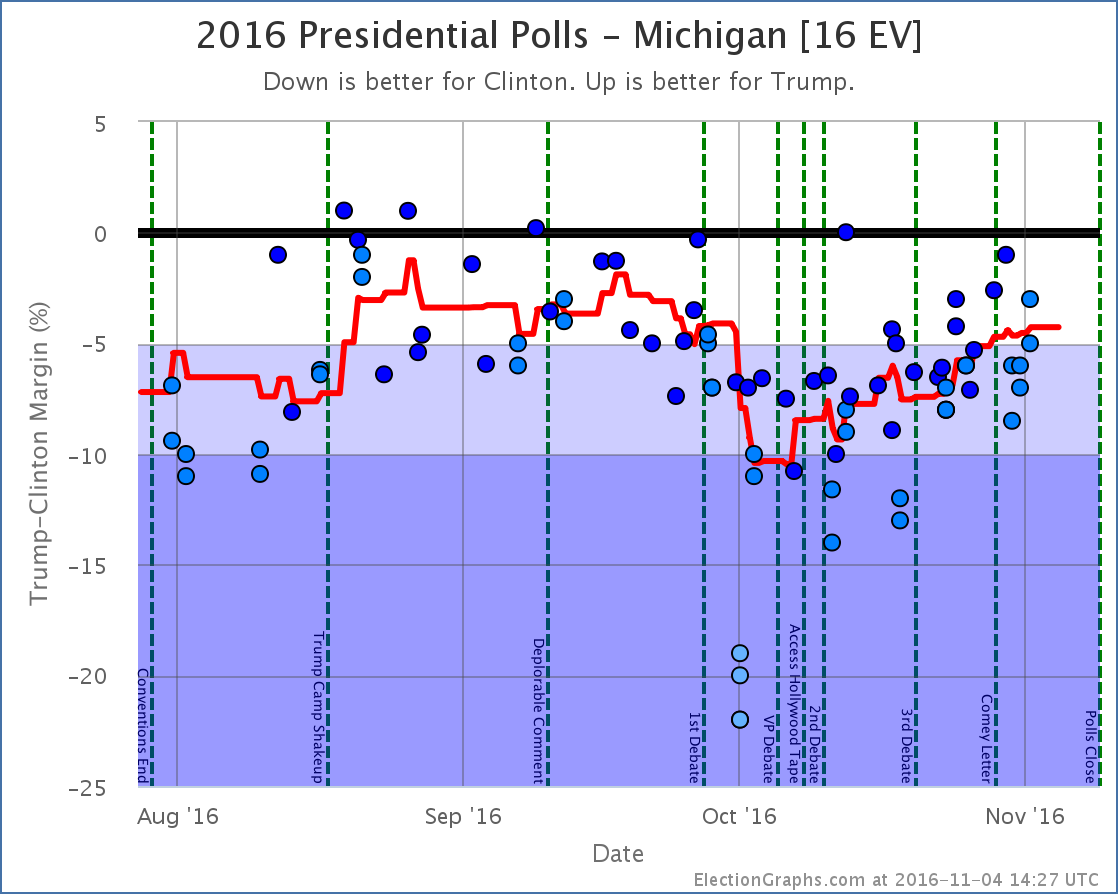
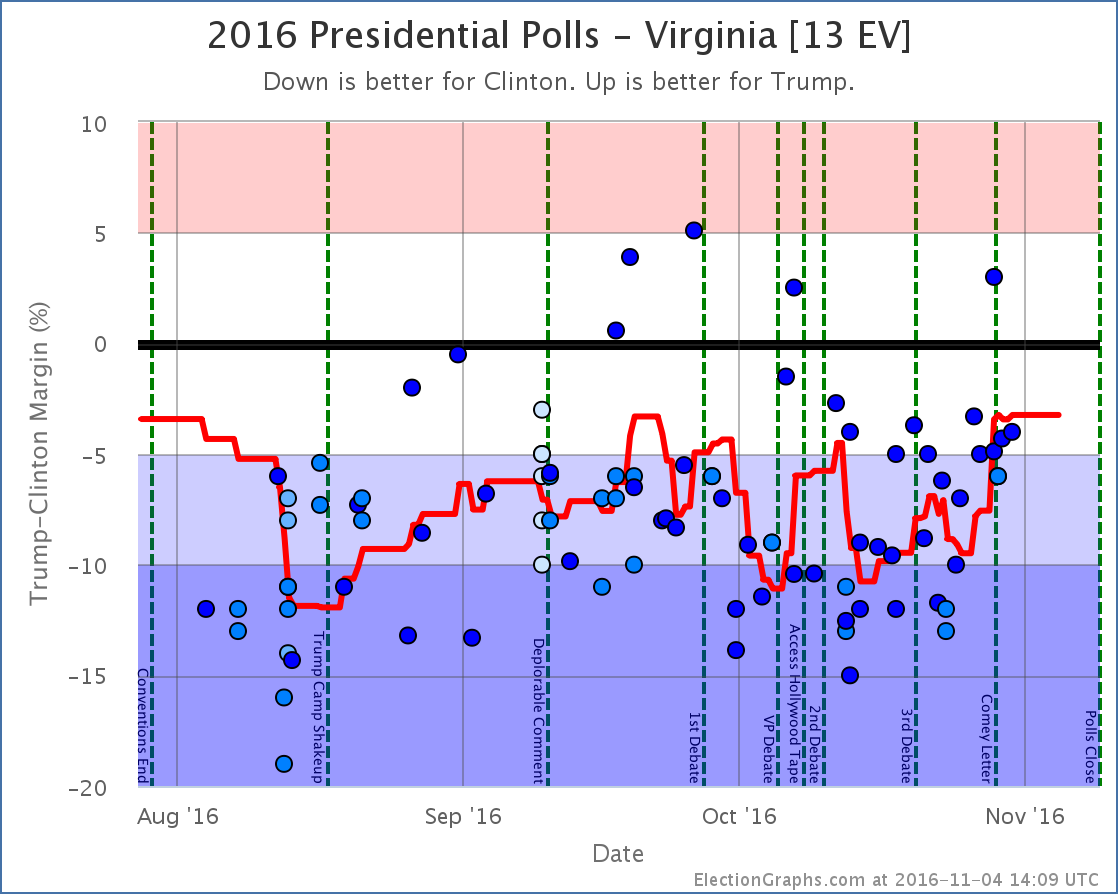
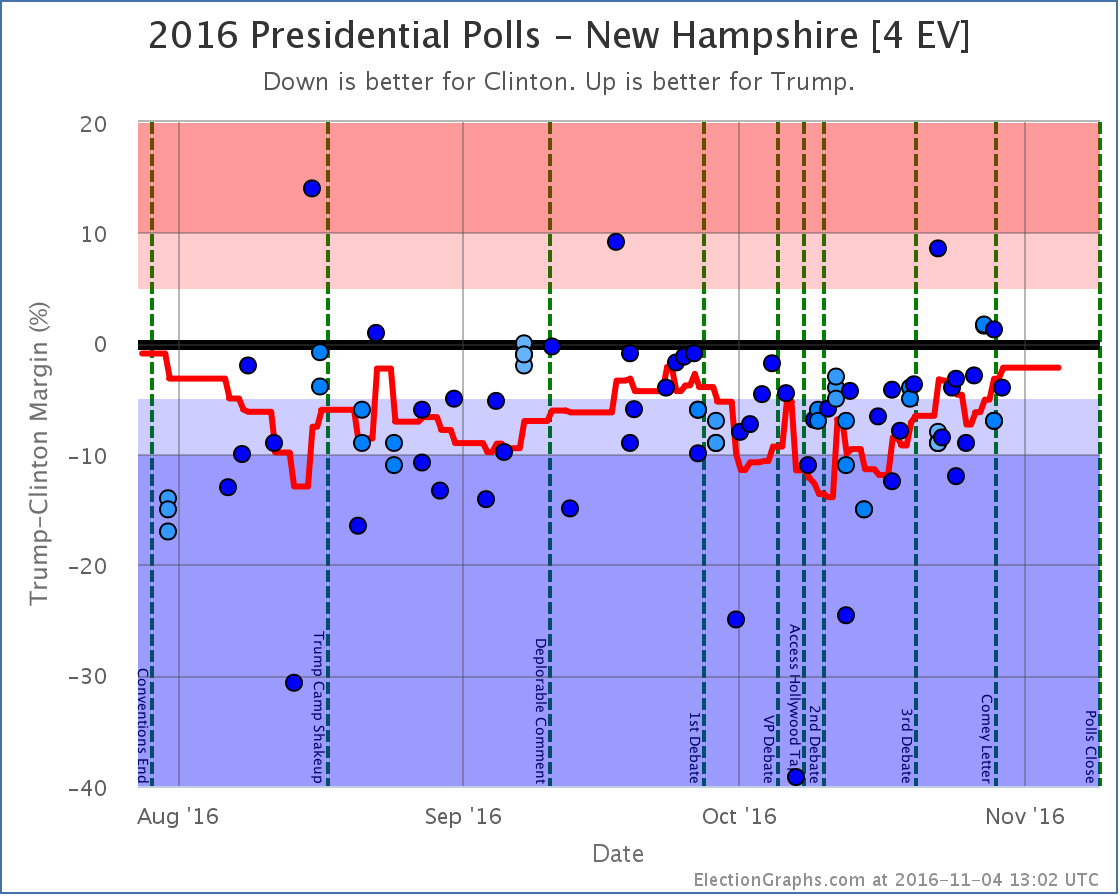
Moving out of Clinton’s reach
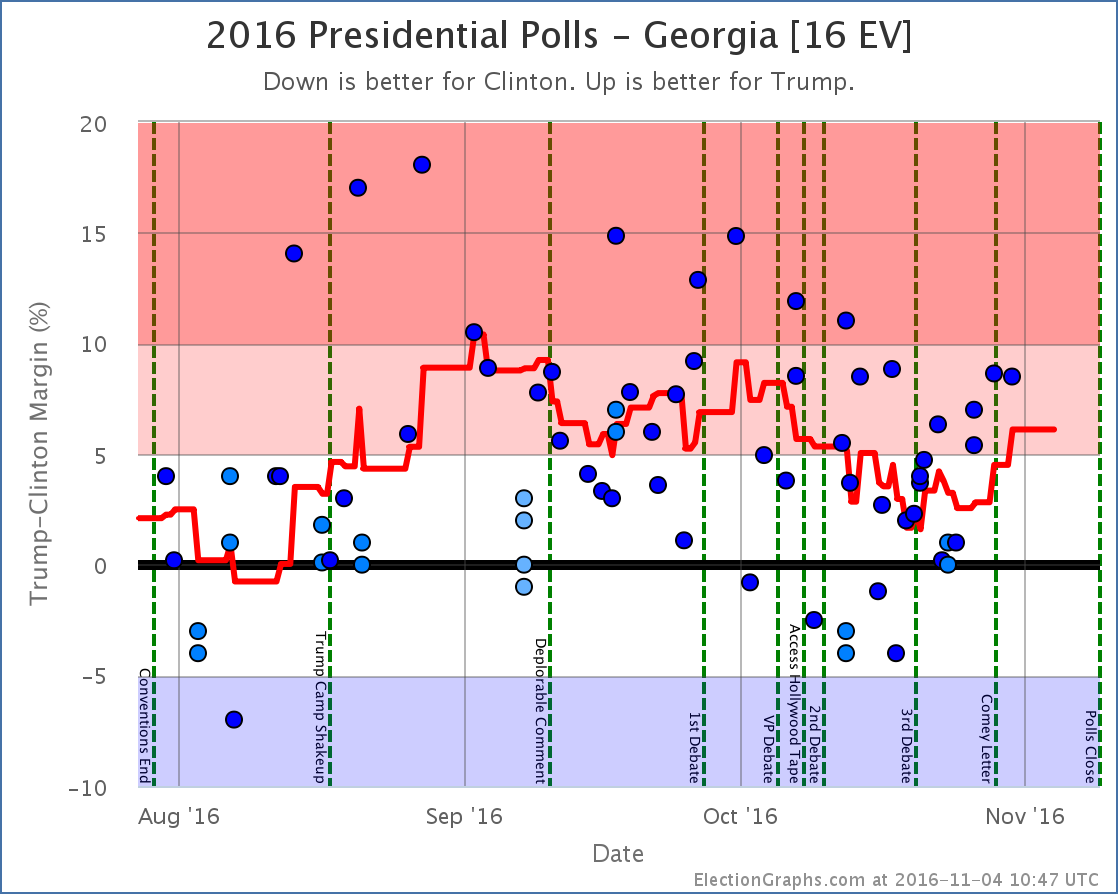
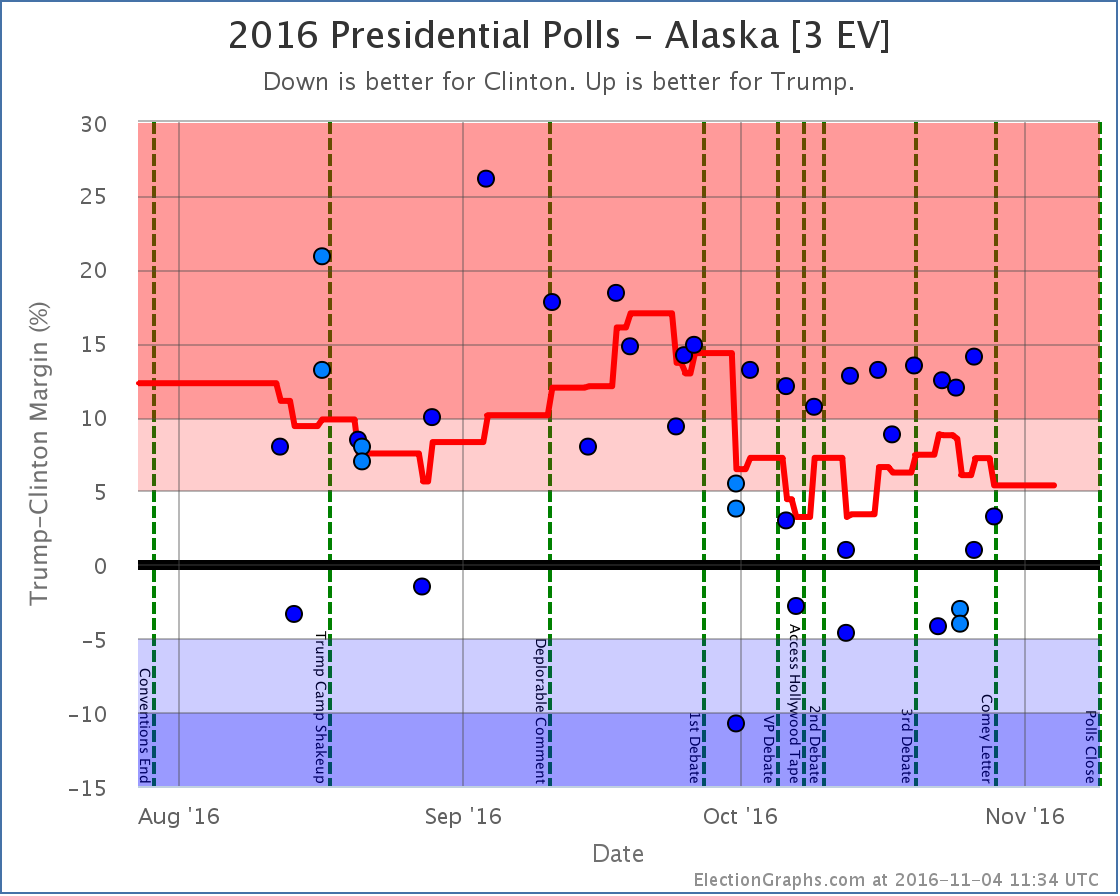
Other states that helped move the tipping point
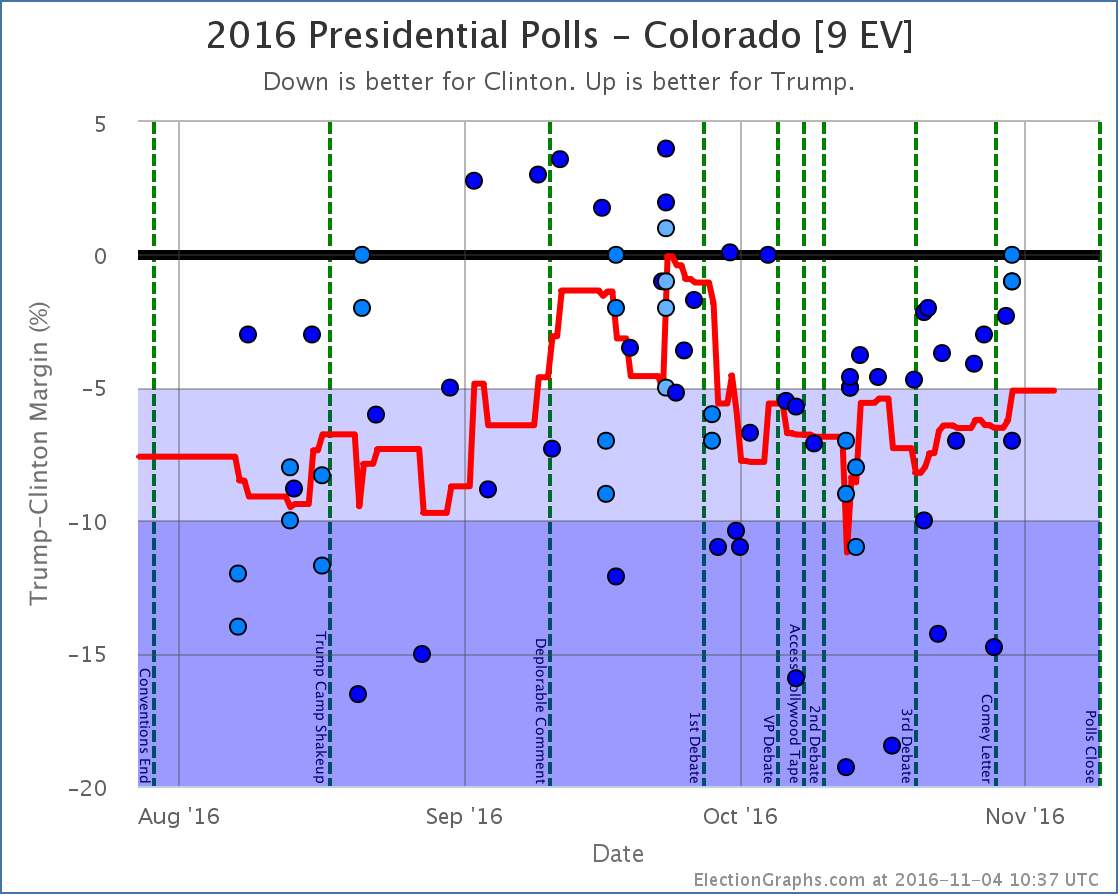
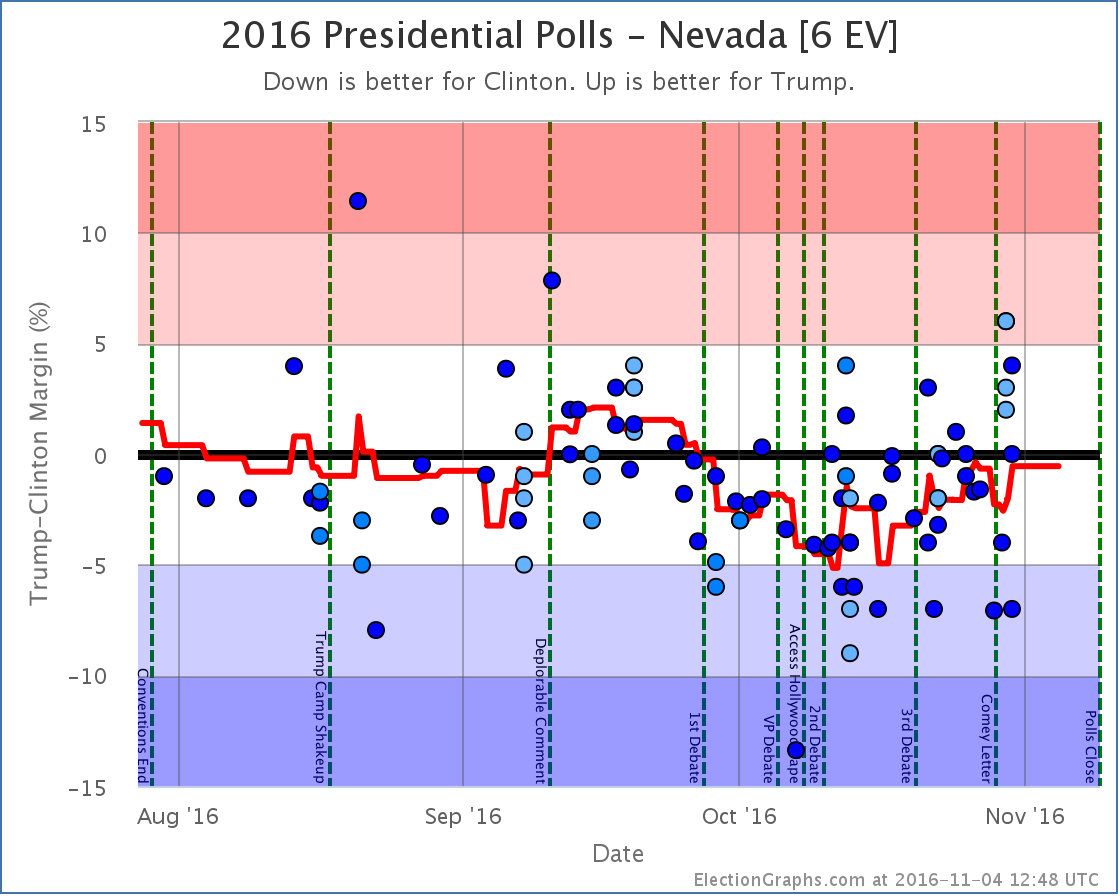
A note about McMullin
Election Graphs is designed around showing the Republican – Democrat margin, and there is not enough time before the election to revamp the site to properly account for 3rd parties that are strong enough to have a shot at winning electoral votes.
Right now the Real Clear Politics average in Utah has McMullin 12.0% behind the lead. The 538 average in Utah has him 10.3% behind the lead. Although McMullin was a lot closer than anyone expected, he never got closer than 5% to the lead in Utah in these averages and now appears to be fading. 538 still has him in second place, but it doesn’t seem likely at this point that he will win electoral votes.
If that changes, I will of course note it in these updates and on the Election Graphs site.
For more information…
This post is an update based on the data on ElectionGraphs.com. Election Graphs tracks a state poll based estimate of the Electoral College. All of the charts and graphs seen in this post are from that site. Additional graphs, charts and raw data can be found there. Follow @ElectionGraphs on Twitter or like Election Graphs on Facebook to see announcements of updates or to join the conversation. For those interested in individual general election poll updates, follow @ElecCollPolls on Twitter for all the polls as they are added. If you find the information in these posts interesting or useful, please consider visiting the tip jar.
Edit 17:45 UTC to fix some wording in the hurricane comparison paragraph.
Edit 19:53 UTC to fix a Comey/Comet autocorrect.
States with new poll data added since the last update: All 50 states, DC, and the Maine congressional districts.
Notable changes in: Florida (29), Pennsylvania (20), Arizona (11), Iowa (6), Kansas (6), Utah (6), Alaska (3), and the tipping point.
National Summary
It has been about five days since the last update. Since then the movement has been decidedly mixed.
Note that as of this update, no polls have been included that contain interviews done after the release of the “Comey Letter”.
Good for Trump:
- The expected result has moved from a 130 EV Clinton win to only a 62 EV Clinton win
- Clinton’s best case has declined from a 234 EV win to only a 216 EV win
Good for Clinton:
- The tipping point moves from Clinton by 4.1% in PA to Clinton by 5.3% in PA
- Trump’s best case declines from a 34 EV win to a 6 EV loss
Charts
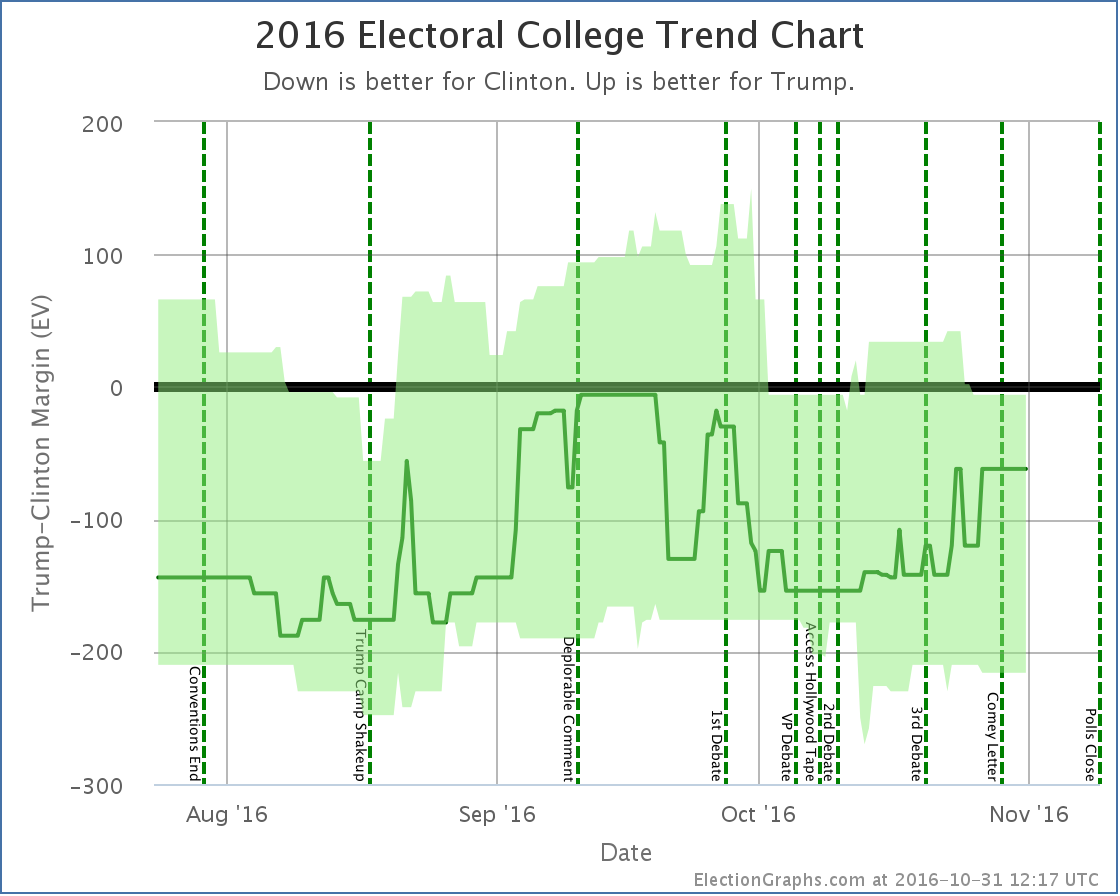
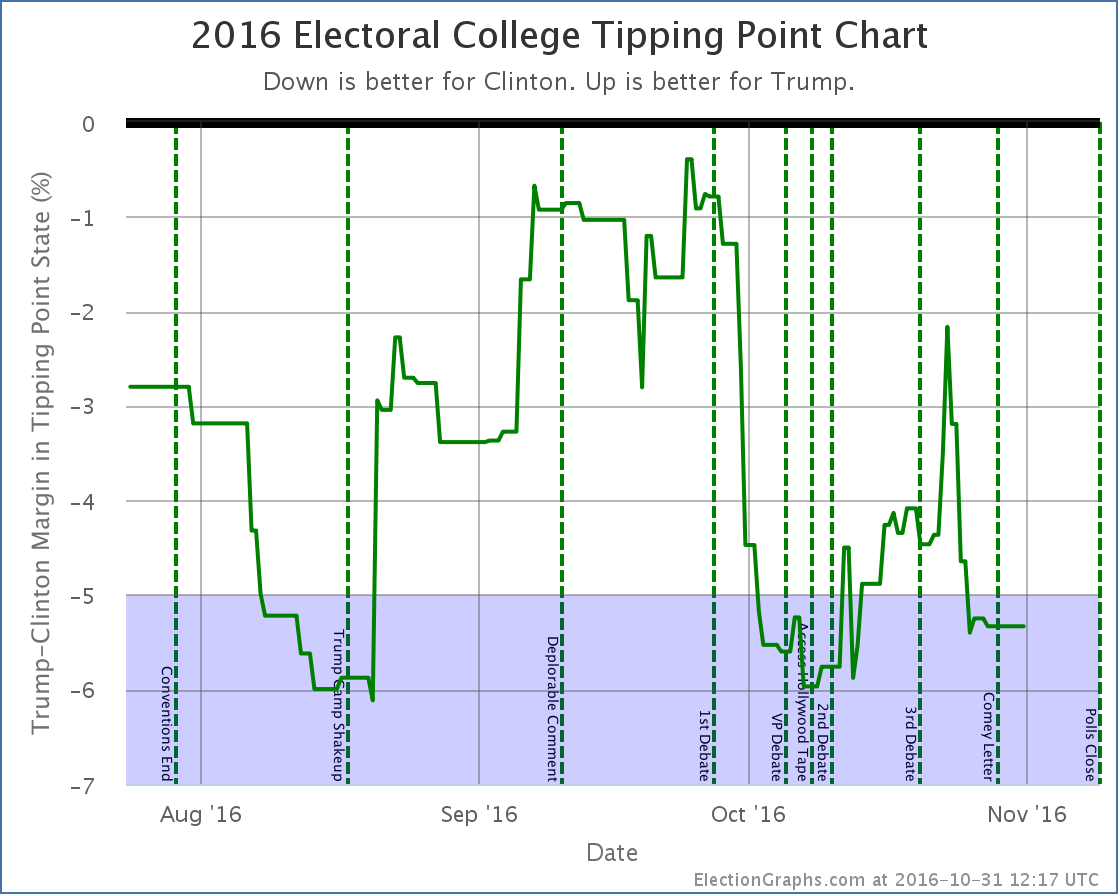
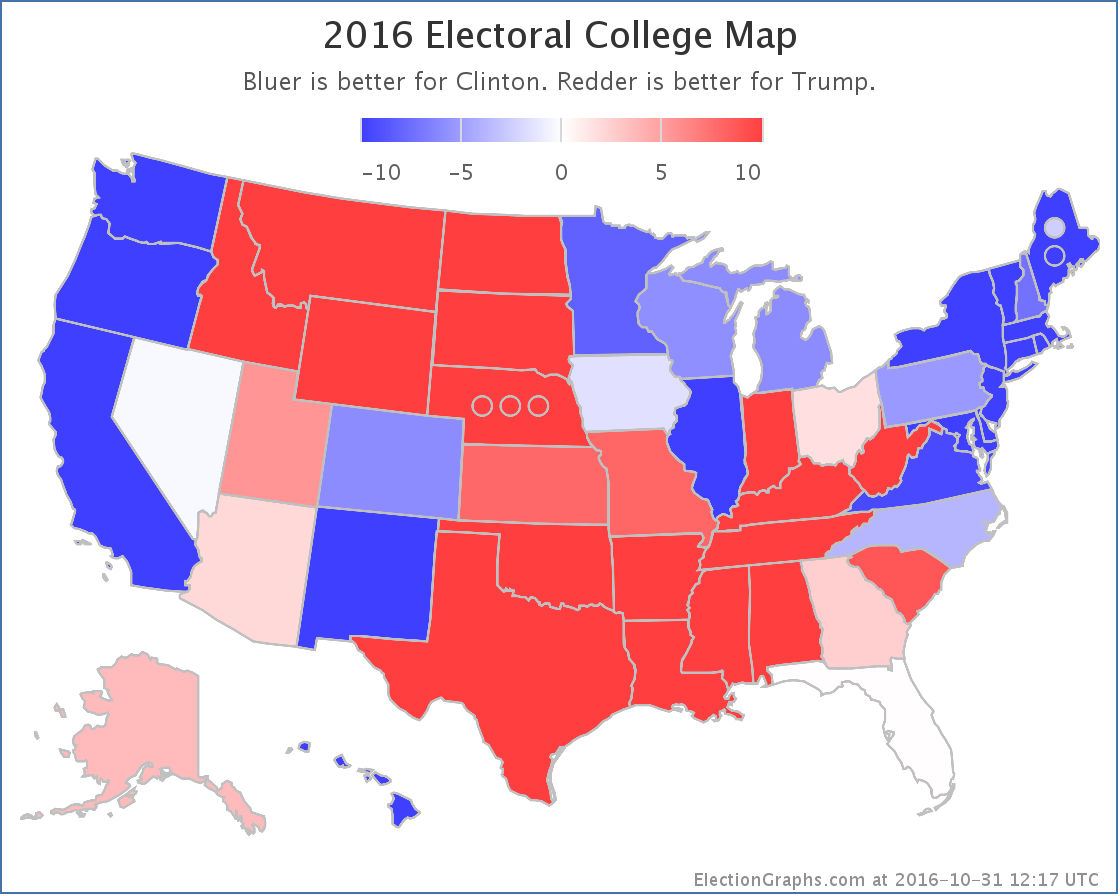
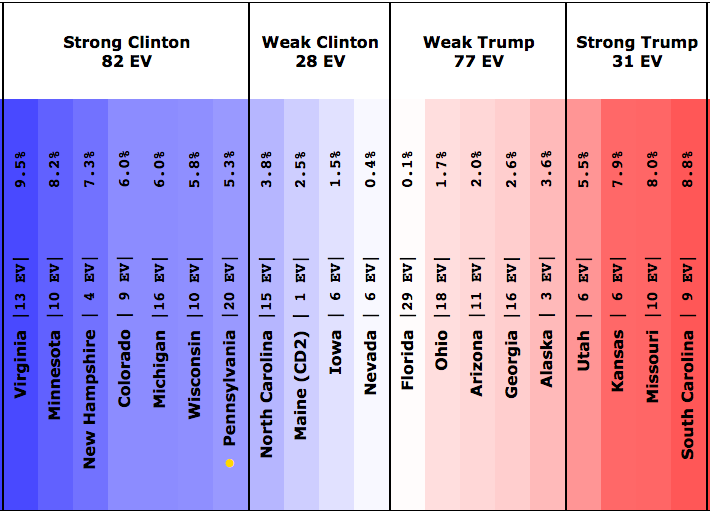
Discussion
While some metrics have moved in Trump’s direction and others in Clinton’s, in the end this picture is bad news for Trump. Why is that? Fundamentally, doesn’t the fact that the “expected case” moved toward Trump mean that he is doing better?
Well, it means the margin he will lose by is getting smaller, yes. However, if you are trying to look for scenarios where Trump would actually catch up and win, the tipping point is what you want to be looking at. To win he has to move the tipping point state (or states he is even further behind in) over to his side of the line. And the tipping point is moving further away at the moment.
If you look at the tipping point chart you can see that Trump had indeed been making progress on the tipping point starting about when the Access Hollywood tape dropped. But that started to reverse around the 23rd. At the same time that his expected electoral college result was still improving.
This is still confusing. What is happening? Well, all the states aren’t moving in lock step in reaction to events. A number of close states have moved toward Trump, like Florida for instance. But key states like Pennsylvania have been moving away from him. Because of this divergence, we can have Trump improving his electoral college “score” while simultaneously the path to 270 electoral votes gets harder.
And in fact, at the moment, 270 looks out of reach for Trump. Look at the spectrum of the close states above. Right now Trump could win every state he is ahead in, then also pull over the states where he is close… Nevada (0.4% Clinton lead), Iowa (1.5% Clinton lead), Maine CD2 (2.5% Clinton lead), and North Carolina (3.8% Clinton lead)… and Trump would still lose by 6 electoral votes.
To win, Trump has to win all of the close states, plus Pennsylvania, where Clinton has a 5.3% lead at the moment… or one of the other larger “Strong Clinton” states… Wisconsin, Michigan, Colorado, Minnesota, or Virginia… all of which Clinton currently leads by even bigger margins. (New Hampshire isn’t enough to push Trump over the edge with only 4 EV.)
This is a really big pull with so little time left. The Trump side seems to be hanging their hopes on the fallout from the Comey Letter. This may cause some movement, but early indications are that almost all voters made up their minds on the Clinton email issue and if it mattered to them long long ago, and this is unlikely to change many minds.
We’ll start to see if there is any movement due to the letter within a few days. But there just are not that many days left. Sites that give odds for Trump winning range from less than 0.01% on the low side to 24.4% on the high side. The median odds seem to be around 5%. That isn’t impossible. But those odds are low enough that a Trump win would be a very big surprise.
There is another goal that Trump has a much better shot at though. If the election ends up exactly how things look today, Trump will lose by only 62 electoral votes. That would mean that Trump would do better than both McCain (lost by 192 EV) and Romney (lost by 126 EV). It may not be an actual win, but Trump improving on the performance of both previous Republican candidates may give the message to Republicans that a Trump like candidate in 2020 might be the way to go rather than returning to Romney or McCain style Republicanism.
We shall see.
8.1 days left until we start getting actual election results.
We are almost there.
State Details
The following are the detailed charts for all the states that influenced the national changes outlined above.
Moving from Clinton to Trump
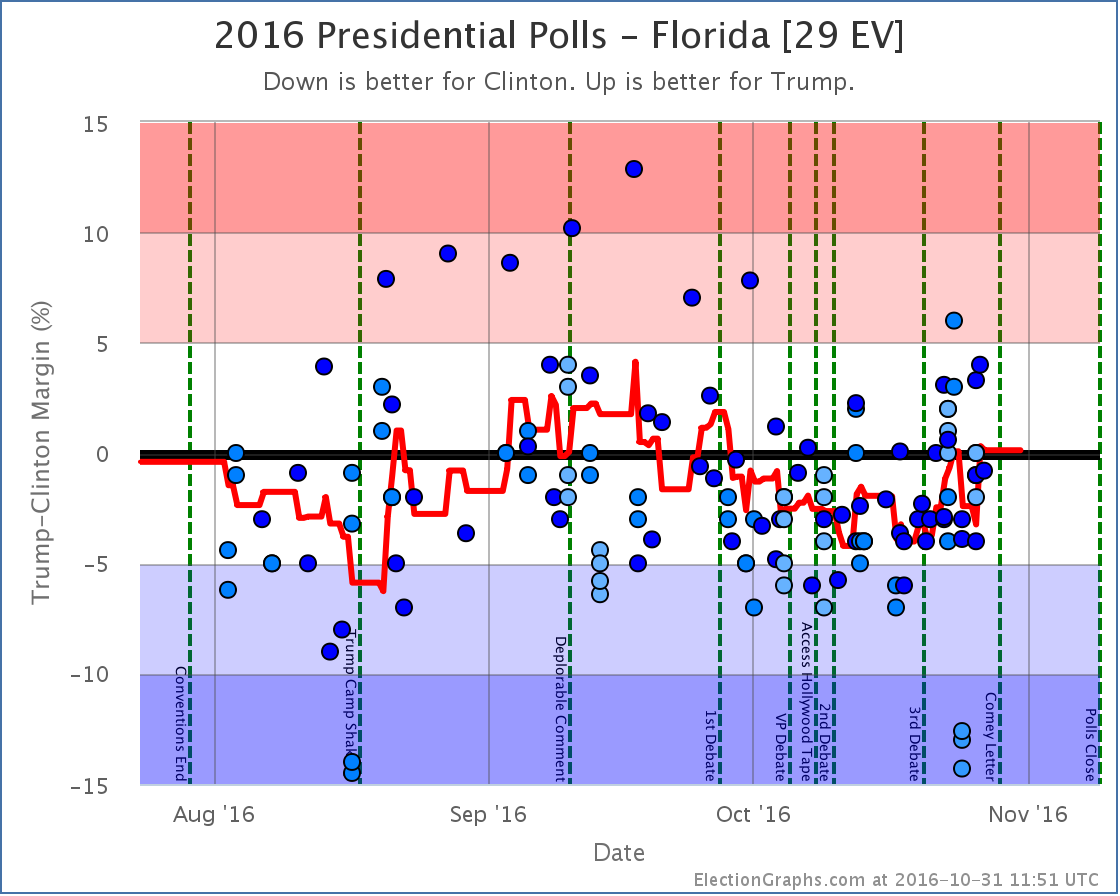
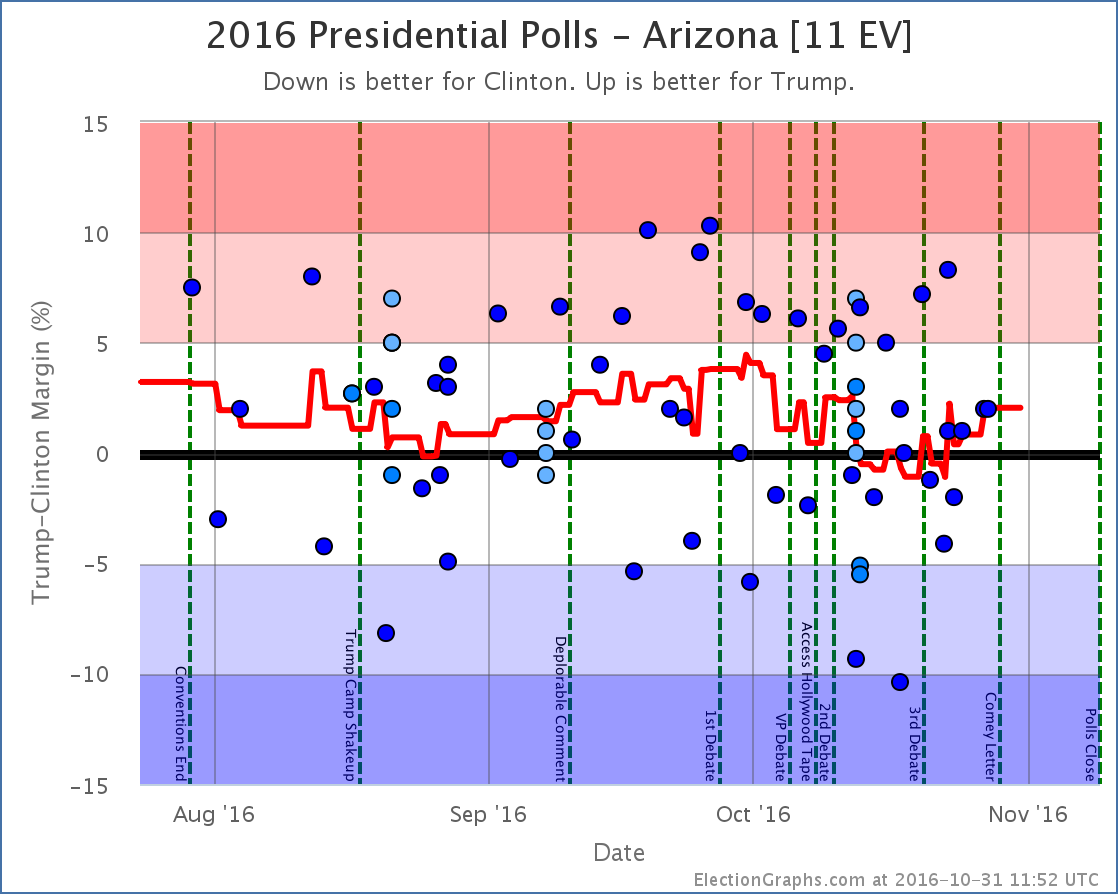
Moving from Trump to Clinton
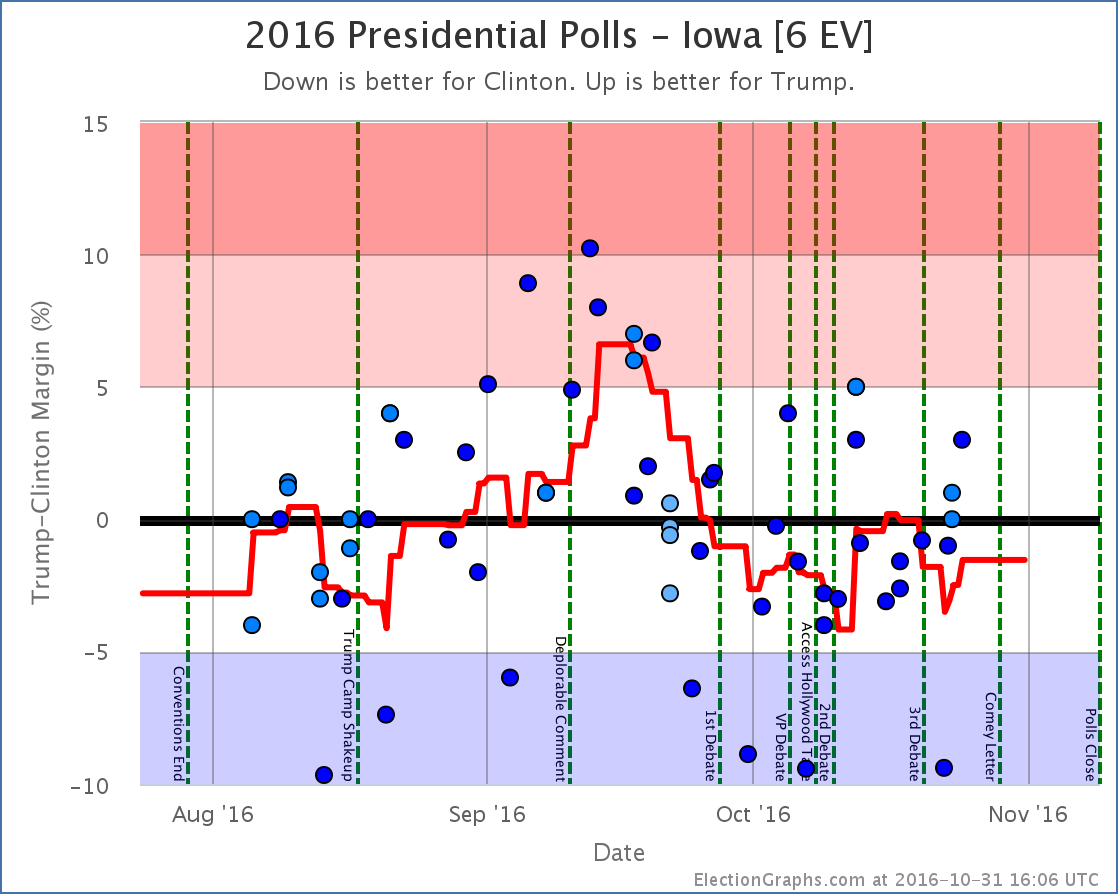
Now a possible Clinton pickup
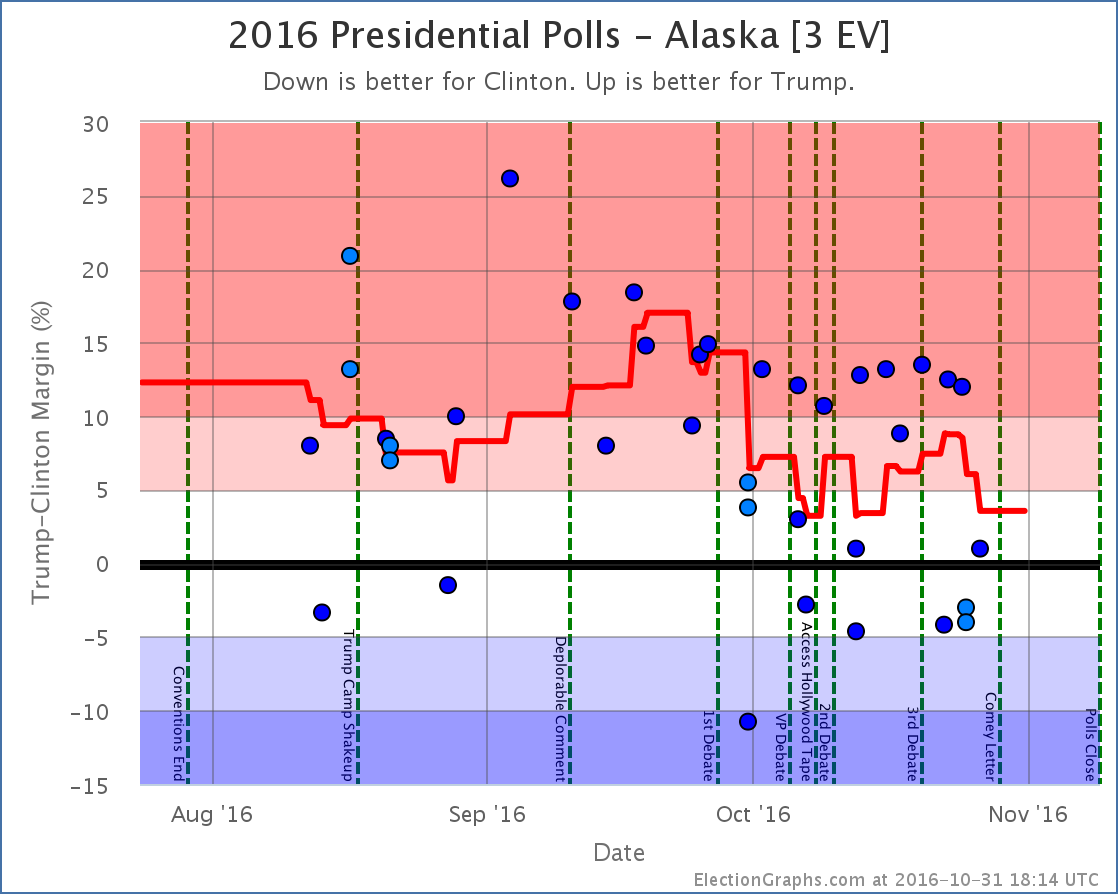
Now out of Trump’s reach
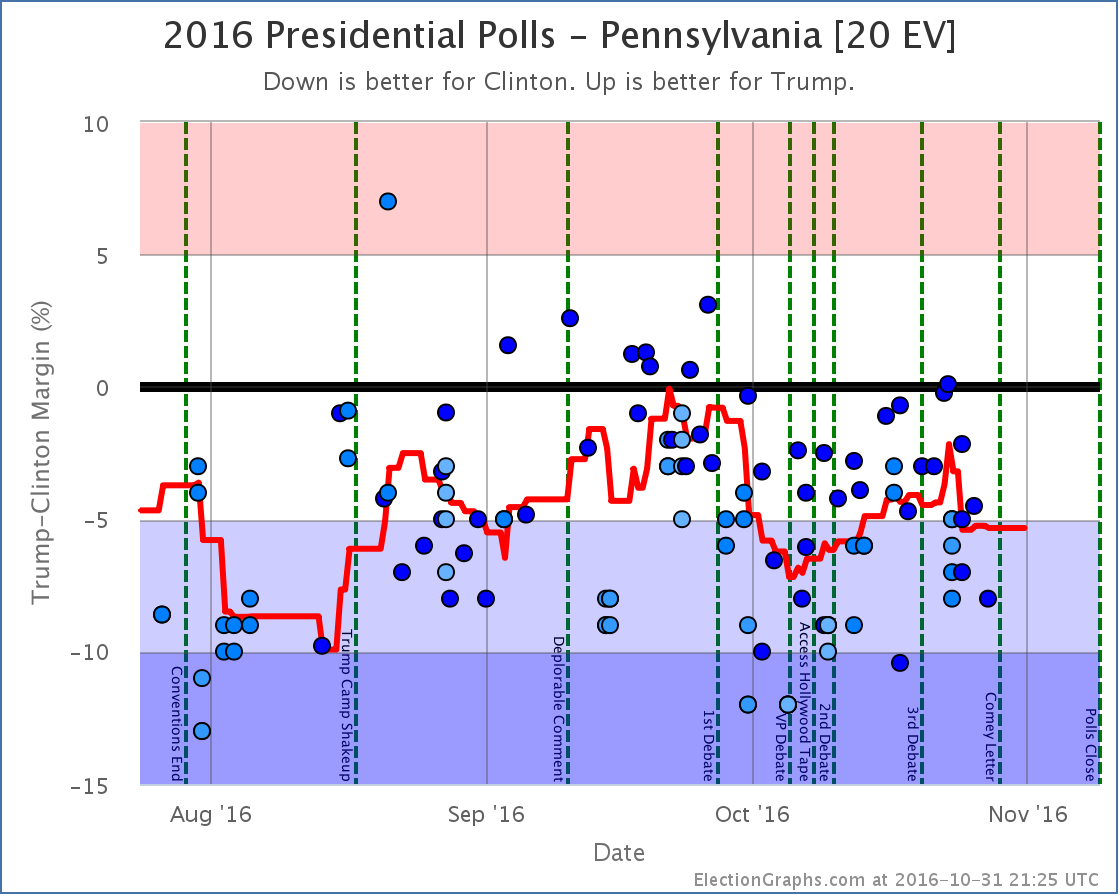
Now out of Clinton’s reach
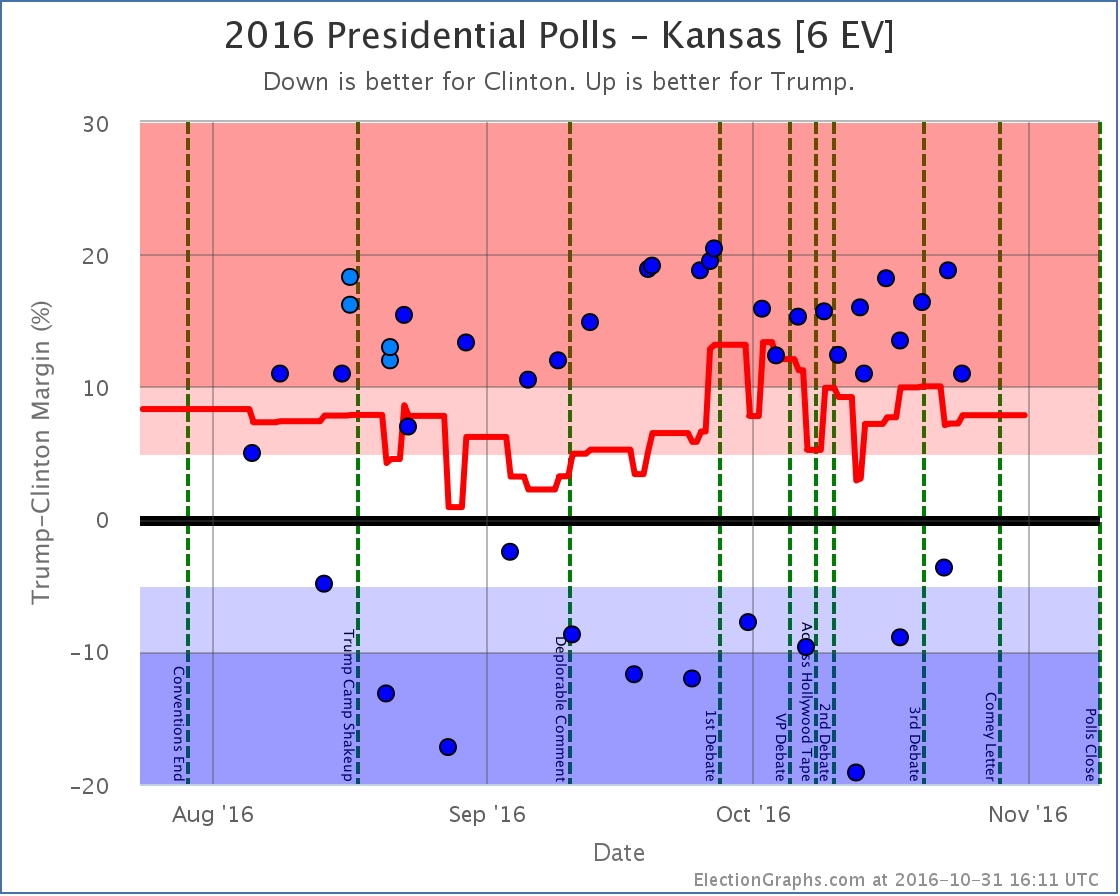
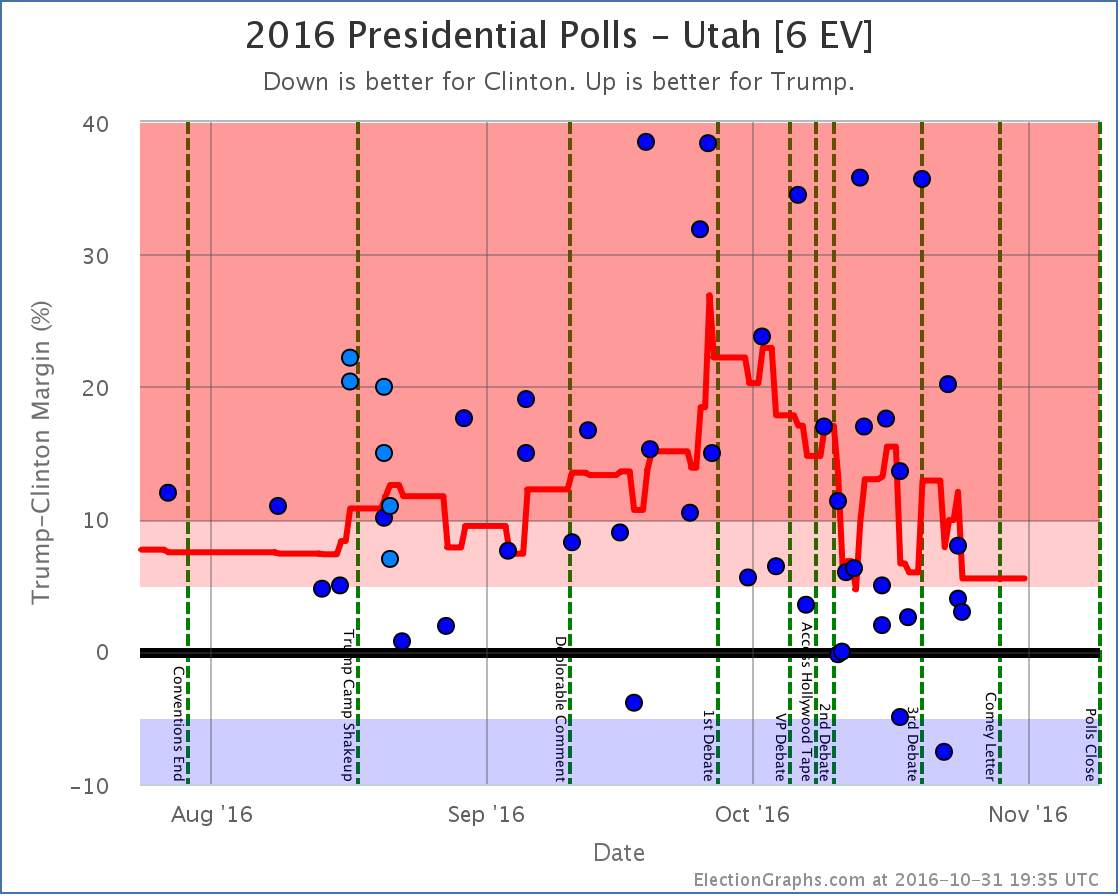
Also influencing the tipping point
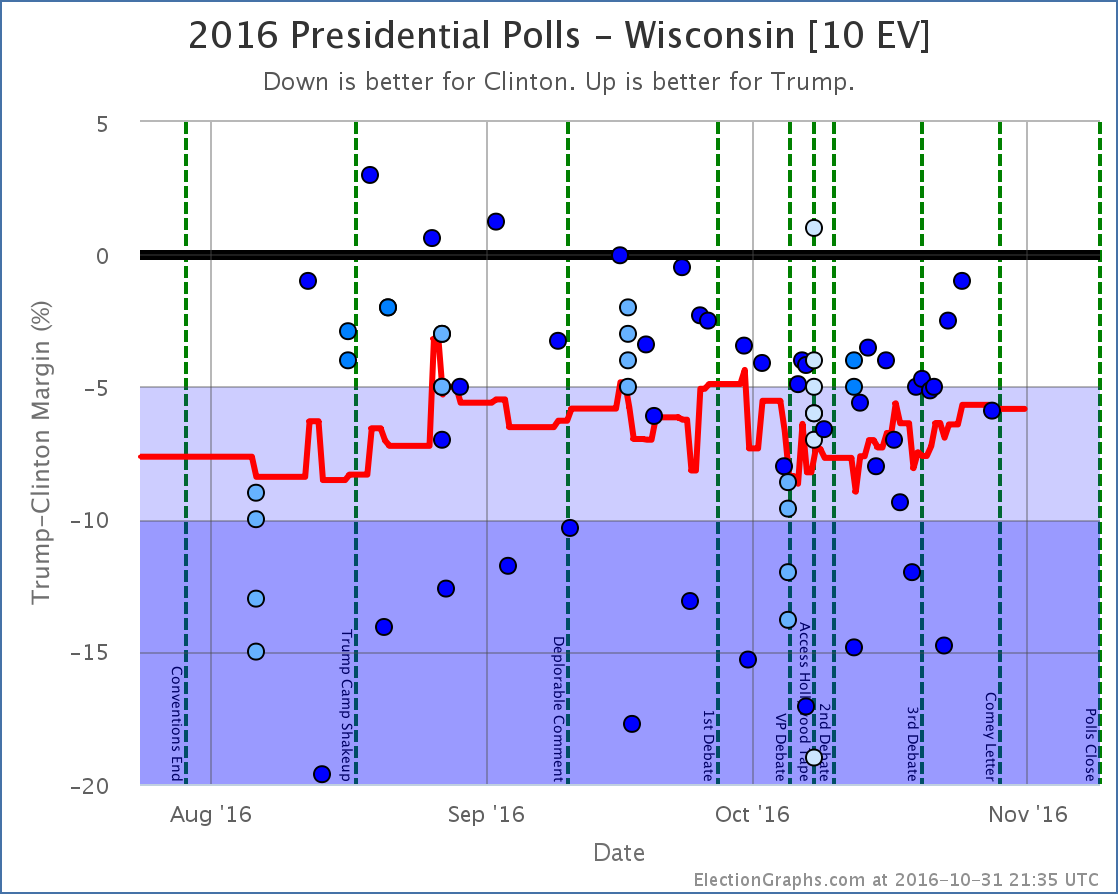
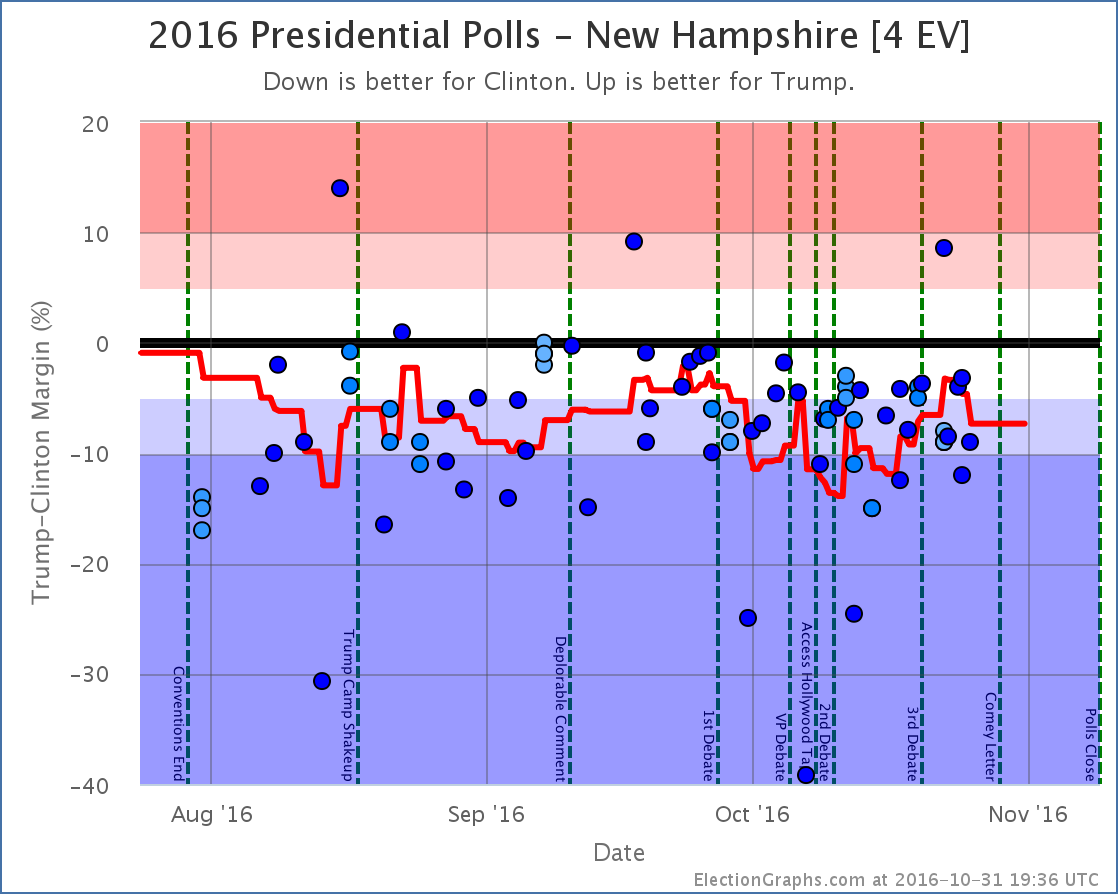
A note about McMullin
Election Graphs is designed around showing the Republican – Democrat margin, and there is not enough time before the election to revamp the site to properly account for 3rd parties that are strong enough to have a shot at winning electoral votes.
Right now the Real Clear Politics average in Utah has McMullin 6.0% behind the lead. The 538 average in Utah has him 7.3% behind the lead. If/when McMullin is within 5% according to either of these averages, I will add notes to both the Utah and National pages about the possibility of McMullin winning Utah’s 6 electoral votes.
For more information…
This post is an update based on the data on ElectionGraphs.com. Election Graphs tracks a state poll based estimate of the Electoral College. All of the charts and graphs seen in this post are from that site. Additional graphs, charts and raw data can be found there. Follow @ElectionGraphs on Twitter or like Election Graphs on Facebook to see announcements of updates or to join the conversation. For those interested in individual general election poll updates, follow @ElecCollPolls on Twitter for all the polls as they are added. If you find the information in these posts interesting or useful, please consider visiting the tip jar.
States with new poll data added since the last update: All 50 states, DC, and the Maine congressional districts
Notable changes in: Iowa, Georgia, Utah, Alaska, Indiana, Missouri, Maine (CD2), and the tipping point
National Summary
It has been about six days since my last update and the trend since then has been toward Trump. Here are the stats:
Good for Trump:
- The expected result changed from a 140 EV Clinton win to a 130 EV Clinton win
- The tipping point moved from Clinton by 4.9% in PA to Clinton by 4.1% in PA
- Clinton’s best case declined from a 238 EV win to only a 234 EV win
No change
- Trump’s best case remained a 34 EV win
Charts
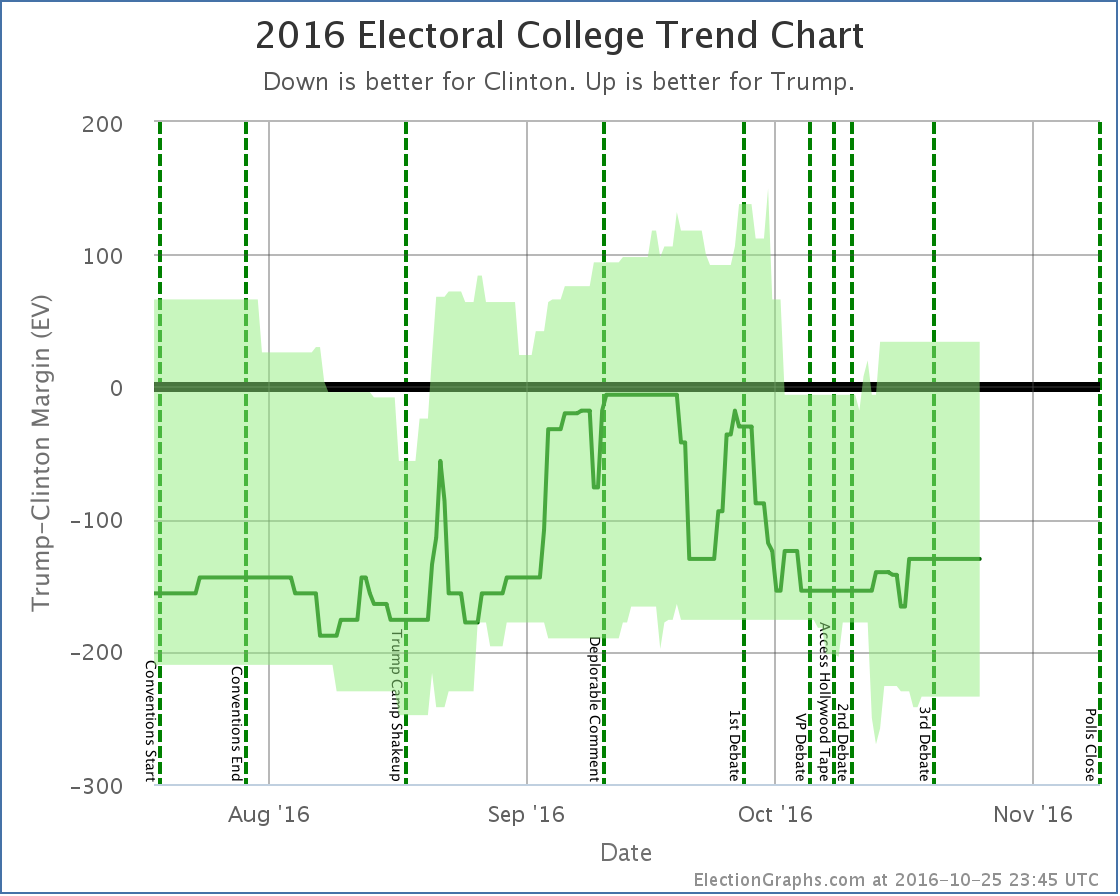
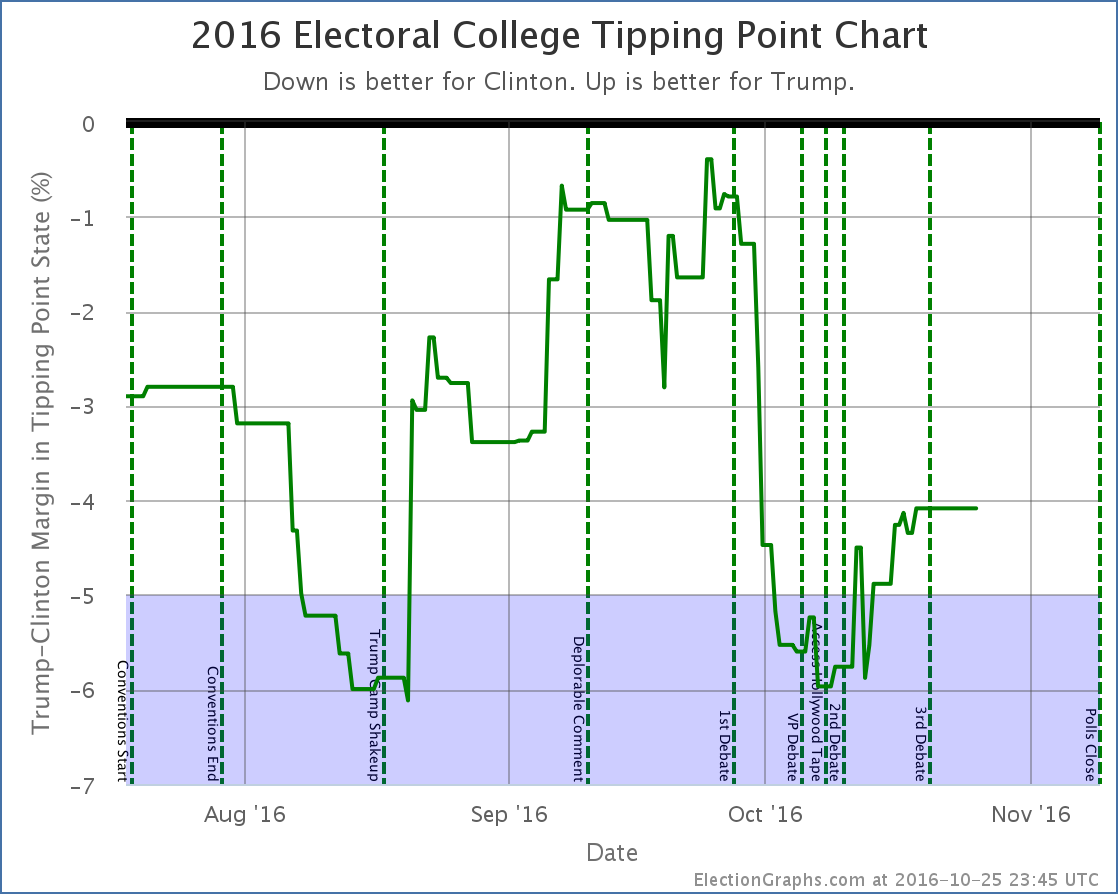
Discussion
With all the data we have now, looking back to the release of “the tape” on October 7th the overall movement has been mixed. Both candidates have improved their “best cases” as states that were not close have gotten closer… on both sides. So this doesn’t show a move toward one candidate or another, but rather some red states getting less red while simultaneously some blue states got less blue.
Some of the really close states moved across the center line… in both directions… resulting in a net movement of the expected electoral college margin toward Trump by 24 electoral votes… but the most indicative sign of movement toward Trump is actually the tipping point.
Since the release of the tape the tipping point has moved from Clinton leading by 6.0% (in Virginia) to Clinton leading by only 4.1% (in Pennsylvania). So… with some of the worst news cycles for a politician in decades, with day after day after day of negative revelations… Trump improved his position by nearly 2%.
How to interpret this? My best guess… Most people were pretty well set on their Trump vs Clinton choice prior to the reveal of the tapes and the subsequent sexual assault allegations. In the wake of the first debate the part of the public that was persuadable had already swung us from near Trump’s ceiling to near Trump’s floor. With the string of additional bad news, very few die hard Trump supporters moved away from him, while some number of those persuadables viewed this as the press piling on Trump and went back to him thinking this was unfair.
But to be honest, the above is trying to make up a story to fit the numbers. Is it right? I don’t know.
In the end though, the reality is that in the face of a hurricane of bad coverage, Trump has actually improved his position.
Despite the improvement, Trump is still losing by a significant margin, but Trump’s best case does still includes a win.
If he keeps all the states he leads, then flips Arizona, North Carolina, Florida and Pennsylvania, he could still pull out a narrow win. Arizona is close enough it could flip back easily enough. North Carolina and Florida have both been back and forth over the past couple months, so seeing them go red again would not be shocking.
Pennsylvania is the hard pull. While he made it close in September, Trump has never led in Pennsylvania. And Trump needs Pennsylvania to win. Right now, this is Clinton’s firewall.
Clinton would clearly like to be leading in Pennsylvania by more than 4.1%… but even at that margin, it is a tall wall for Trump to climb.
There are 13.7 days left until the first polls close. With less than two weeks left to go now, it is almost certainly too late for Trump to flip all the states he would need to flip in order to win. But if he manages to continue the trend of the last couple of weeks, it is enough time for him to make it close enough that Democrats will start to panic.
State Details
The following are the detailed state charts for states that influenced the status changes since the last update.
Weak Clinton to Weak Trump
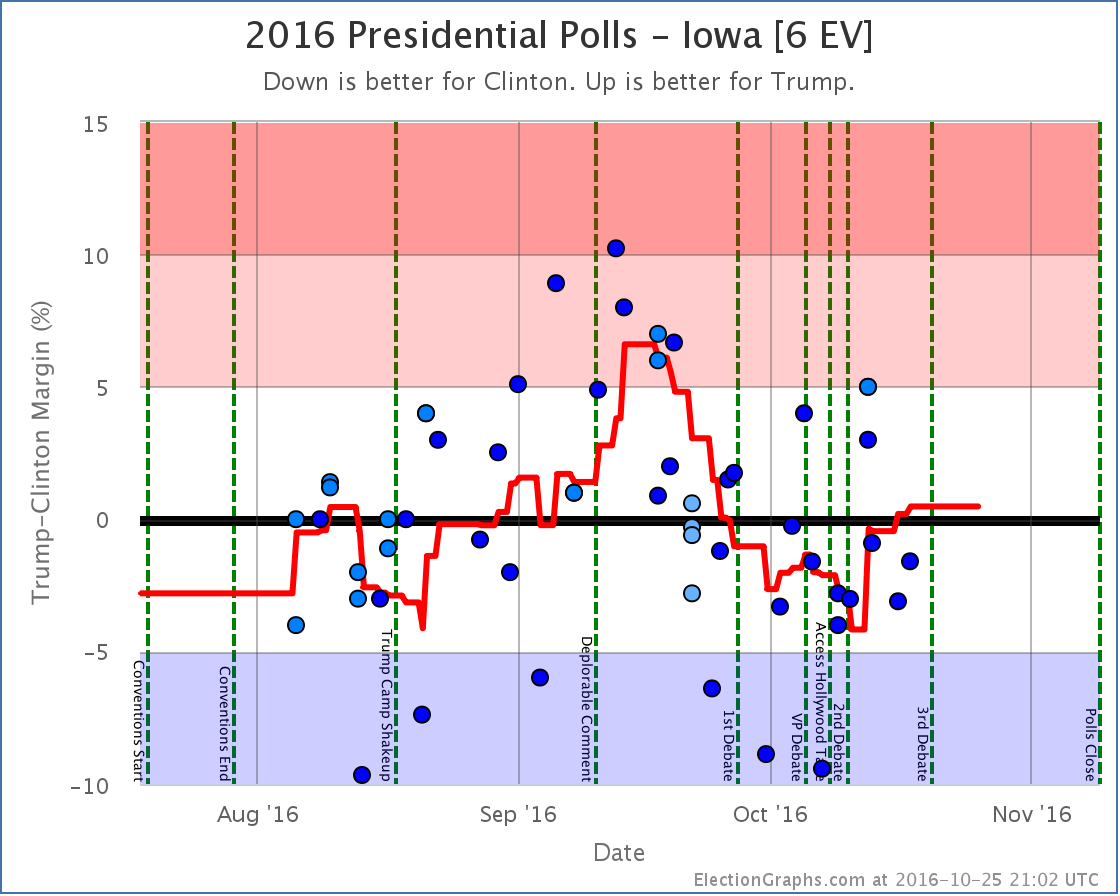
Weak Trump to Weak Clinton
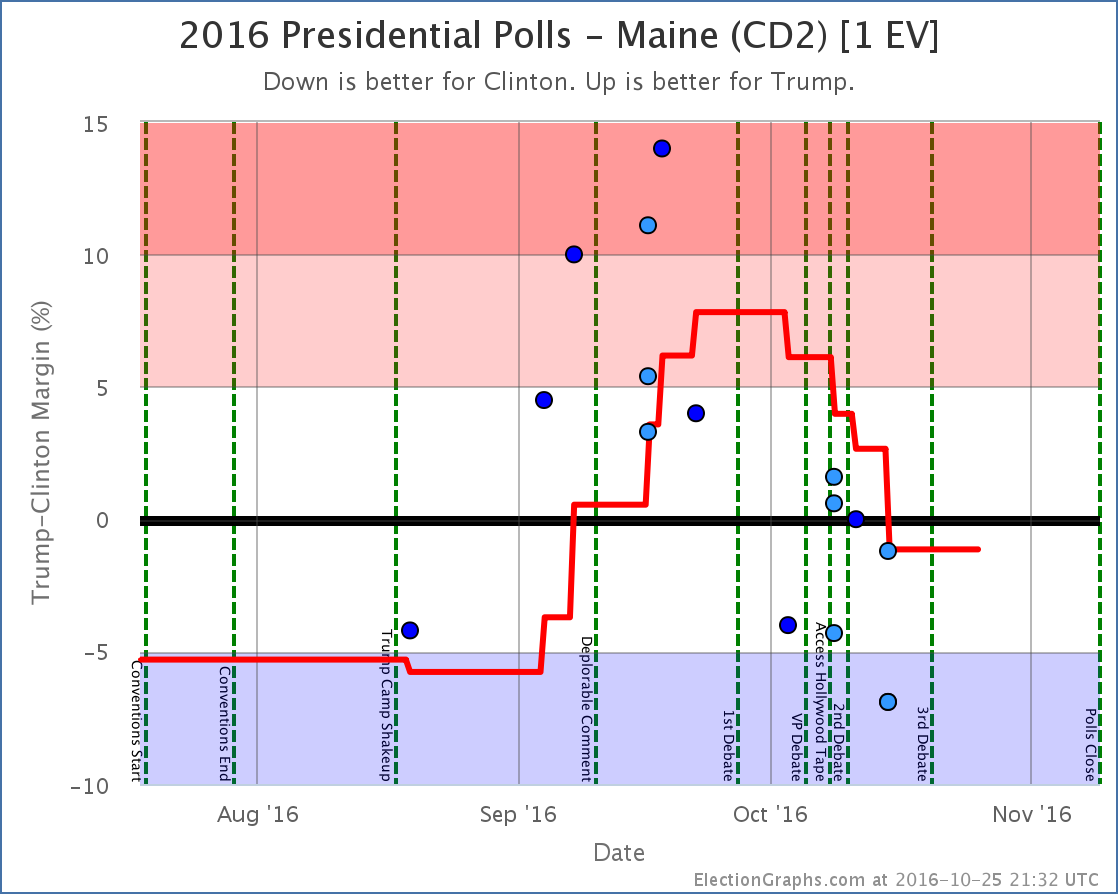
Influencing the tipping point
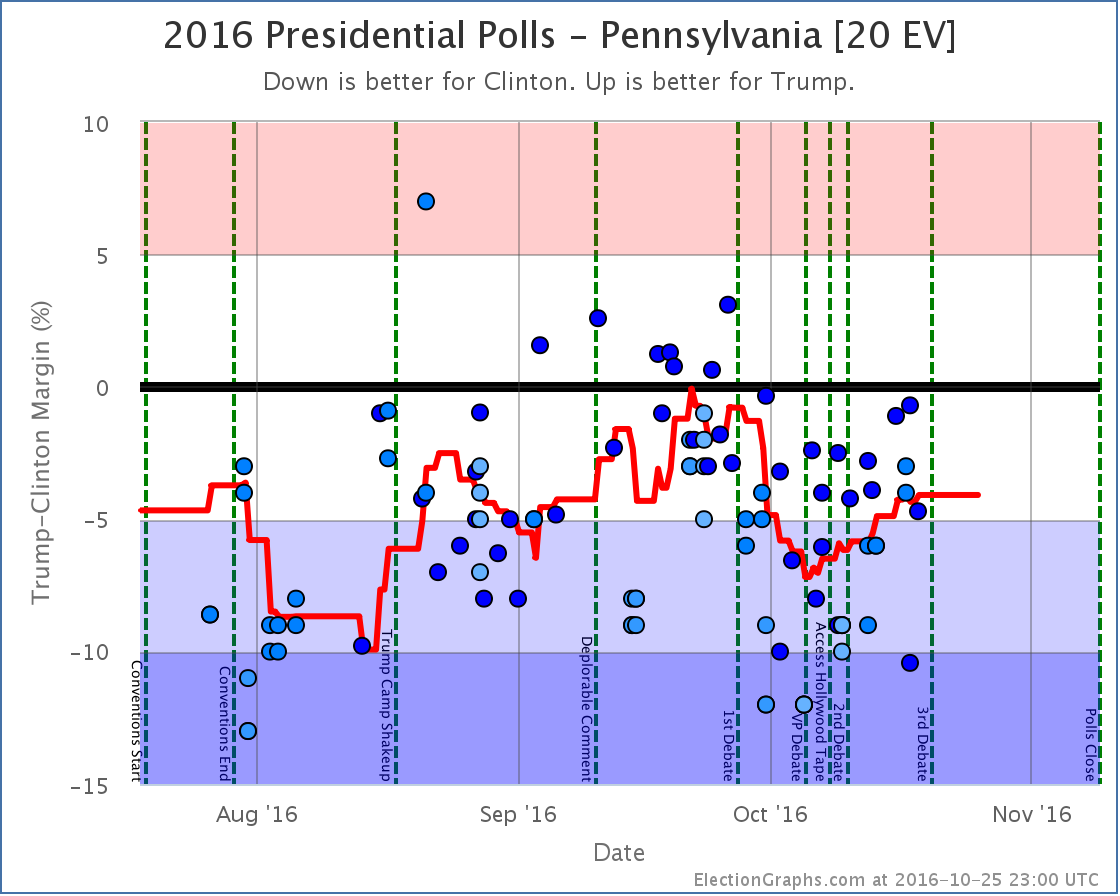
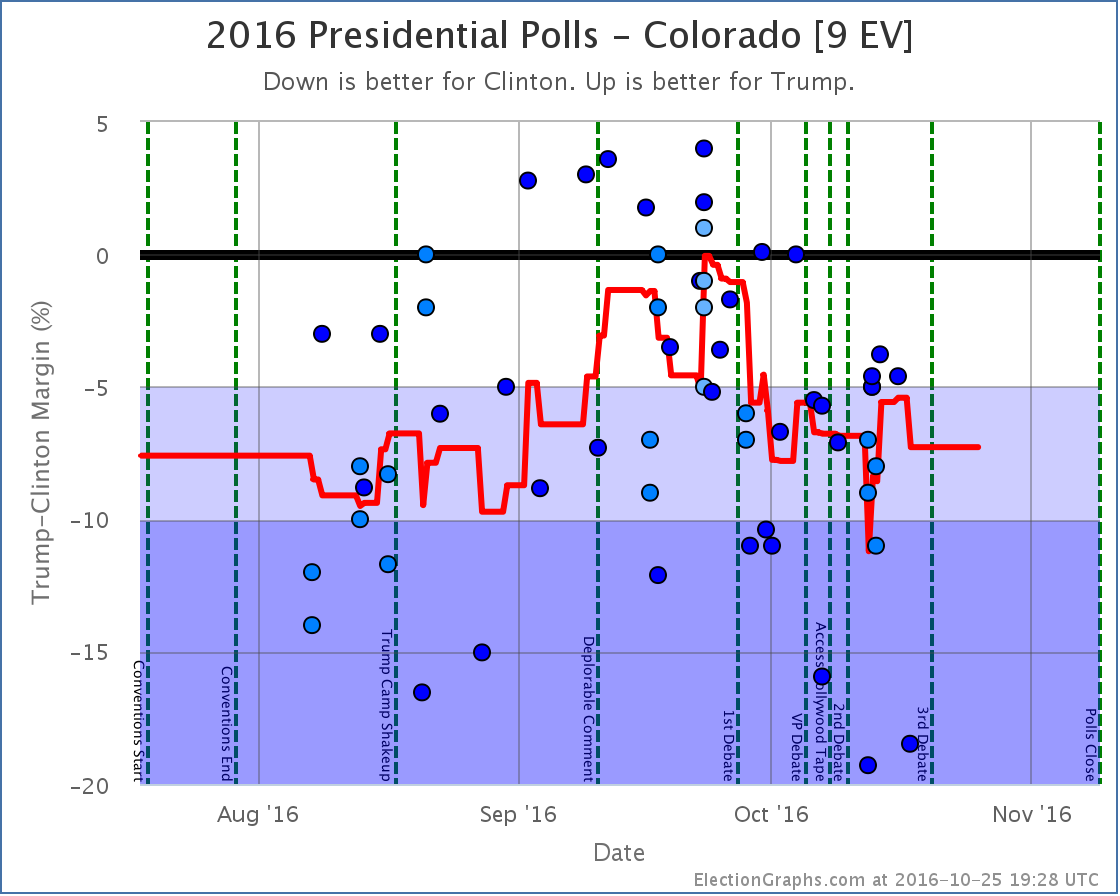
Now possible Clinton pickups
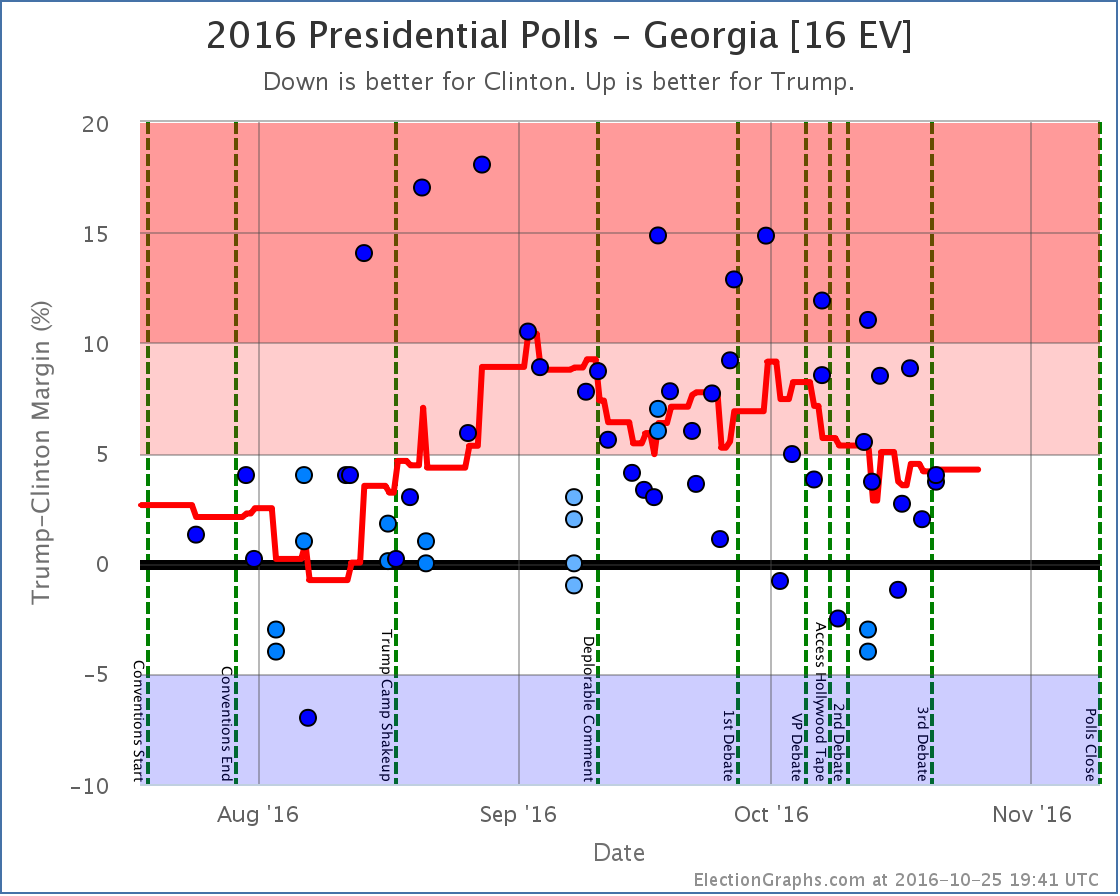
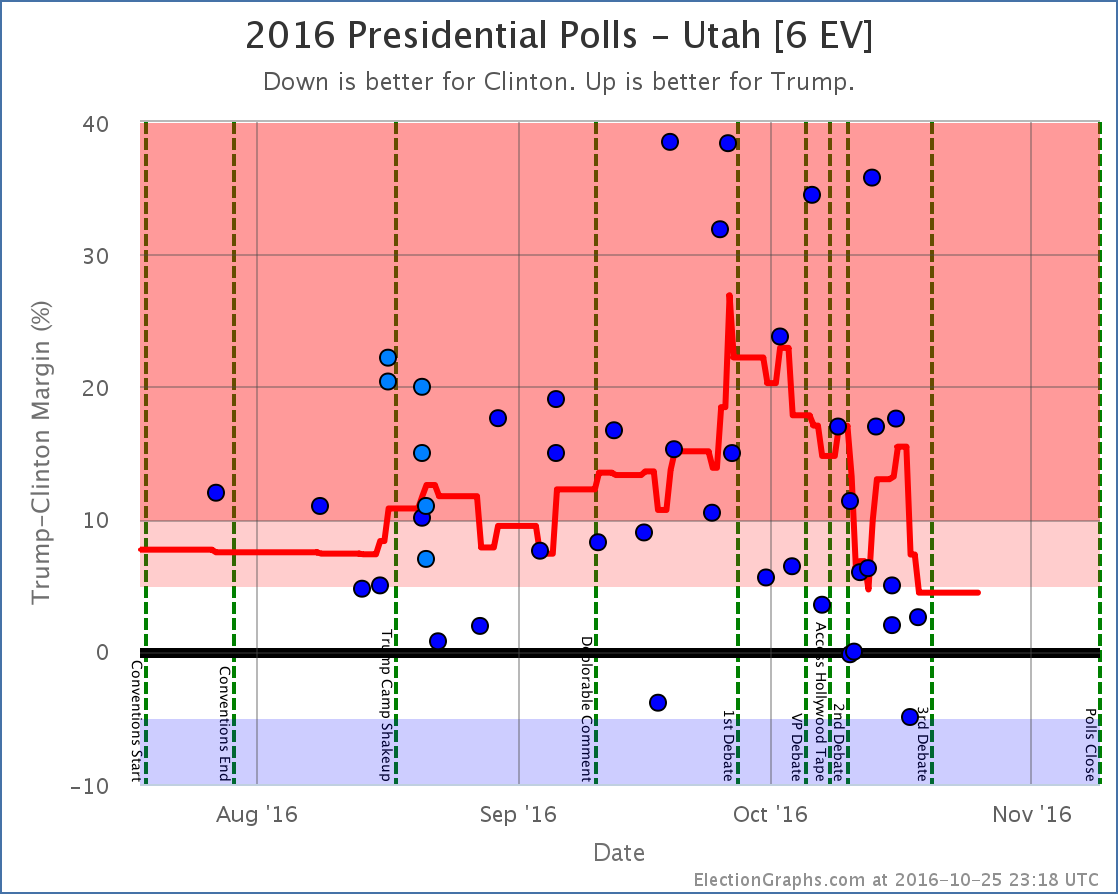
No longer possible pickups for Clinton
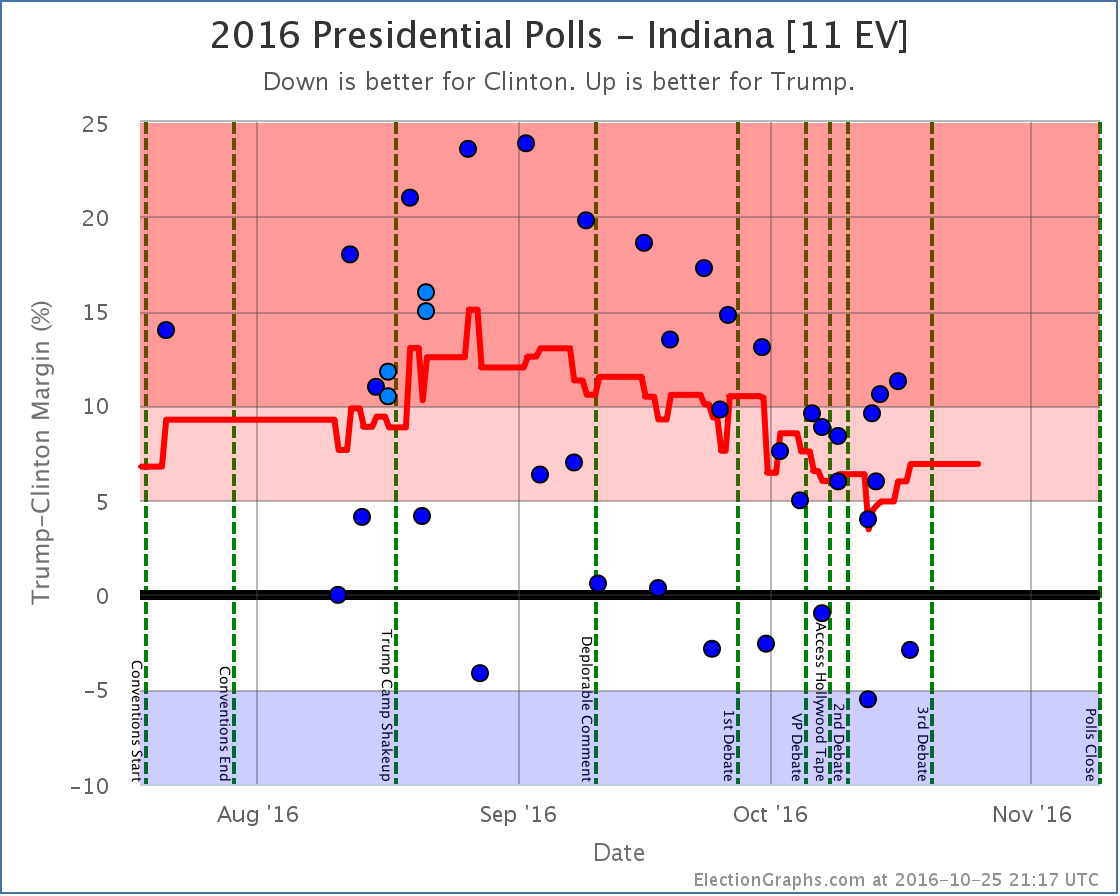
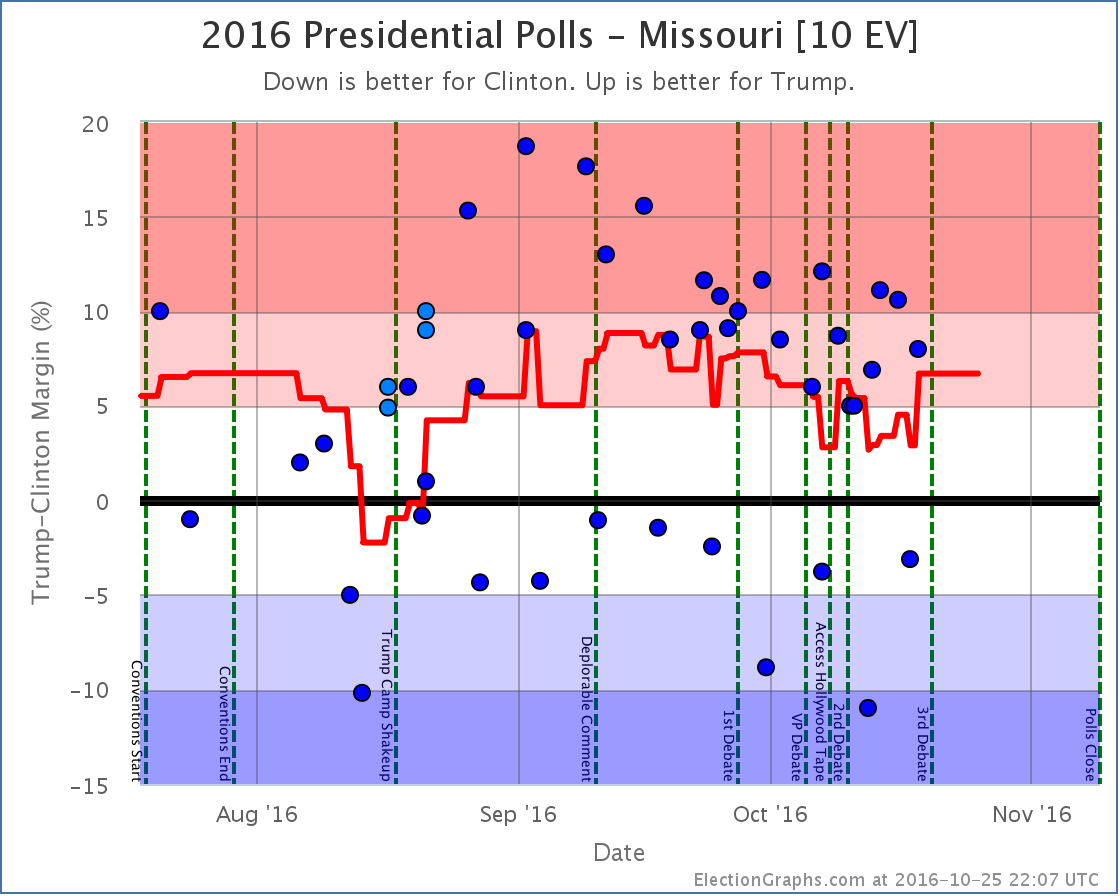
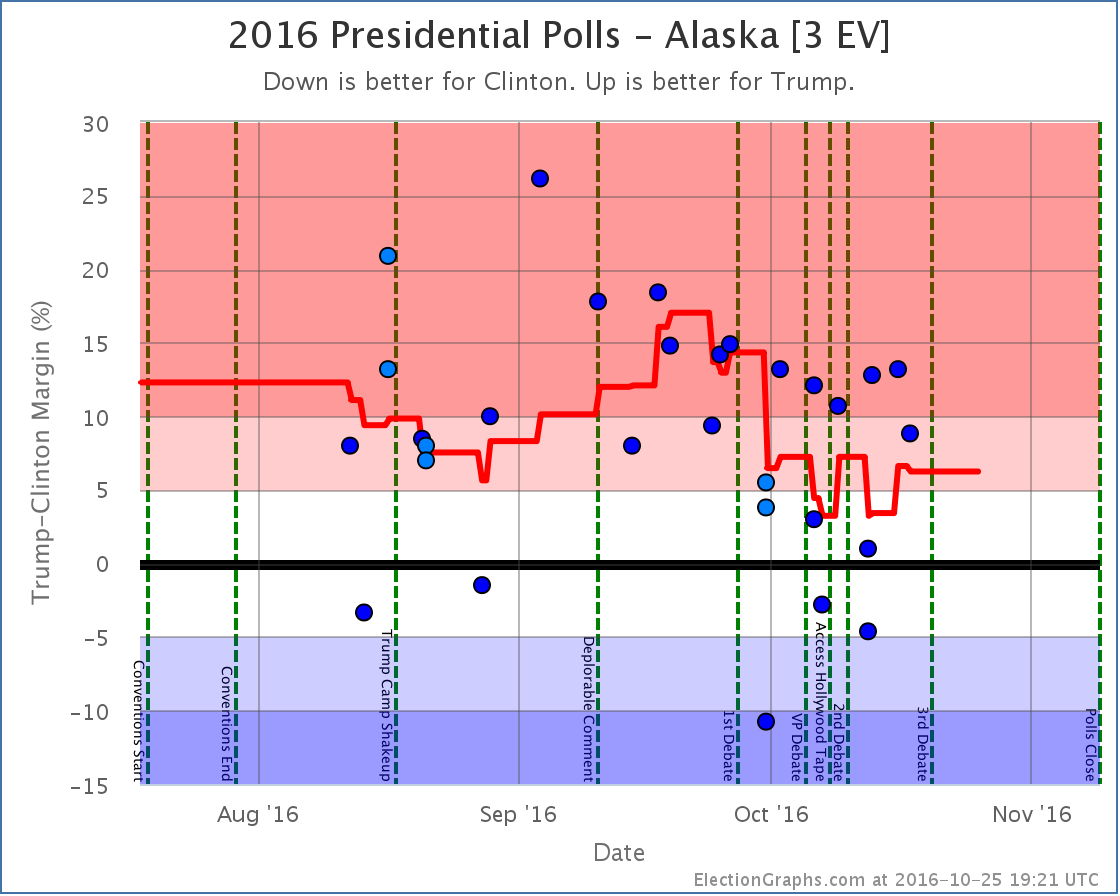
A note about McMullin
Election Graphs is designed around showing the Republican – Democrat margin, and there is not enough time before the election to revamp the site to properly account for 3rd parties that are strong enough to have a shot at winning electoral votes.
Right now the Real Clear Politics average in Utah has McMullin 5.5% behind the lead. The 538 average in Utah has him 8.5% behind the lead. If/when McMullin is within 5% according to either of these averages, I will add notes to both the Utah and National pages about the possibility of McMullin winning Utah’s 6 electoral votes.
For more information…
This post is an update based on the data on ElectionGraphs.com. Election Graphs tracks a state poll based estimate of the Electoral College. All of the charts and graphs seen in this post are from that site. Additional graphs, charts and raw data can be found there. Follow @ElectionGraphs on Twitter or like Election Graphs on Facebook to see announcements of updates or to join the conversation. For those interested in individual general election poll updates, follow @ElecCollPolls on Twitter for all the polls as they are added. If you find the information in these posts interesting or useful, please consider visiting the tip jar.
States with new poll data added since the last update: All 50 states and DC.
Notable changes in: Ohio, Arizona, Indiana, Kansas, Pennsylvania, and the tipping point
National Summary
Despite the widespread view that the time between the Vice Presidential debate and the present has essentially been non-stop bad news for Trump that could only cause his number to fall, and the fact that the national popular vote numbers do show this kind of trend, the electoral college view has just plain not shown that. In fact, looking at the various electoral college numbers we track here, things have mostly been moving in Trump’s direction since the 2nd debate. In the latest update, we have these changes:
Good for Trump:
- Expected case moves from a 154 EV win for Clinton to a 140 EV win for Clinton
- Tipping point moves from Clinton by 5.4% in VA to Clinton by 4.9% in PA
- Trump best case improves from a 6 EV loss to a 34 EV win
Good for Clinton:
- Clinton best case improves from a 204 EV win to a 238 EV win
While Clinton’s best case does improve a bit (although this may be due to outliers, see state details below), for the most part the movement here is toward Trump. It is not a huge movement, but it also doesn’t look like Trump continuing to crash.
Here are the charts:


While we do have Indiana and Kansas moving into the “Weak Trump” category, and thus expanding Clinton’s best case, the net changes for the expected case and tipping point are both in Trump’s direction, and Trump improves his best case as well, with Clinton’s lead in Pennsylvania down from where it was at the VP debate.
Looking at both charts, while Trump may have improved a bit from his lows, what this really looks like is that we have reached a plateau and things have basically been flat since the VP debate, minus some jiggles around the edges by states that are right near my category boundaries.
There are still events that aren’t factored in here, including some of the later sexual assault allegations, and of course the third debate. So things may start moving again in the next few updates. But for now… basically flat.
The “best case”, if Trump wins all his states, plus all the states where he is within 5%, now once again registers a narrow Trump win. But that would still require either a fairly large systematic polling error, or a last minute Trump surge. The “bubble” shows the extreme range of “conceivable possibilities”, but the edges of the bubble are still very unlikely. We’re far more likely to get results closer to the “expected” line.
Looking at the expected result, we are once again we are in the zone where Trump does better than McCain, but worse than Romney. That is a solid Clinton win, but not any sort of unprecedented loss for Trump. Just a normal sort of electoral loss. At least in terms of the electoral college.
We’ll see if anything causes that to change.
19.3 days left until we start getting real vote counts instead of polls…
State Details
Weak Clinton to Weak Trump

Trump now leads Ohio by 0.9%, but Ohio has been bouncing up and down right around the center line for months. It had been trending toward Clinton until a recent batch of polls that were better for Trump. Really could go either way.
Weak Trump to Weak Clinton

Clinton is now at +1.6% in Arizona. The state has been trending in her direction since the 1st debate. It is still close though, and this could be reversed. There is a reason we call the “weak” states weak.
Into reach for Trump

Clinton’s lead in Pennsylvania grew considerably after the 1st debate, but has been shrinking again since the VP debate. It now stands at only 4.9%, which means we once again consider it within reach for Trump. If Trump managed to stretch out and win Pennsylvania, his overall shot of winning the White House is significantly greater. But he has never led in the Pennsylvania poll average. So that will still take a significant move from where we are now…
Into reach for Clinton

The Election Graphs average now has Trump’s lead in Indiana down to only 4.0%. This puts it in the “Weak Trump” category. I’m not sure I really believe this though. This is pulled downward by two Google polls showing Clinton actually leading in Indiana, which are outliers compared to the rest of the Indiana results. Without Google, the average would be Trump leading by 8.0%. Indiana is closer than it was a few months ago. It HAS been trending slowly away from Trump. But take Indiana as a swing state with a dose of salt until non-Google polls show it there too.

Use the rest of your salt for Kansas, and for the same reason. Google. Without the Google polls, the average in Kansas would not be Trump by 2.7%, it would be Trump by 15.0%. Kansas is lightly polled, so Google has an outsized influence. And the Google results are WAY off from what any other pollster has seen.
Also impacted the tipping point

A note about McMullin
In the last week or two McMullin has spiked in Utah. Some individual polls now even show him leading in Utah. All of the current Election Graphs metrics and charts operate under the assumption that no third party has a realistic shot at winning electoral votes. I have had the outline of a contingency plan on how to modify the site to accommodate 3rd parties that might win electoral votes for months, but activating it would take quite a lot of time and effort. If a 3rd candidate had gotten to that position a month or two ago, the site would definitely have been revamped to adjust for that possibility. As it is, there realistically is no longer time to do that before election day.
Right now the Real Clear Politics average in Utah has McMullin 6.4% behind the lead. The 538 average in Utah has him 11.1% behind the lead. If/when McMullin is within 5% according to either of these averages, I will add notes to both the Utah and National pages talking about the possibility of McMullin winning Utah’s 6 electoral votes, but I probably won’t try to revamp the site to change absolutely everything to account for the possibility. I’ll try to have something ready for 2020 just in case though. :-)
For more information…
This post is an update based on the data on ElectionGraphs.com. Election Graphs tracks a state poll based estimate of the Electoral College. All of the charts and graphs seen in this post are from that site. Additional graphs, charts and raw data can be found there. Follow @ElectionGraphs on Twitter or like Election Graphs on Facebook to see announcements of updates or to join the conversation. For those interested in individual general election poll updates, follow @ElecCollPolls on Twitter for all the polls as they are added. If you find the information in these posts interesting or useful, please consider visiting the tip jar.
States with new poll data added since the last update: Everywhere except Alaska, DC, Hawaii, Rhode Island, Vermont, Wyoming, and the Nebraska congressional districts.
Notable changes in: Indiana and the tipping point
National Summary
We now have plenty of polls that are after the Access Hollywood tape and after the 2nd debate, and even a few from after the various sexual assault allegations leveled against Donald Trump. The averages go back further, often covering 2-3 weeks, even for the close states. But we are getting to the point where we should be seeing impact from those events.
After the first debate, we did see a big drop. It continued through to release of the tape and the second debate. We are still getting polls covering the period immediately after that, so things may yet change… but so far there has not been a further drop since those events.
In fact, we have seen an improvement for Trump since the last update:
- The tipping point moved from Clinton by 6.5% in PA to Clinton by 5.4% in VA.
- Clinton’s best case declined from a 226 EV win to only a 204 EV win.
The expected case and Trump’s best case remained the same.
Here are the charts:
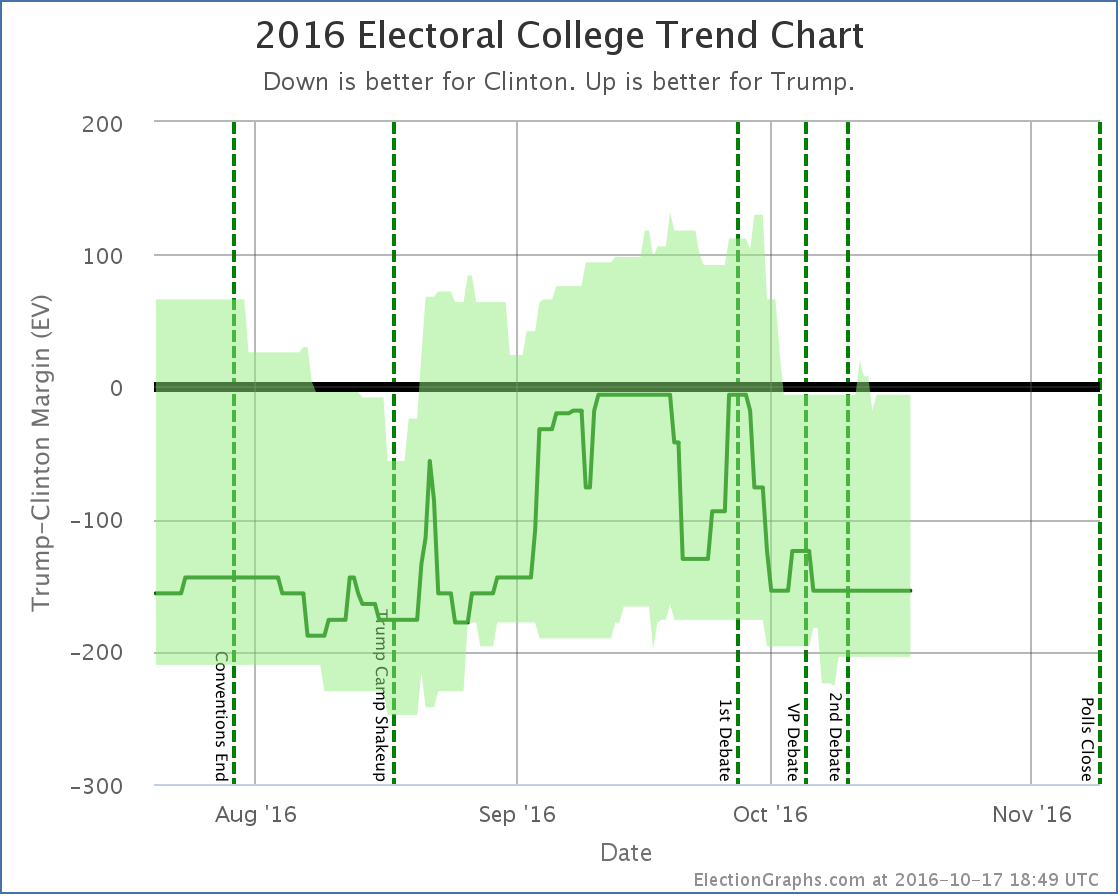

Both charts show a bit of improvement for Trump based on the last few days of polls.
Now, it might be wise to be cautious here. We are still going to get more polls covering this period. So these lines will move about some more. But it is also very possible that Trump hit his floor, and we’re now bouncing back a bit from that.
The public is very polarized. There is a percentage of Americans who will vote Democrat no matter what, and another percentage who will vote Republican no matter what. We may have seen both extremes of the how far things can change by those in the middle sloshing back and forth. If so, the extremes of this race go from a nearly tied race at Trump’s ceiling, to about a 188 electoral vote win for Clinton at her ceiling. Those are “expected case” numbers. In terms of the tipping point that translates into a Clinton lead of between approximately 0.5% and 6%.
Given recent news cycles and where things stand now, it currently seems as if a break through Trump’s floor is more likely than through his ceiling. As has been pointed out, a comeback from this far behind with this little time left would be unprecedented. But while it is possible that events may cause us to break out of that range, it seems very likely that when the votes come in on November 8th, we’ll find ourselves somewhere between those bounds.
But we shall see soon enough… 22.1 days left to go!
State Details
Moving out of Clinton’s reach

The general trend in Indiana has been a steadily weakening lead for Trump. But with the latest polls, the average pops up to a 5.9% Trump lead, so for now, Indiana is no longer in the “could go either way” category.
State that changed the tipping point

A note about McMullin
In the last week or two McMullin has spiked in Utah. Some individual polls show him within striking range of winning Utah. All of the current Election Graphs metrics and charts operate under the assumption that no third party has a realistic shot at winning electoral votes. I have had the outline of a contingency plan on how to modify the site to accommodate 3rd parties that might win electoral votes, but activating it would take quite a lot of work. If a 3rd candidate had gotten to that position a month or two ago, the site would definitely have been revamped to adjust for that possibility. As it is, there simply may not be time to do that before election day.
Right now the Real Clear Politics average in Utah, which includes McMullin, stands at Trump 31.8%, Clinton 25.5%, McMullin 22.8%, Johnson 8.8%, Stein 1.0%. (The Election Graphs Utah average currently stands at Trump 39.0%, Clinton 26.8%, but doesn’t yet include at least one poll that came out as this update was being finalized.) If and when the RCP average shows McMullin within 5% of the lead in the state, I will at the very least put notes at appropriate places on the site noting he has the possibility of winning 6 electoral votes. I will consider more substantial changes only if time allows.
For more information…
This post is an update based on the data on ElectionGraphs.com. Election Graphs tracks both a poll based estimate of the Electoral College and a numbers based look at the Delegate Races. All of the charts and graphs seen in this post are from that site. Additional graphs, charts and raw data can be found there. Follow @ElectionGraphs on Twitter or like Election Graphs on Facebook to see announcements of updates or to join the conversation. For those interested in individual general election poll updates, follow @ElecCollPolls on Twitter for all the polls as they are added. If you find the information in these posts interesting or useful, please consider visiting the tip jar.
Edit 22:51 UTC to add McMullin note.
|
|












































































